
¶ Introduction
In an organization such as a plant, drill rig, or even office block, an incident report or accident report is a form that is filled out in order to record details of an unusual event that occurred at the organization, such as an injury to a staff member or site contractor. The purpose of the incident report is to document the exact details of the occurrence while they are fresh in the minds of those who witnessed the event. This information may be useful in the future when dealing with liability issues stemming from the incident and when an investigation is launched
Generally, according to OHSAS guidelines, the report must be filled out as soon as possible following the incident (but after the situation has been stabilized). This way, the details written in the report are as accurate as possible.
Most incident reports that are written involve accidents with people. But most facilities will also document an incident in which a contractor or visitor is injured.
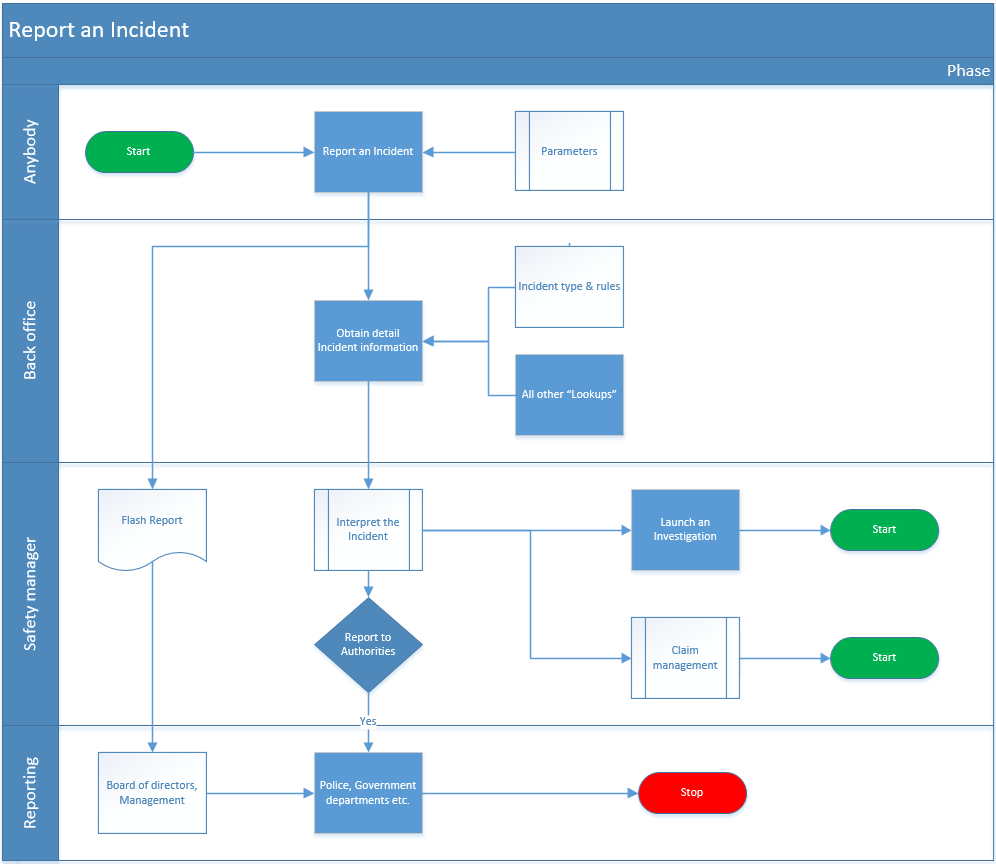
Typical (manual) Incident Report
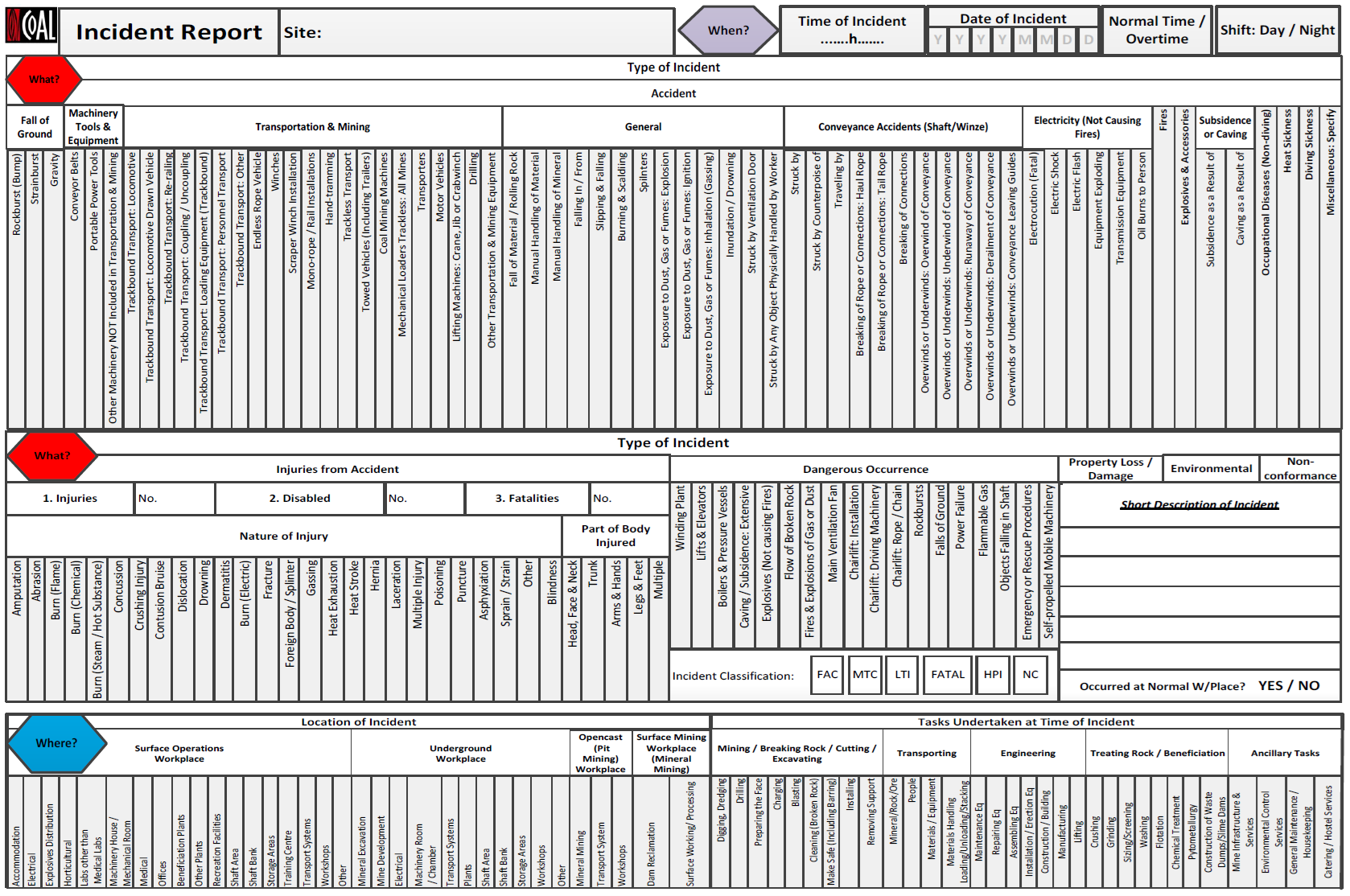
This is what a typical manual incident capturing report looks like. As can be seen it is a scary but comprehensive information gathering tool.
A better approach would be to use an electronic system.
¶ Navigation

¶ Specific setups
¶ Step 1: HSE Parameters
The statutory requirements for incident reporting are company and country specific and will be different to the data in the screenshots of this document. Refer to the section on the Local statutory wizard that will create “lookup” information.
Go to: HSE > Setups > HSE Parameters
- Click on the Incidents tab
- Select the fields to be displayed on the Incident form from the Remaining column and move them to the Selected column by using the < arrow button. (If fields need to be removed from the Selected column, use the > arrow)
- Click on the Update list button
- Select the default Site from the dropdown list
- Select the default Department from the dropdown list
- The Include external parties slider has to be set to Yes in order to include witnesses and visitors in incident summary calculations.
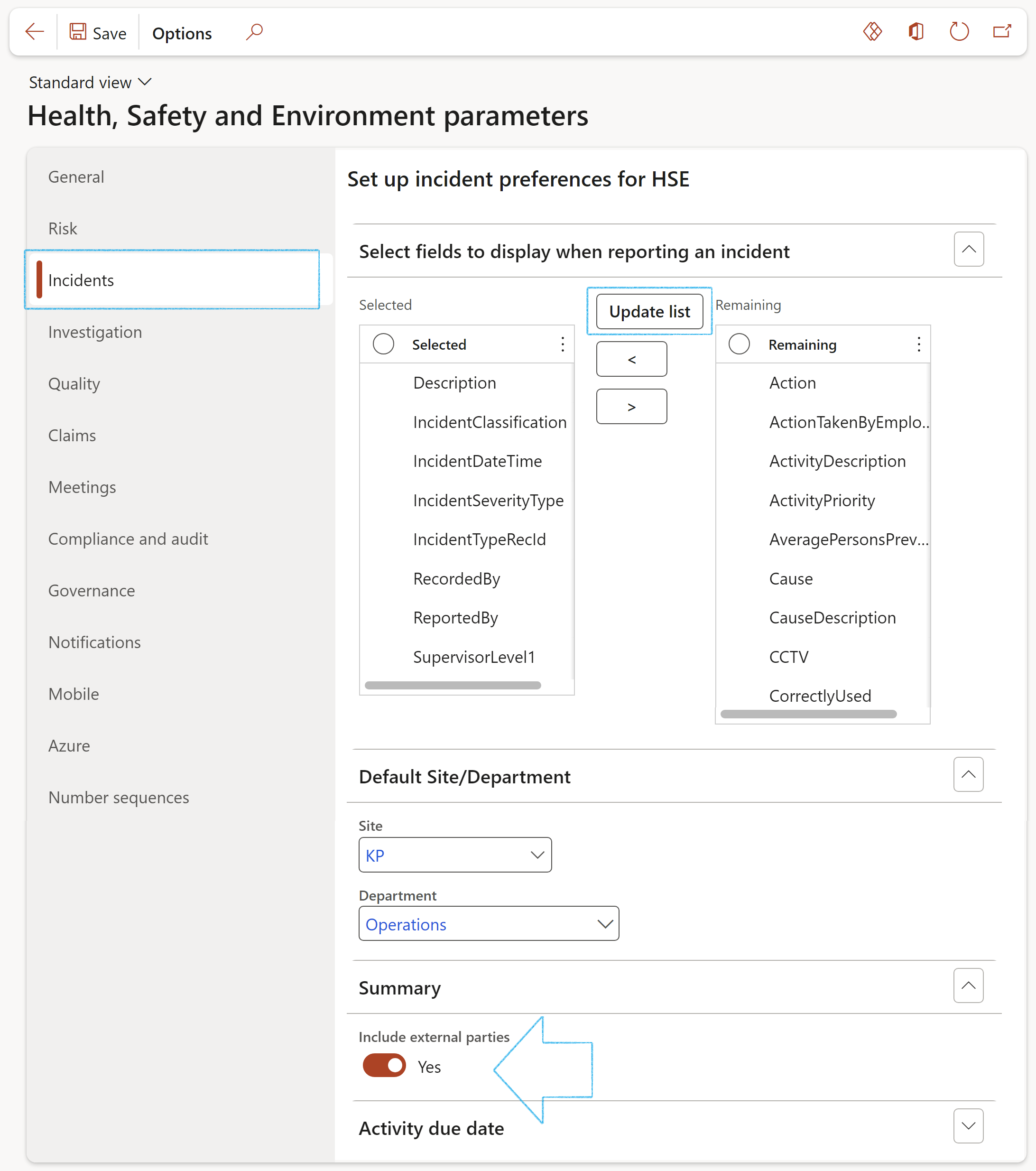
Email notifications can be created manually. Please refer to the Wiki page on Alerts and notifications
- Expand the Activity due date Fast tab
- In the Days field, enter the number of days to be added to the current date when calculating the activity due date
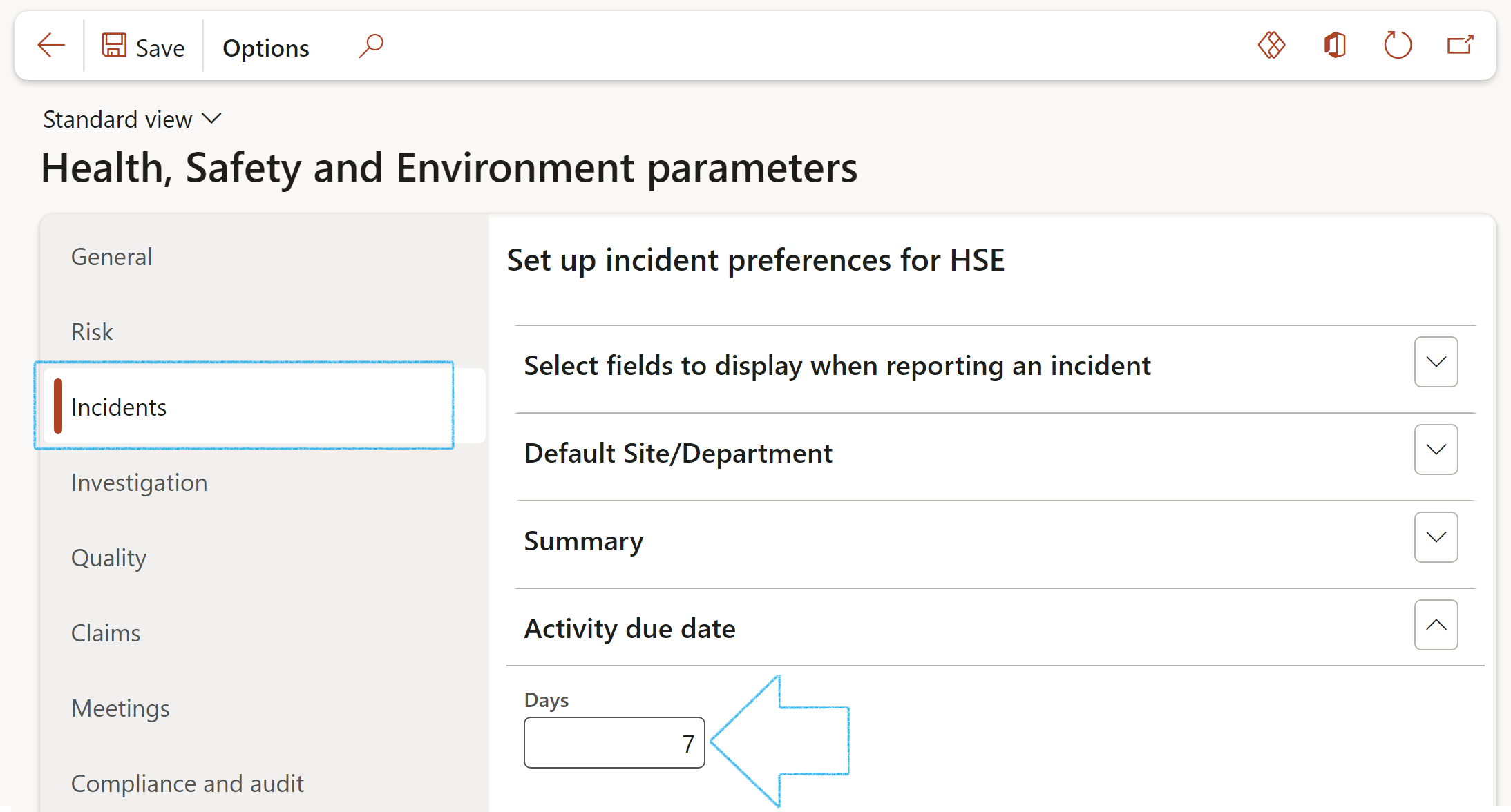
Please note that this is not the date on which an investigation is due to start.
- Click on the Investigation tab
- Under the Investigation level matrix size field group, select the required levels for Likelihood and Impact
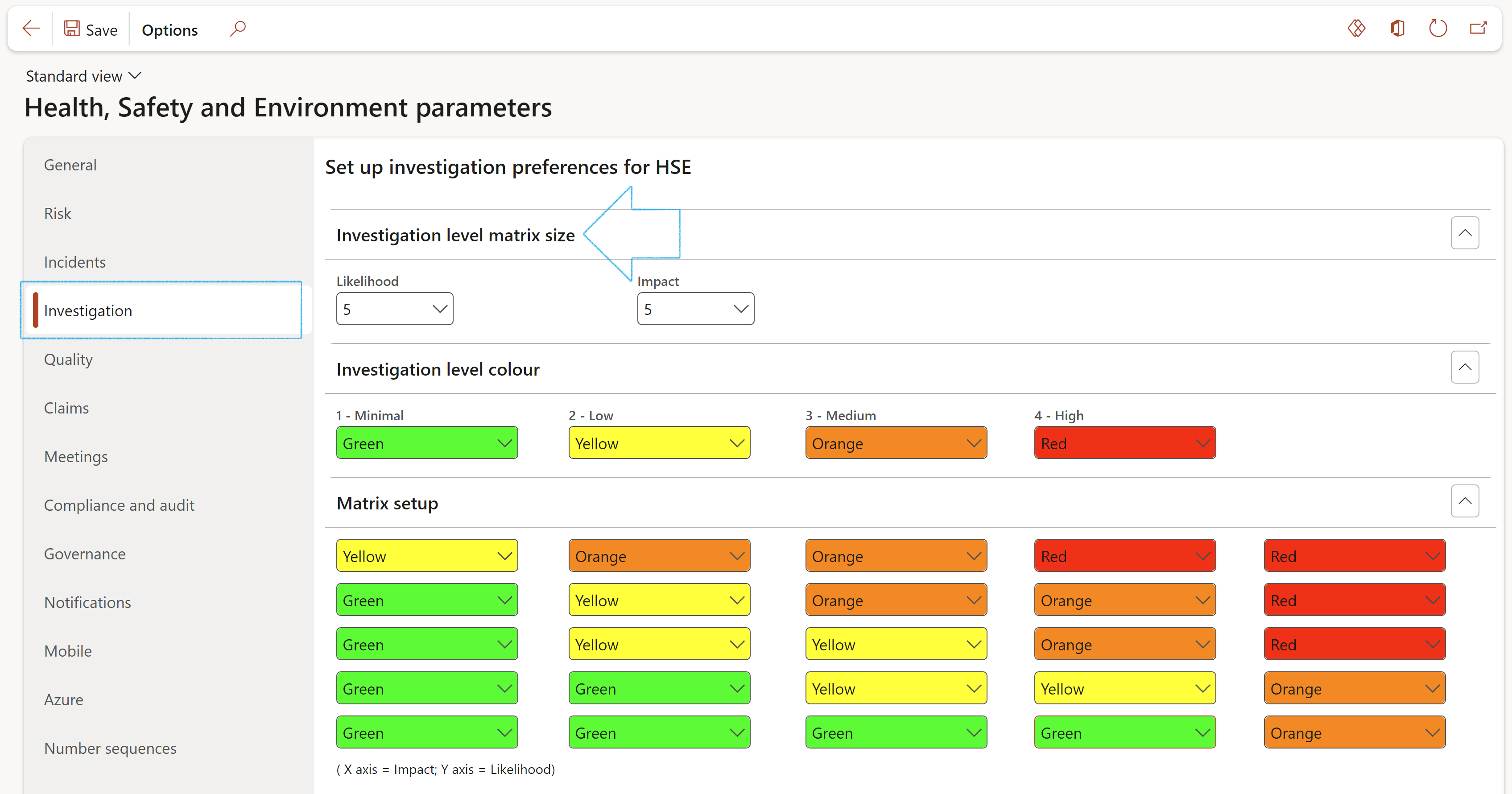
Alerts and notifications
To ensure proper compliance and uniform reporting of incidents, the following “lookup” information is needed.
¶ Step 2: Actions
Actions are the activities or chores that the people were busy with when the incident occurred. Where workers and other people are involved, it is useful to note what they were doing when the incident occurred.
Go to: HSE > Incidents > Setup for incidents > Actions: (injured or killed while…)
- Click on the New button
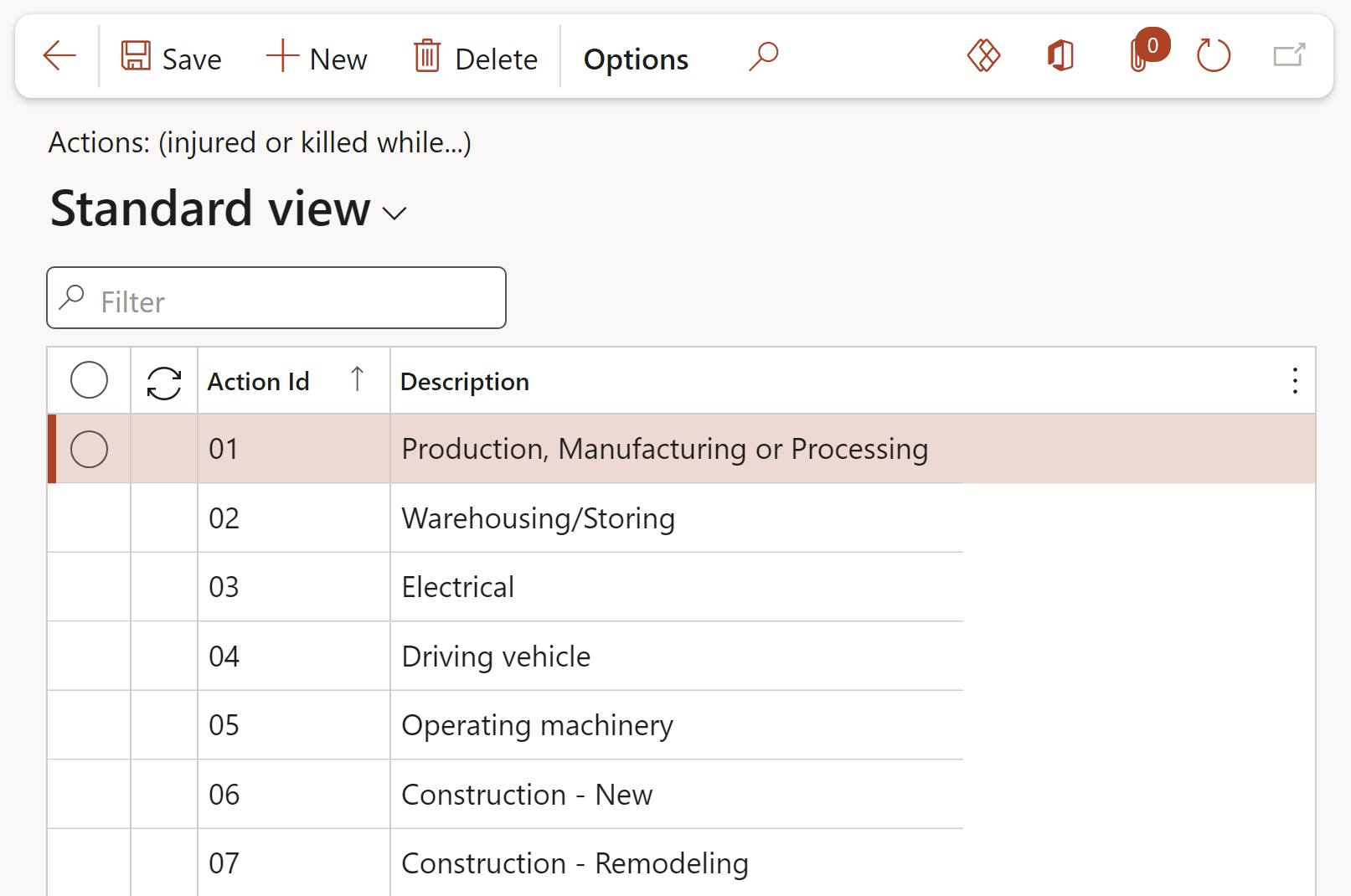
¶ Step 3: Create the Causes
Causes are the possible reasons of why things went wrong. These are used when recording an incident, and also when changing them during an investigation.
Go to: HSE > Incidents > Setup for incidents > Causes
- Click on the New button
- Add a Cause and Description
- Select the Parent if applicable
- If the tree node has to be selectable on defining an incident, move the Selectable slider to Yes

¶ Step 4: Define Nature of injury
The nature of injury or illness identifies the principal physical characteristic(s) of the injury or illness.
Go to: HSE > Incidents > Setup for incidents > Nature of injury
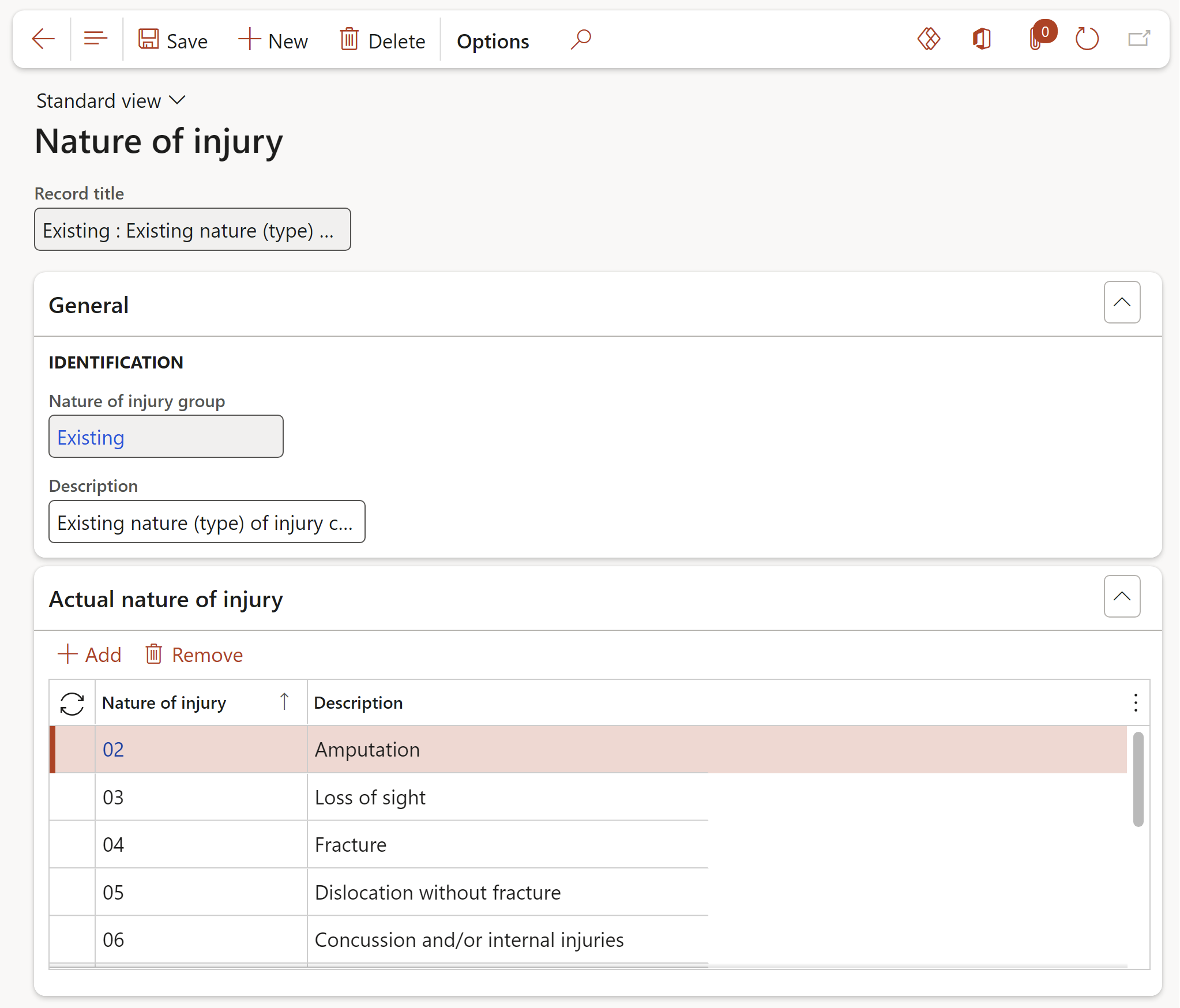
¶ Step 5: Specify the Injury and illness detail
To specify the Injury and illness details furthermore, the user should:
¶ Step 5.1: Define Injury of illness types
Go to: HSE > Incidents > Setup for incidents > Injury and illness setup
- Click on the Injury or illness types tab
- Click New
- Enter the Injury or illness type
- Enter a Description of the injury or illness type
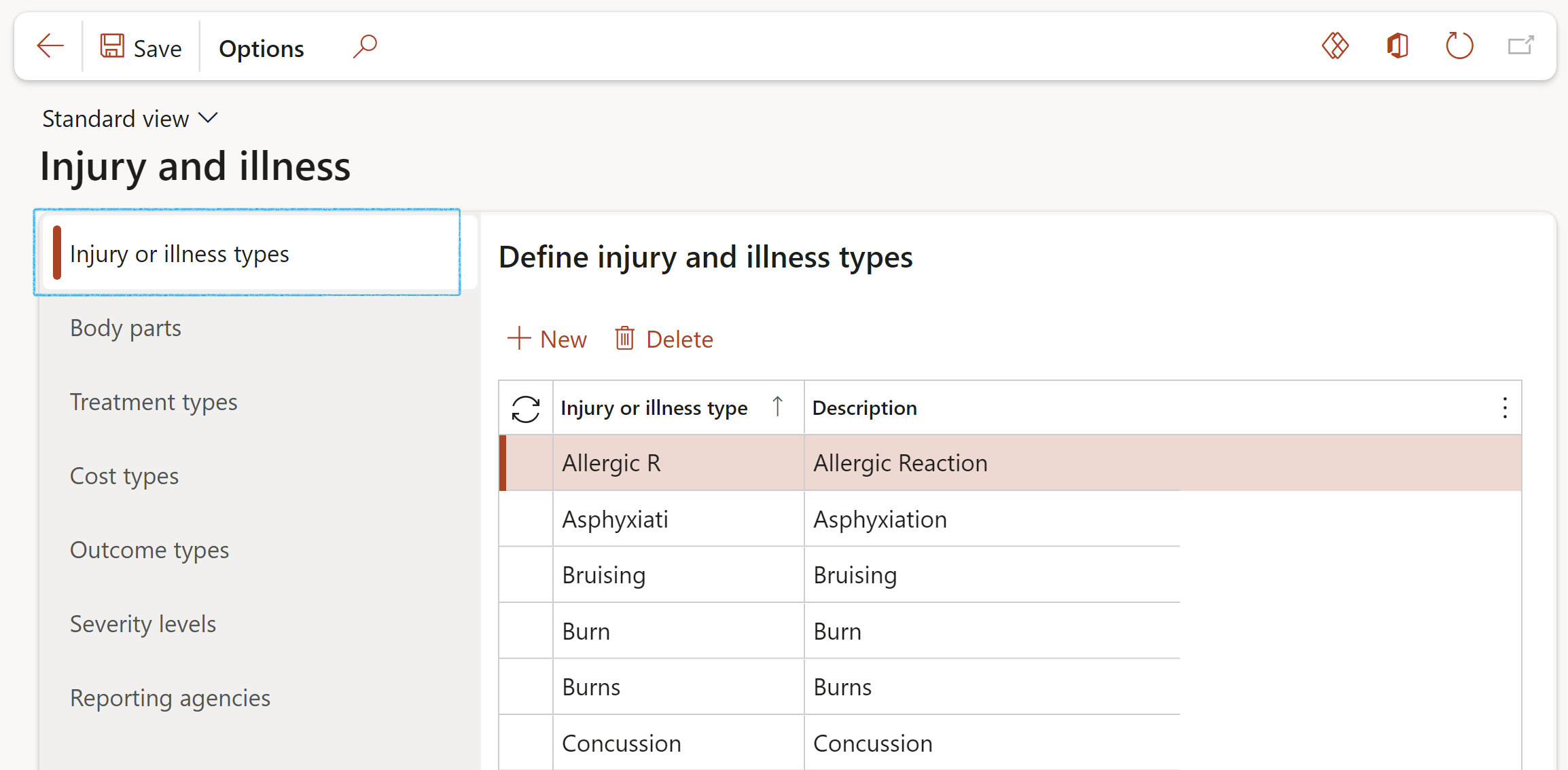
¶ Step 5.2: Define body parts
Go to: HSE > Incidents > Setup for incidents > Injury and illness setup
- Click on the Body parts tab
- Click New
- Enter the Body part
- Enter a Description of the body part
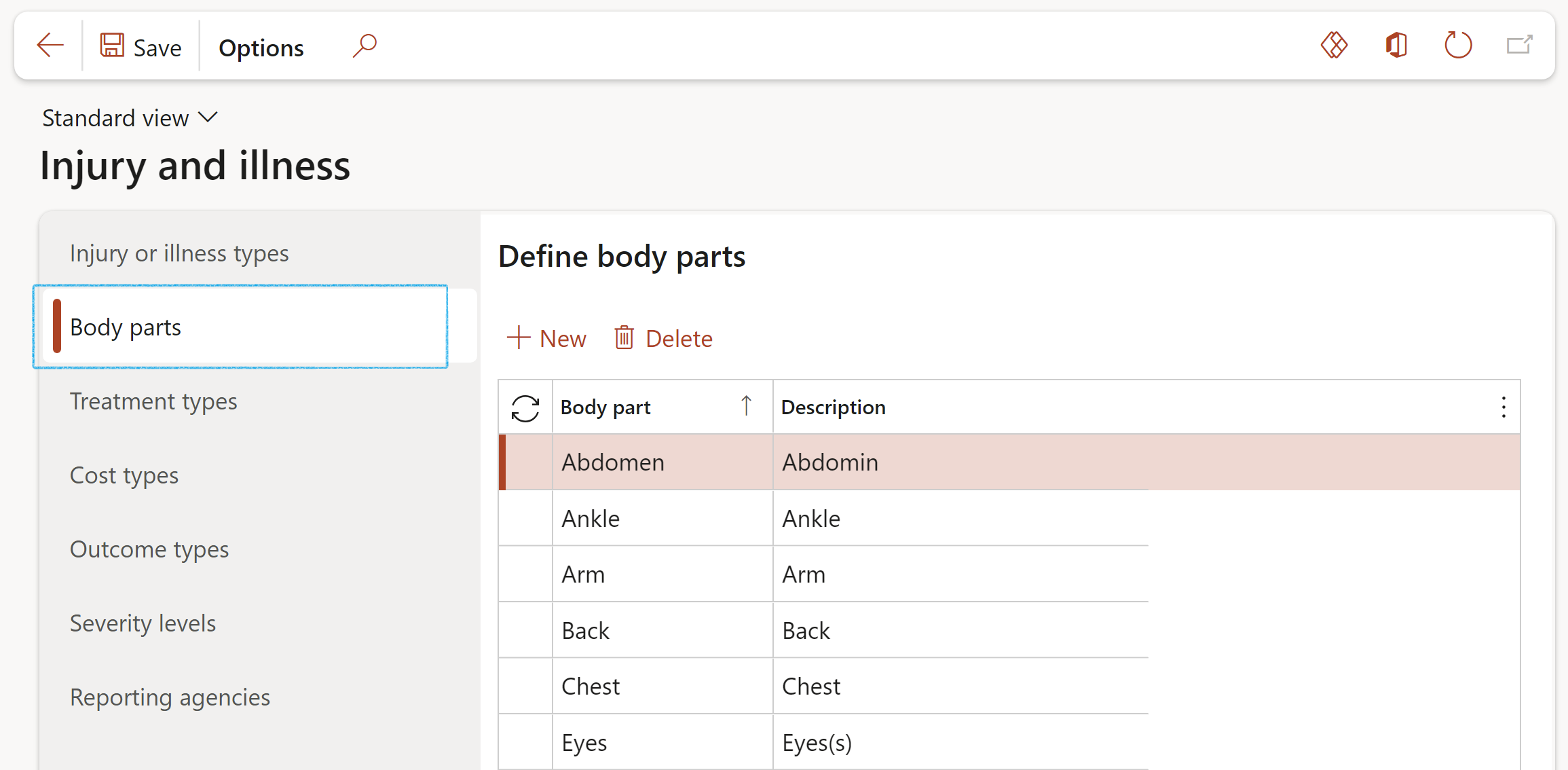
¶ Step 5.3: Define treatment types
Go to: HSE > Incidents > Setup for incidents > Injury and illness setup
- Click on the Treatment types tab
- Click New
- Enter the Treatment type
- Enter a Description of the treatment type
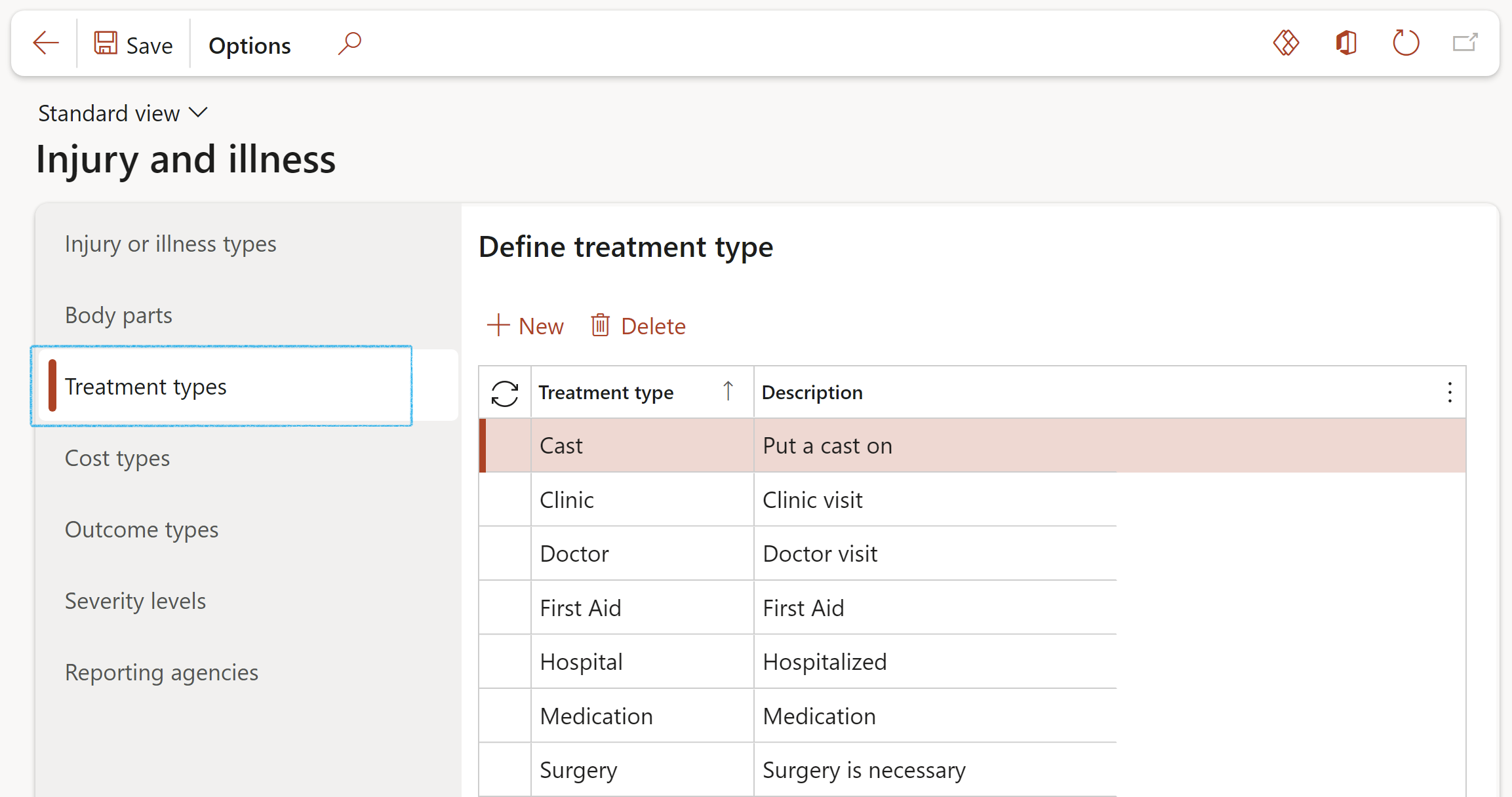
¶ Step 5.4: Define cost types
Go to: HSE > Incidents > Setup for incidents > Injury and illness setup
- Click on the Cost types tab
- Click New
- Enter the Cost type
- Enter a Description of the cost type
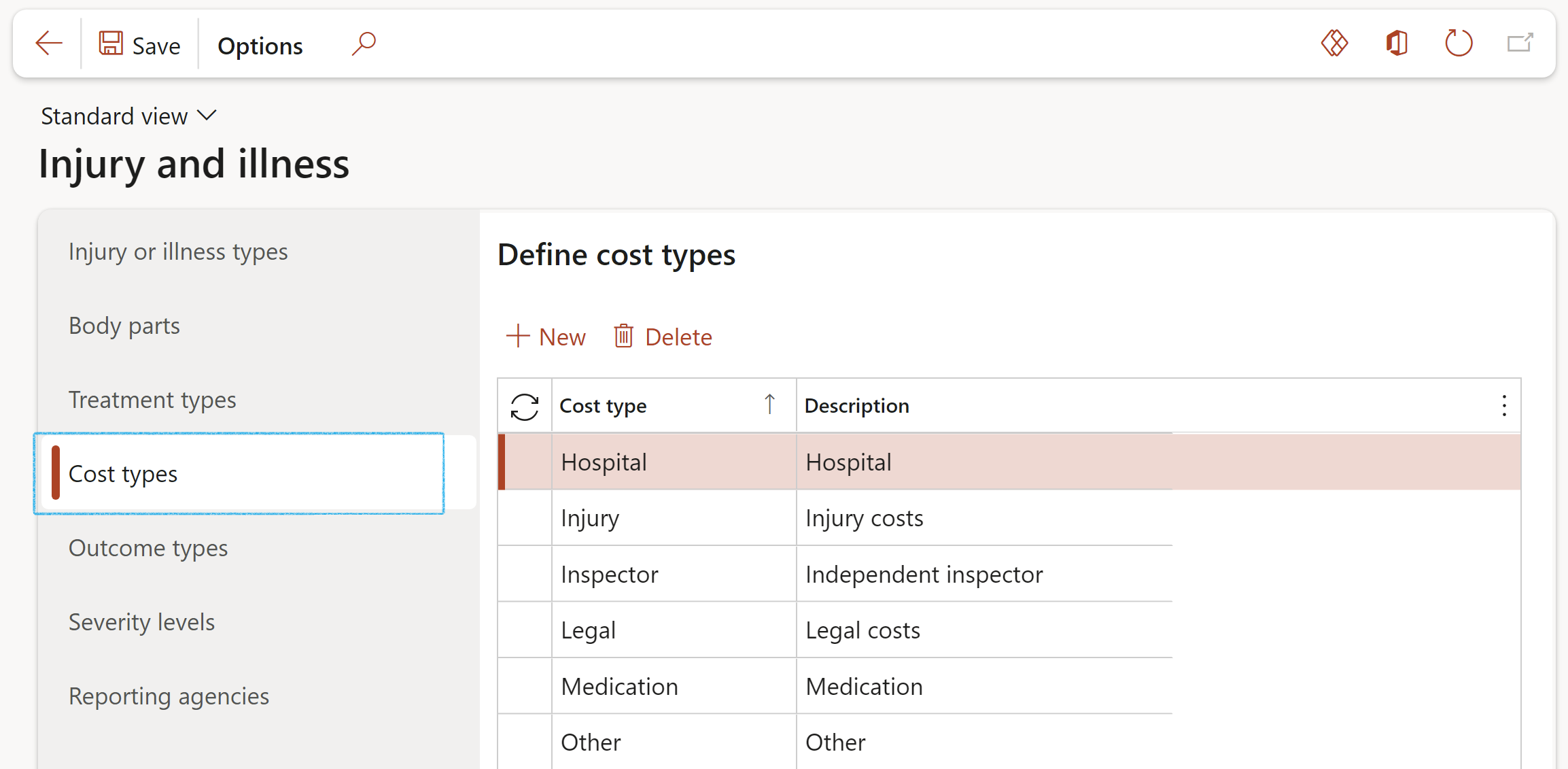
¶ Step 5.5: Define outcome types
Go to: HSE > Incidents > Setup for incidents > Injury and illness setup
- Click on the Outcome types tab
- Click New
- Enter the Outcome type for the injury or illness
- Enter a Description of the injury or illness outcome type
- Select the relevant Result from the dropdown list
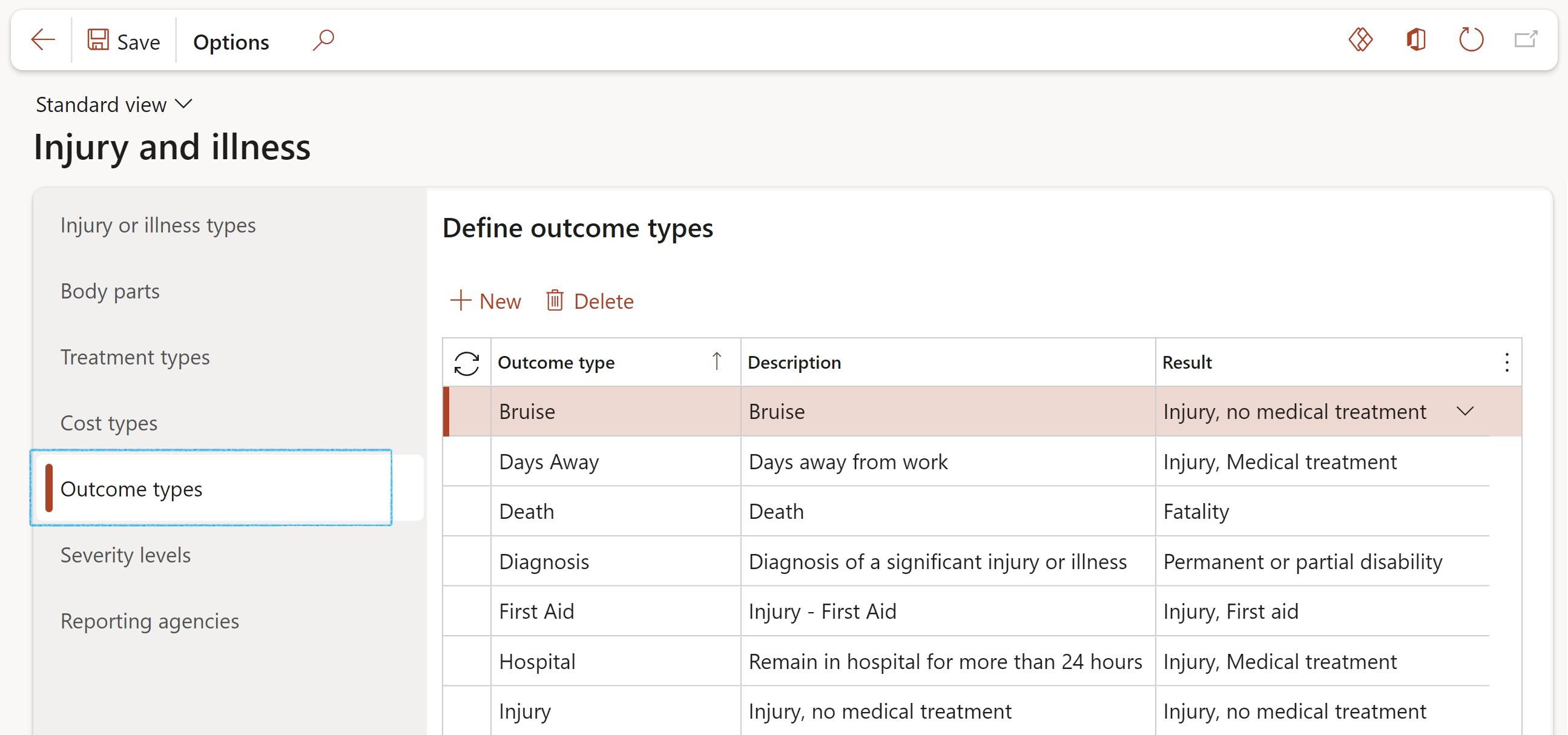
If the Result is not populated, the Persons injured field, under the Summary field group on the Incident, will not be updated.
¶ Step 5.6: Define severity levels
Go to: HSE > Incidents > Setup for incidents > Injury and illness setup
- Click on the Severity levels tab
- Click New
- Enter the Severity level for the injury or illness
- Enter a Description of the injury or illness severity level
- Select the relevant Severity ID from the dropdown list
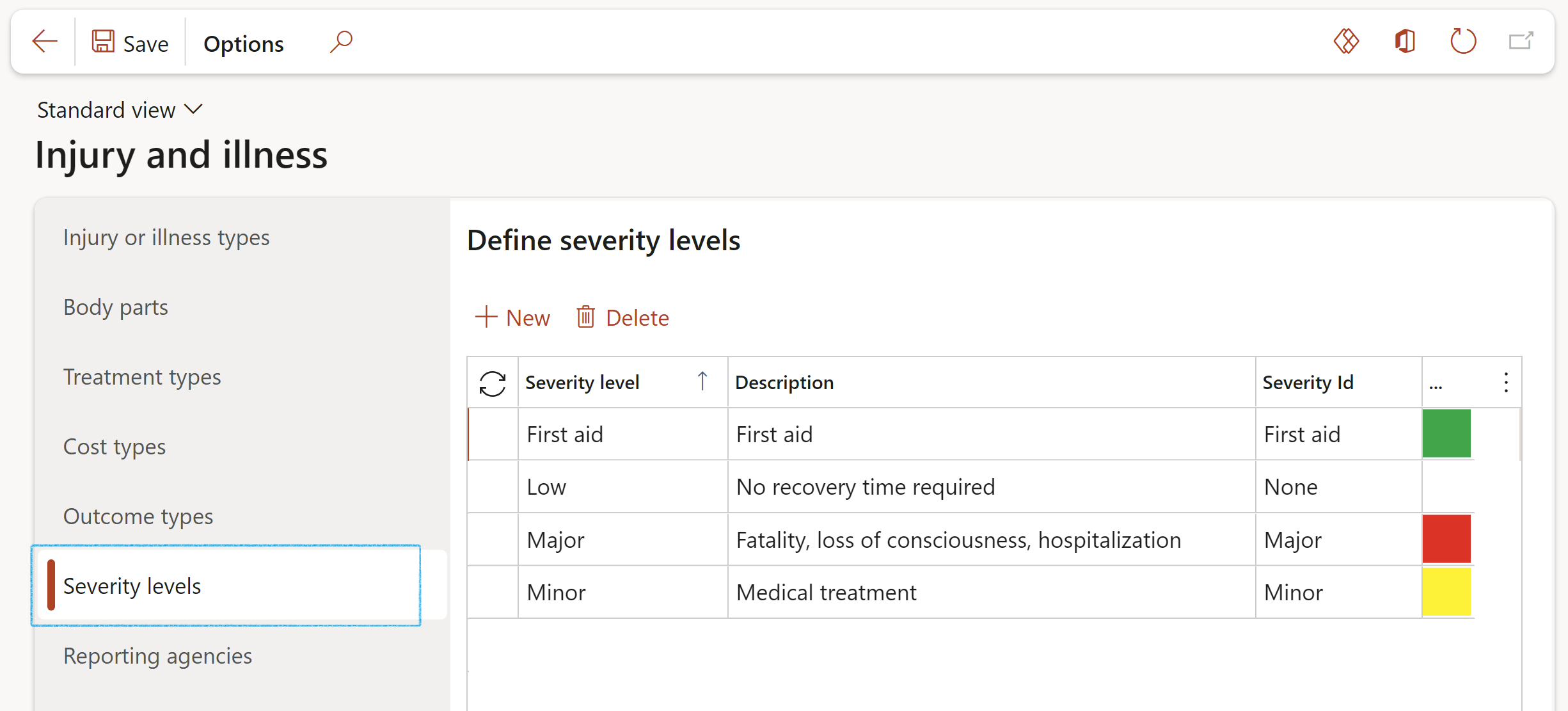
¶ Step 5.7: Define reporting agencies
Go to: HSE > Setup for incidents > Reporting agencies
- In the Action pane, click on the New button
- Enter the name of the Reporting agency
- Enter a brief Description of the reporting agency
- Select the Contact person for the reporting agency from the drop-down list
- Mark the Default checkbox if you would like the reporting agency to be automatically assigned to an injury and illness incident that is a compliance recordable case
- In the button strip, click on the Add button
- Enter the Reporting category linked to the selected reporting agency
- Enter a brief Description of the reporting category

¶ Step 6: Define Unsafe acts and conditions
ISO 9001:8 requires that organizations formally document what went wrong, and what corrective actions are taken to ensure better quality. This is known as a “Non-conformance”.
Non-conformances may be found in a service, a product, a process, from a supplier, or in the system itself. It occurs when something does not meet the specifications or requirements in some way. Those requirements might be defined by the customer, a regulatory body, or in the internal procedures of the company.
Proper incident reporting allows for the recording of non-conformance codes.
A non-conformance is created from the Findings button on the Investigation form. The information used to create the finding is from the Unsafe acts and conditions memo field. For more information, refer to Investigations.

Go to: HSE > Incident > Setup for incidents > Unsafe acts and conditions
- On the Action pane, click on the New button
- Enter the unique Unsafe acts and condition ID
- Enter a brief Description of the Unsafe acts and condition
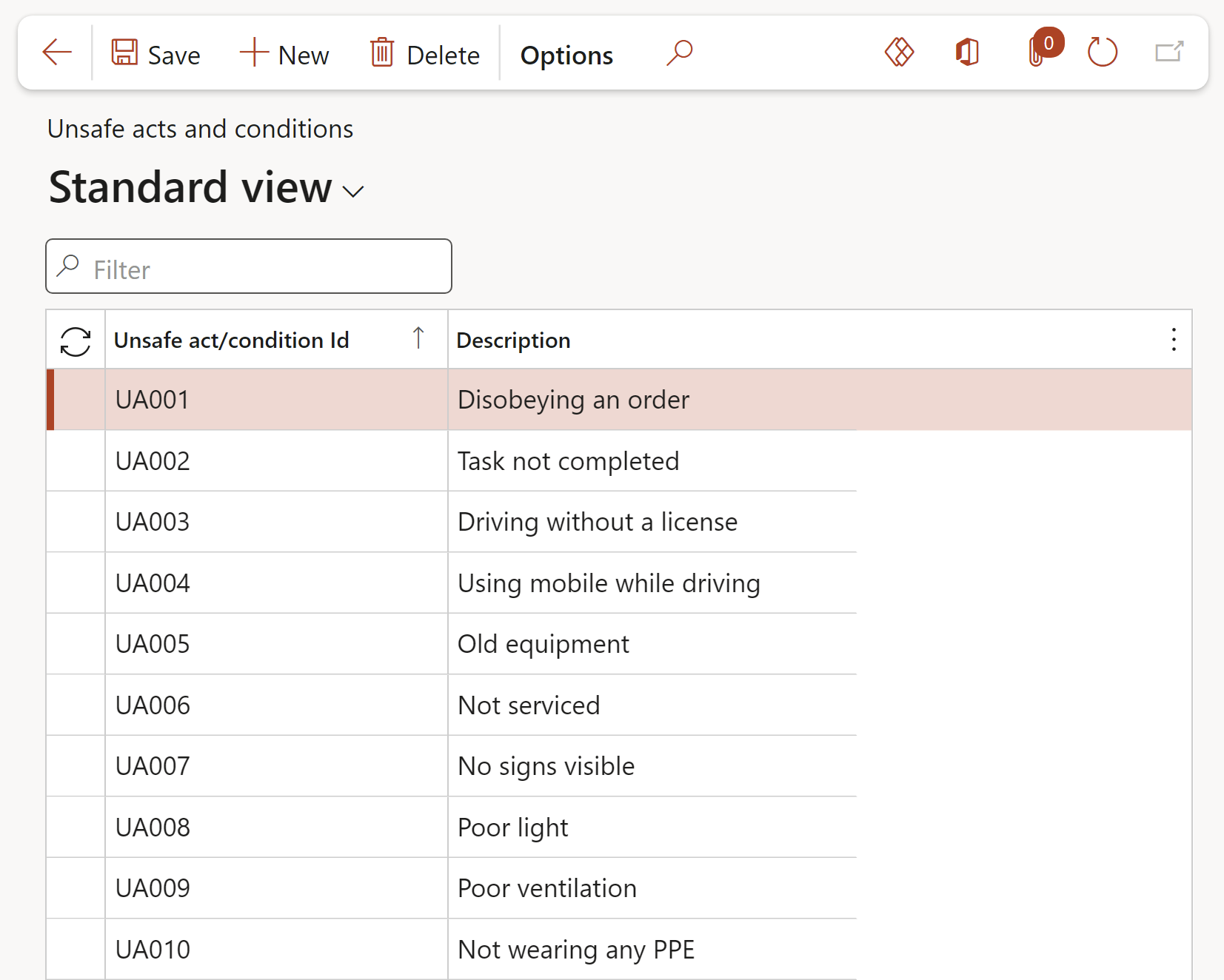
¶ Step 7: Enter the Incident classifications
On a high-level, incidents are grouped into two categories: reportable (to authorities), and non-reportable (internal use only). It is wise to classify incidents further into types so that appropriate actions can be taken. These types are known as Incident classifications.
Go to: HSE > Incident > Setup for incidents > Incident classification
- On the Button strip, click New
- Enter the classification of the incident
- Enter a brief Description of the incident classification
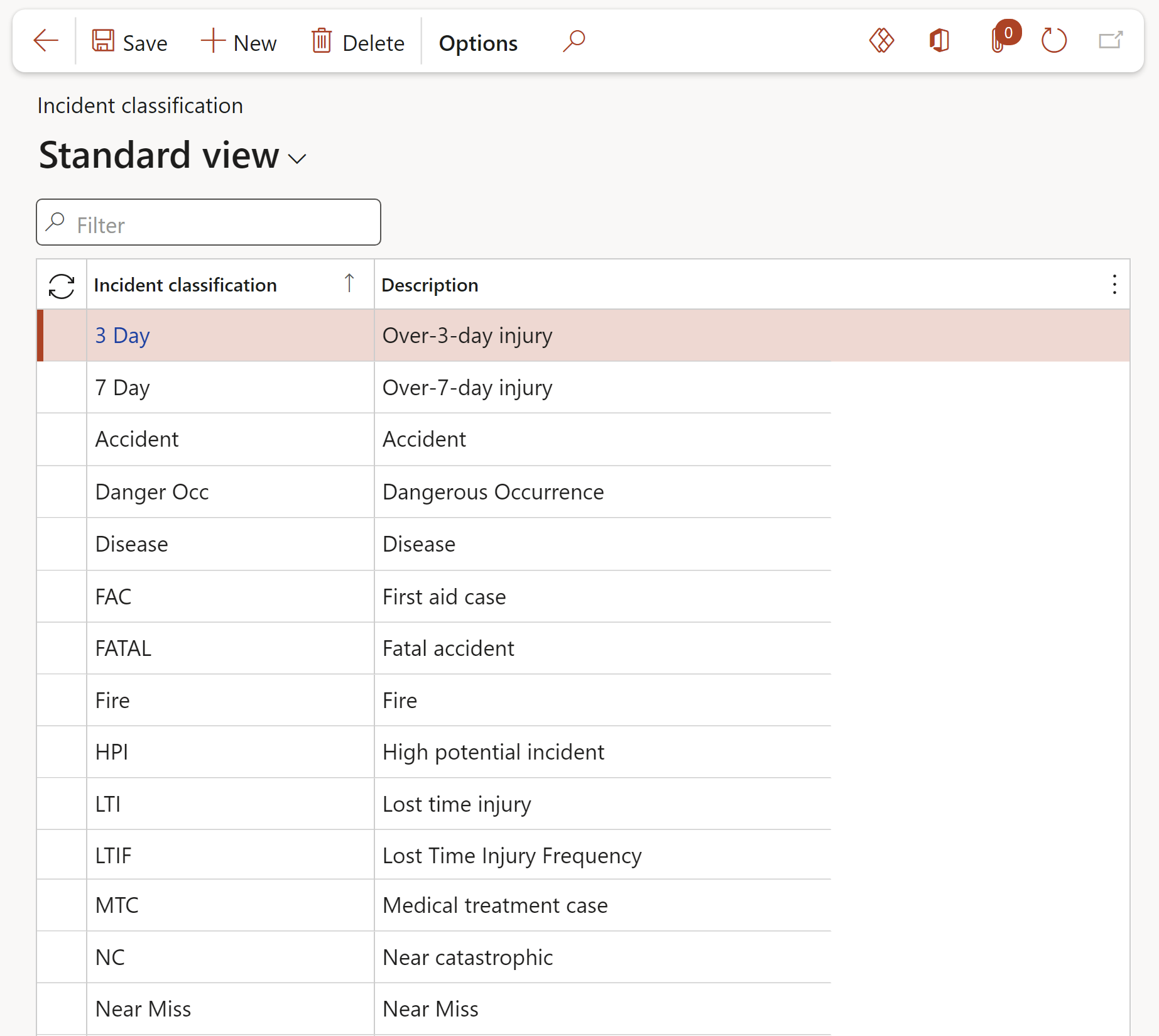
This useful guide shows typical classifications:
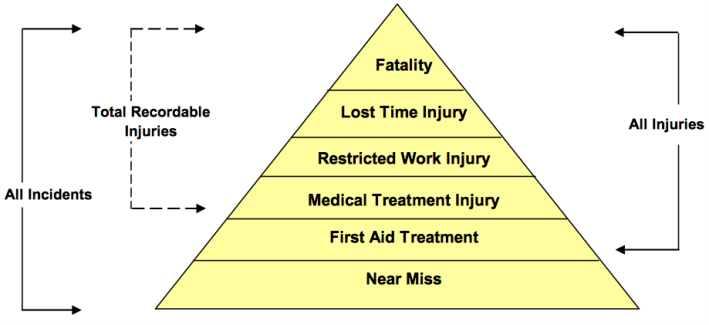
¶ Step 8: Enter the Accident classification codes
Accident classification is a standardized method by which the causes of an accident, including the root causes, are grouped into categories. Accident classification is well known in aviation but is expanded into other areas, such as railroad or health care.
Go to: HSE > Incident > Setup for incidents > Accident classification
- On the Action pane, click New
- Enter the relevant details of the Accident classification
- If the Accident classification should be selectable on the Incident detail form, move the Selectable slider to Yes
- To create the Tree view: If this Accident classification belongs to a certain “group” then, in the Parent field, select the relevant Accident classification from the dropdown list
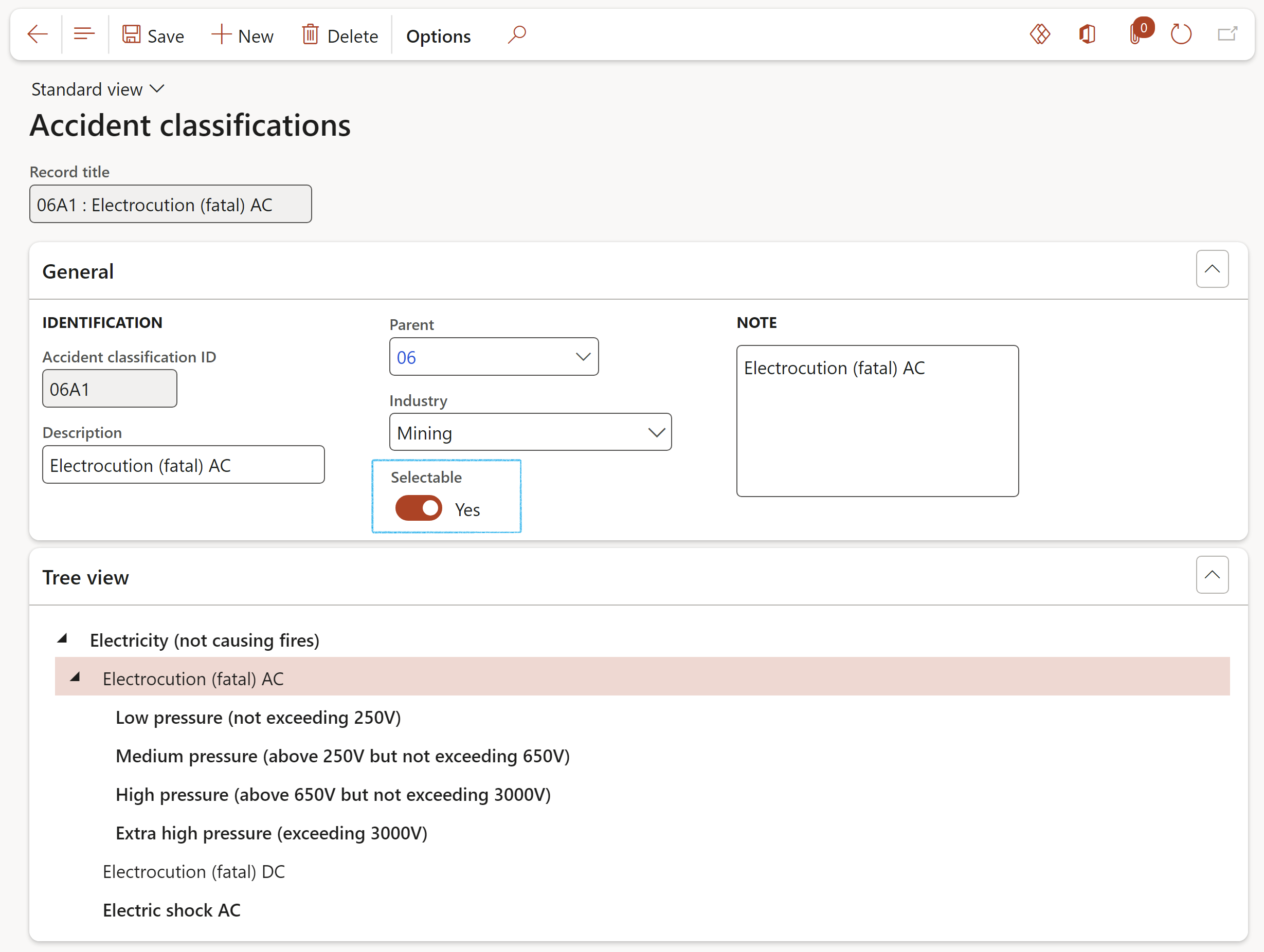
¶ Step 9: Define Dangerous occurrence classification codes
A dangerous occurrence is an unplanned and undesired occurrence (incident) which has the potential to cause injury, and which may or may not cause damage to property, equipment or the environment.
Go to: HSE > Incident > Setup for incidents > Dangerous occurrence classification
- On the Action pane, click on the New button
- Enter the relevant details of the Dangerous occurrence classification
- Use the Selectable slider to indicate whether the tree node will be selectable on defining an incident
- To create the Tree view:
If this Dangerous occurrence classification belongs to a certain “group” then, in the Parent field, select the relevant Dangerous occurrence classification from the dropdown list
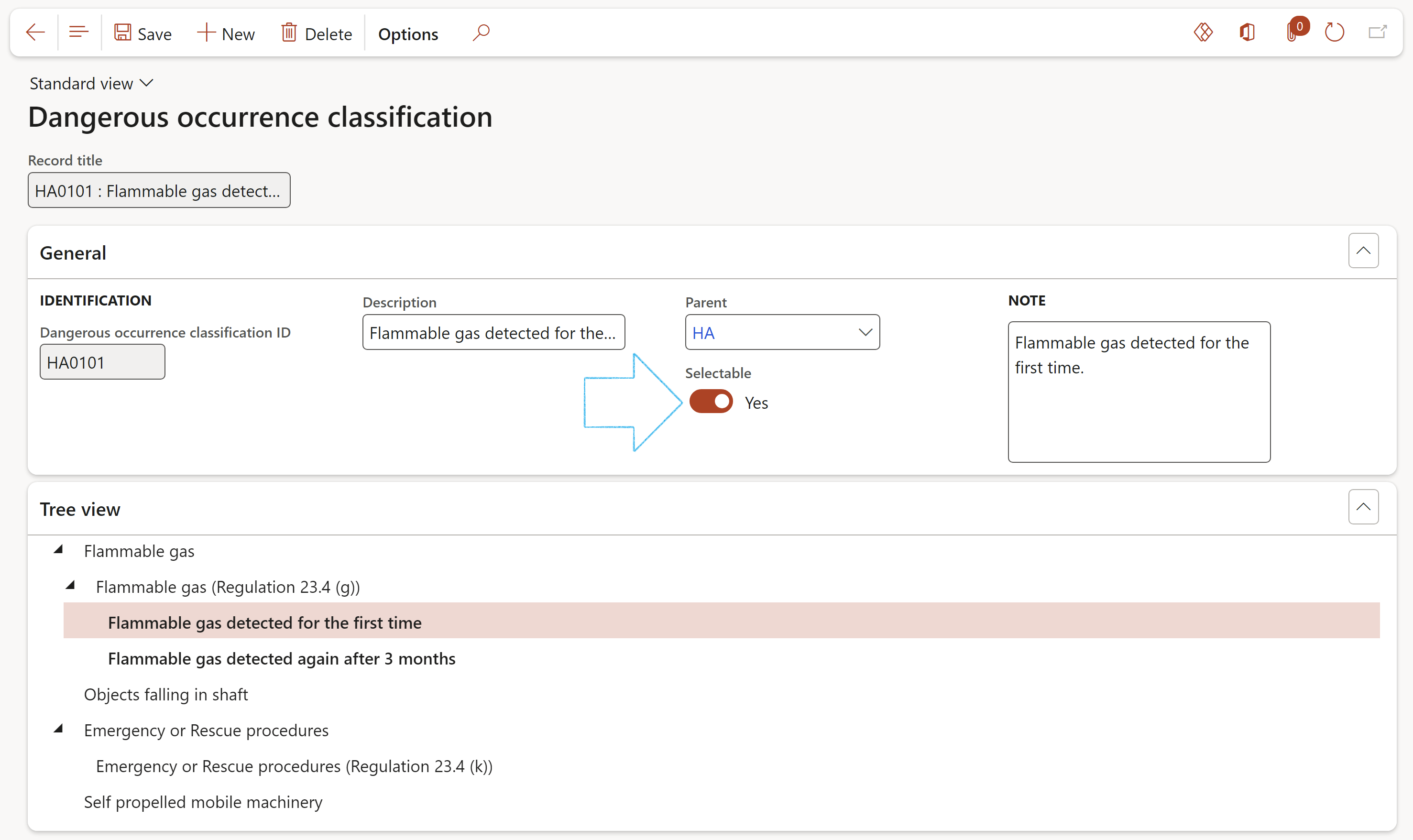
¶ Step 10: Create local statutory content
Above we have described all the needed setup data. To setup the data could prove to be a laborious task. A “short cut” exists. Dynamics 365 HSE has a default data wizard.
Go to: HSE > Setup > Create local statutory content
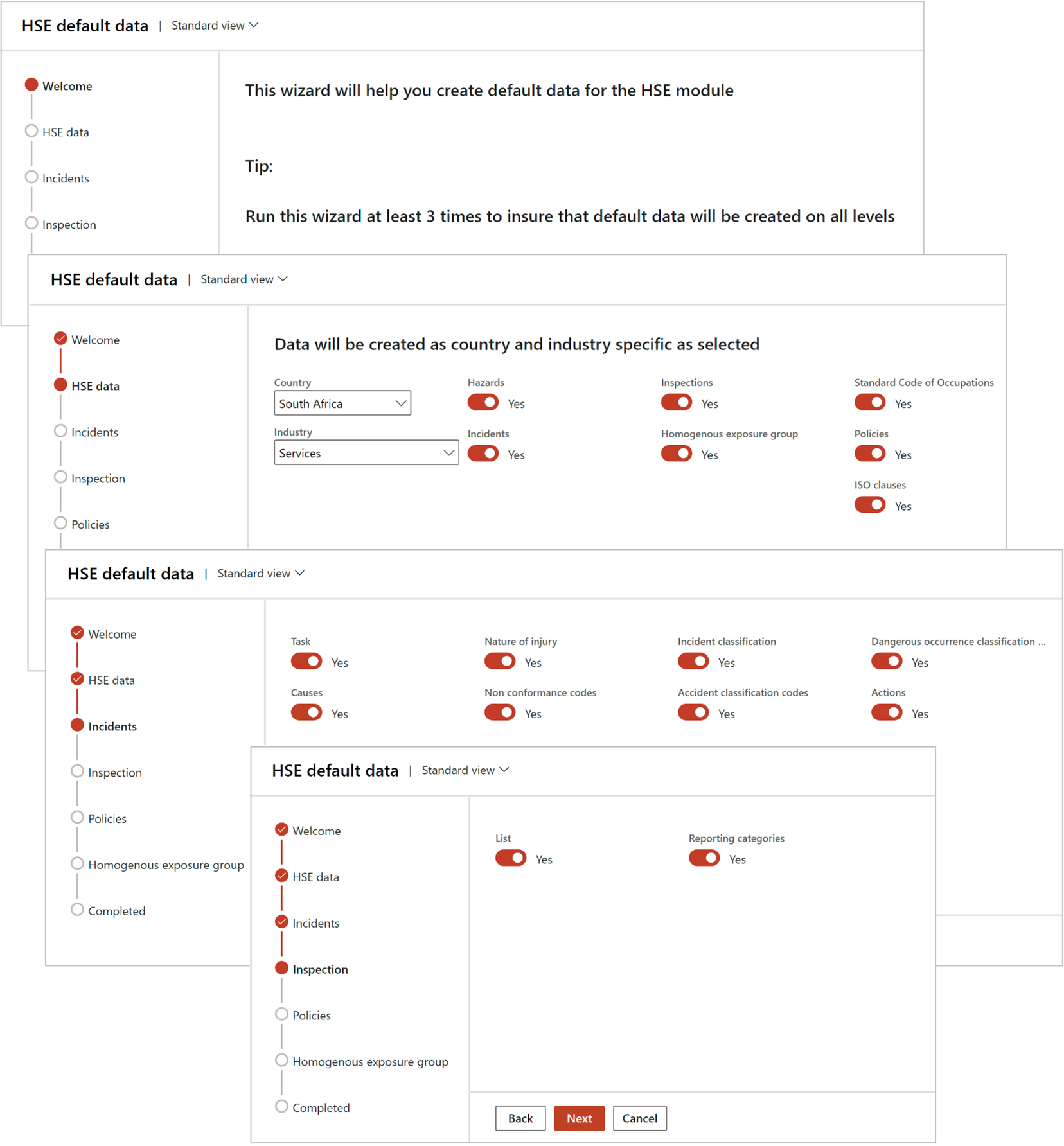
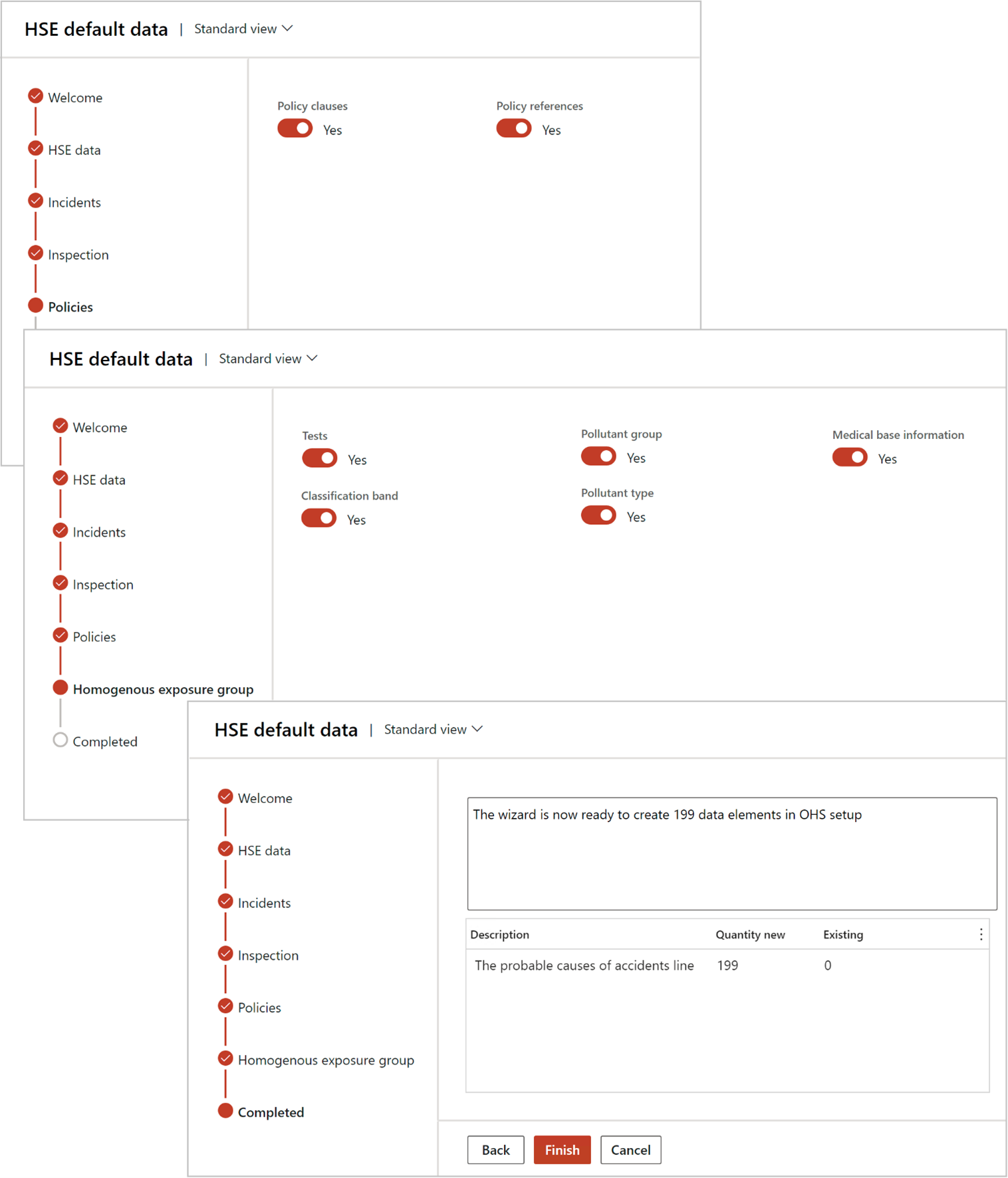
The outcome from running the wizard, is that a consistent and legally accurate set of reporting lookup data is made available to the users. All the previous setups dealt with incident reporting content (“Lookups”). The final setups relate to user experience.
The logged in user has to be in the Admin user group as selected on the HSE parameters, General tab, under the Other Fast tab
¶ Step 11: Incident type and Incident rules
Incident type
When users record an incident, the first item to report on involves the type of incident. When a type is selected, users will have more or less fields to enter data into.
For example: Type Environmental will allow access to the Environmental button.
Go to: HSE > Incident > Setup for incidents > Incident type
- Under the Incident type Fast tab:
- Click on the Add button
- Enter the unique Incident type ID
- Enter a brief Description for the Incident type
- Select the relevant Incident type from the dropdown list
- Indicate whether the incident type should be Selectable when an incident is reported
- Under the Incident type specific setup Fast tab:
- Select the relevant Incident rule from the dropdown list
- Select the relevant Questionnaire (if applicable)

The Questionnaire field is used for the investigation methodology, for example: ICAM, RCAT and Fishbone
Incident rules
Incident rules give super users “power” over which fields to show/hide on the Incident detail form. Using these rules with Type (see previous page), the user will be presented with only the relevant fields. These fields are setup under incident rules, each incident type will have different rules reflecting different number of fields.
Go to: HSE > Incident > Setup for incidents > Incident rules
- In the Action pane, click on the New button
- Under the General Fast Tab:
- In the Incident rule field, enter a unique incident ID
- Enter a brief Description of the incident rule
- Under the Setup Fast tab:
- Click on the Update list button
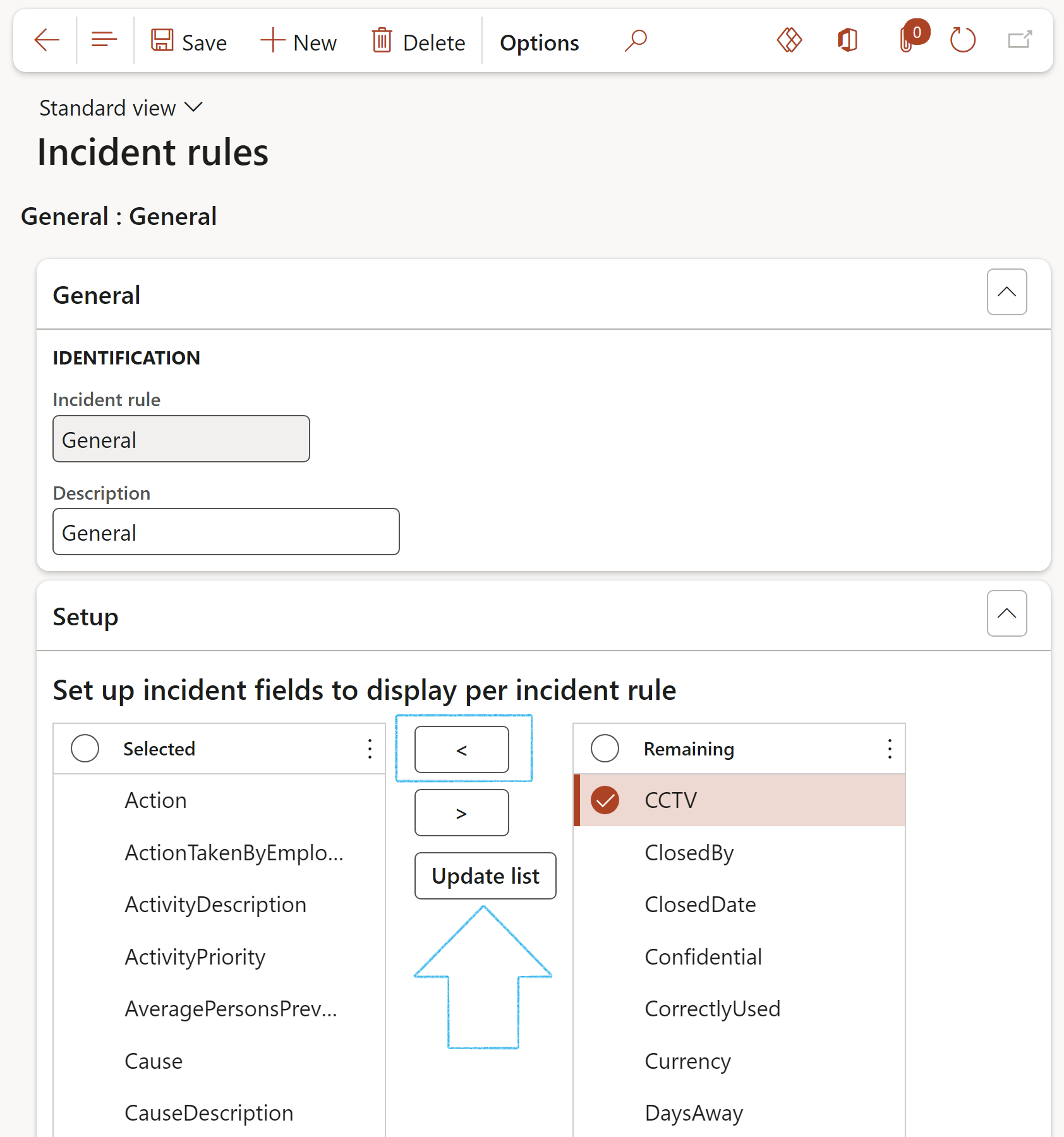
Select the fields to be displayed on the Incident detail form from the Remaining column and move them to the Selected column by using the < arrow button.
(If fields need to be removed from the Selected column, use the > arrow)
Use the Shift key to select multiple fields.
The Incident detail form will display the fields in the Selected box.
¶ Step 12: Setup Life saving rules
The Permit to work types setup form is used to create Life saving rules
Go to: HSE > Permits to work > Setup for permits to work > Permit to work types
- In the Action pane, click on the New button
- Enter a unique Permit to work ID
- Enter a brief Description of the Permit to work
- Select the relvant Type from the dropdown list
- Tick the Active check box
- Tick the LSR check box
The LSR box has to be checked for the rule to be selectable on the Incident
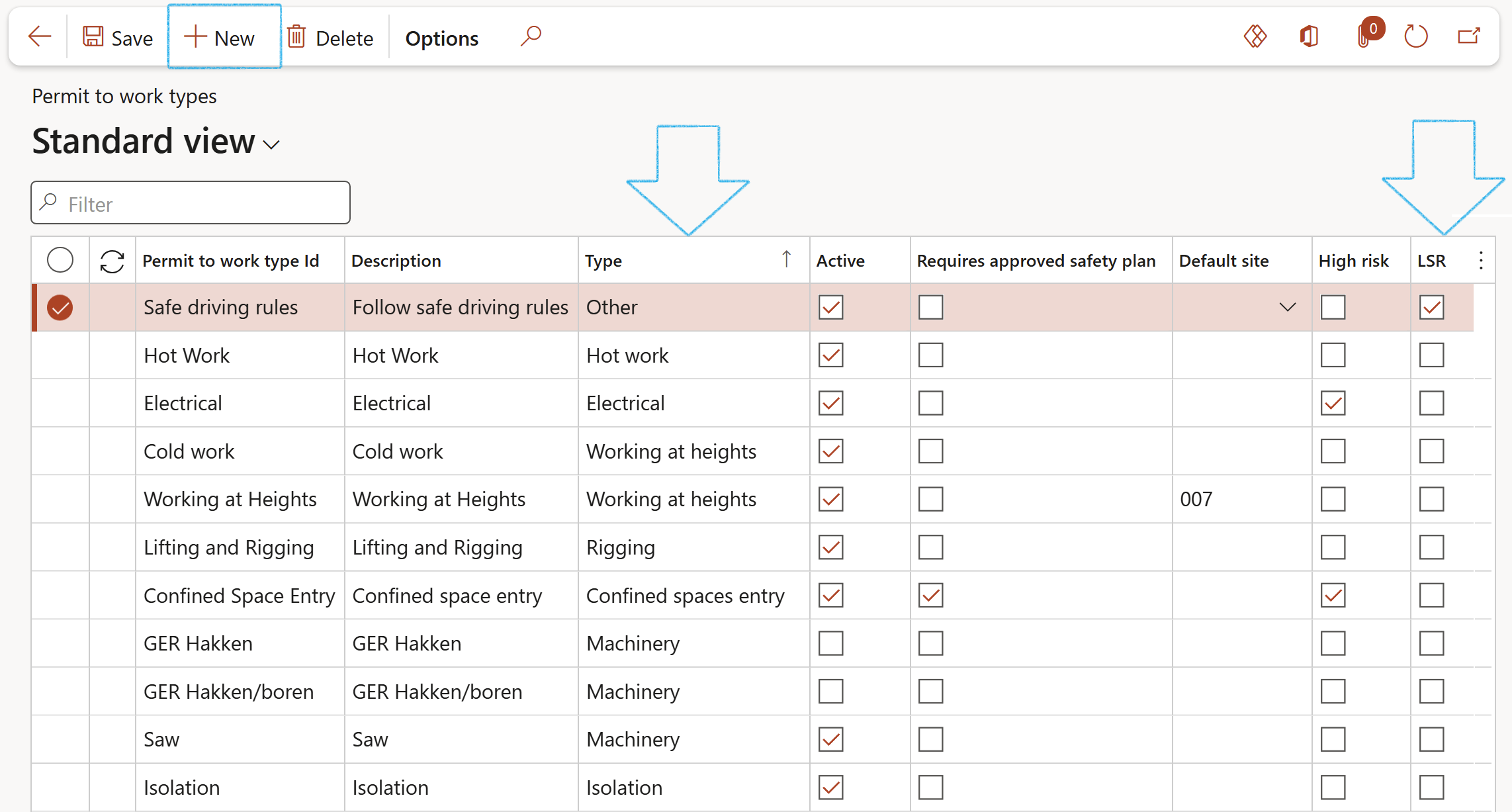
¶ Step 13: Setup the Work location
The final component in the setup chain involves the Work location link. The definition of the work location includes Section and Place.On the lowest of the 3 levels, the user can choose to map the workplace to standard Dynamics 365 Work centre/resource of type location.
Go to: HSE > Setup > Work location > Locations
- In the Action pane, click on the New button
- Enter the Location ID
- Enter a brief Description of the location
- Select the Site of the location from the dropdown list
- Select the Parent location (HSE) from the drop-down list, if applicable
- Move the Active slider to Yes if the location should be selectable when an incident is reported
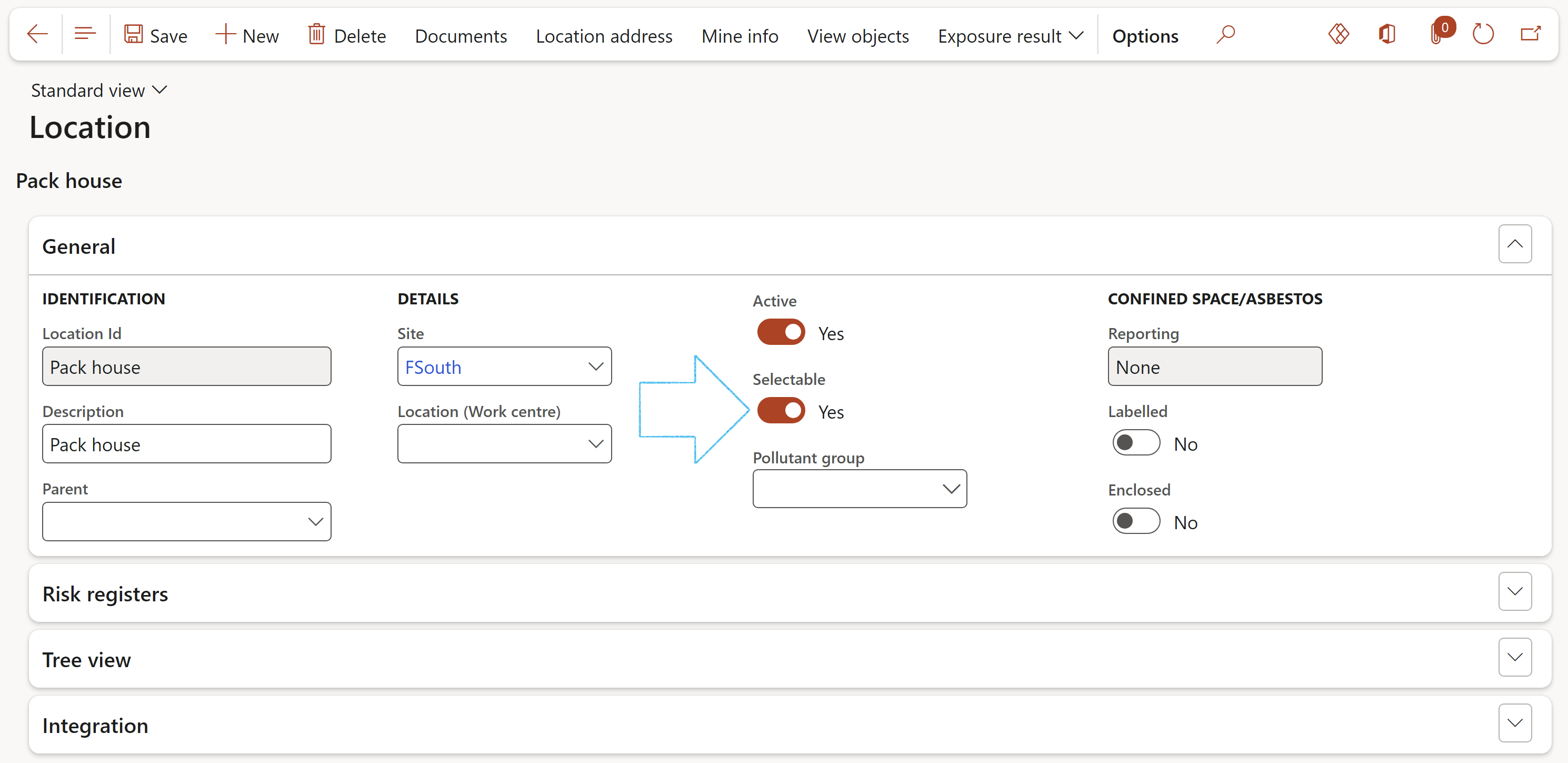
Where "Active" = Yes is selected on a location, this location will be displayed on the Location dropdown list on all HSE and GRC forms where Locations can be selected.
¶ Step 14: Setup Claim types
Go to: HSE > Incidents > Setup for incidents > Claim types
- On the Action pane, click the on New button
- Enter the Claim type name
- Enter a brief Description of the claim type
- In the Type field, select the relevant category of the claim type
- Select the relevant Action and question group from the dropdown list
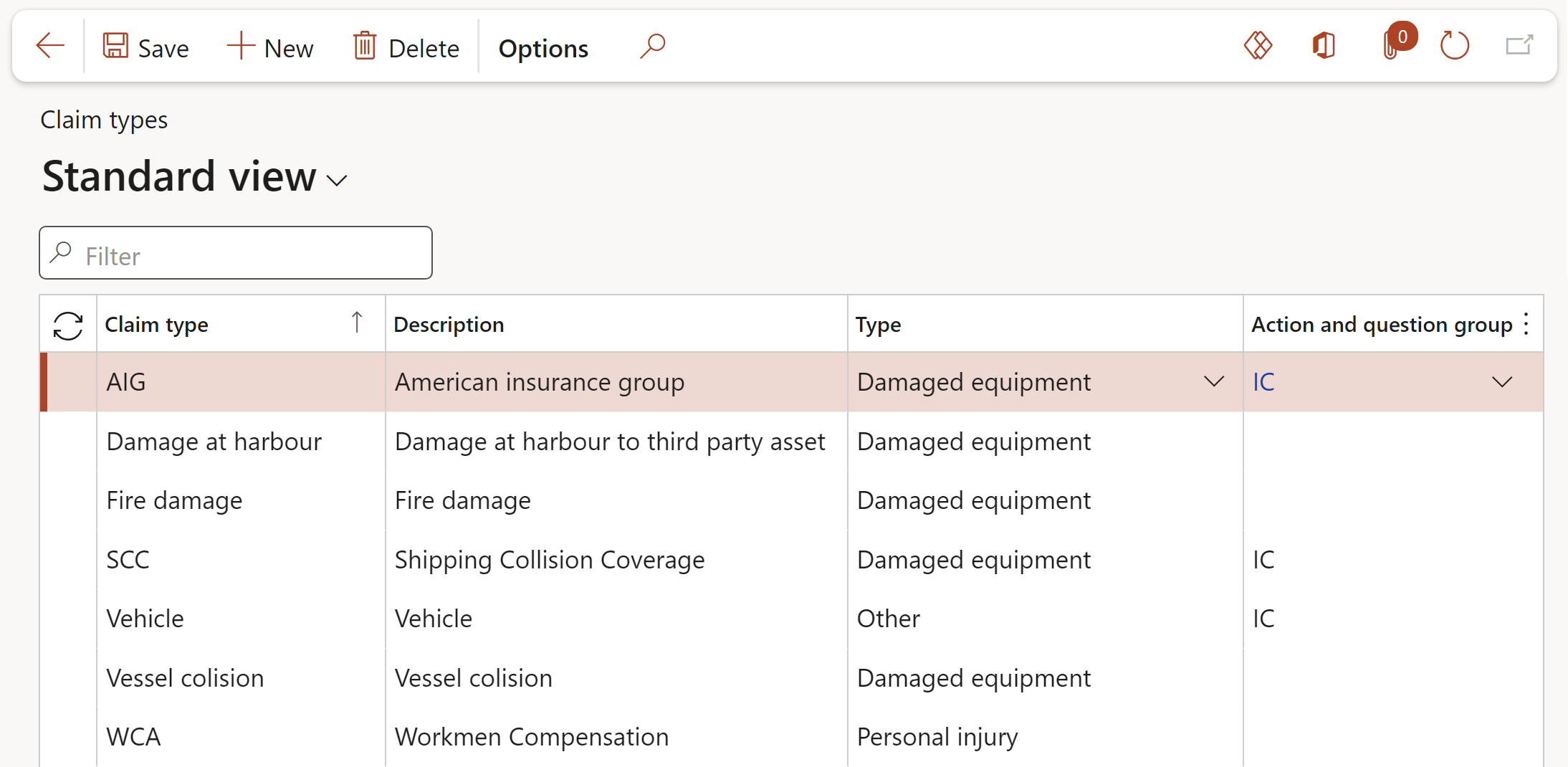
For information on how to setup Action and question groups, please refer to Claims
¶ Step 15: Setup Targets and goals
Companies setup Targets and goals to reduce workplace injuries, illnesses, and fatalities and to change the workplace culture to increase employer and worker awareness of, commitment to, and involvement in safety and health.
Go to: HSE > Incidents > Setup for incidents > Targets and goals
- On the Action pane, click the on New button
- In the KPI field, select the relevant KPI from the dropdown list
- The following fields will be populated with the relevant data:
- Explanation
- Note
- KPI calculation
- Mark the KPI as active/inactive
- Expand the Detail Fast tab
- In the Button strip, click on the Add button
- In the Year field, enter the Target year
- In the Site field, select the relevant Site from the dropdown list
- In the KPI target field, enter the KPI target value
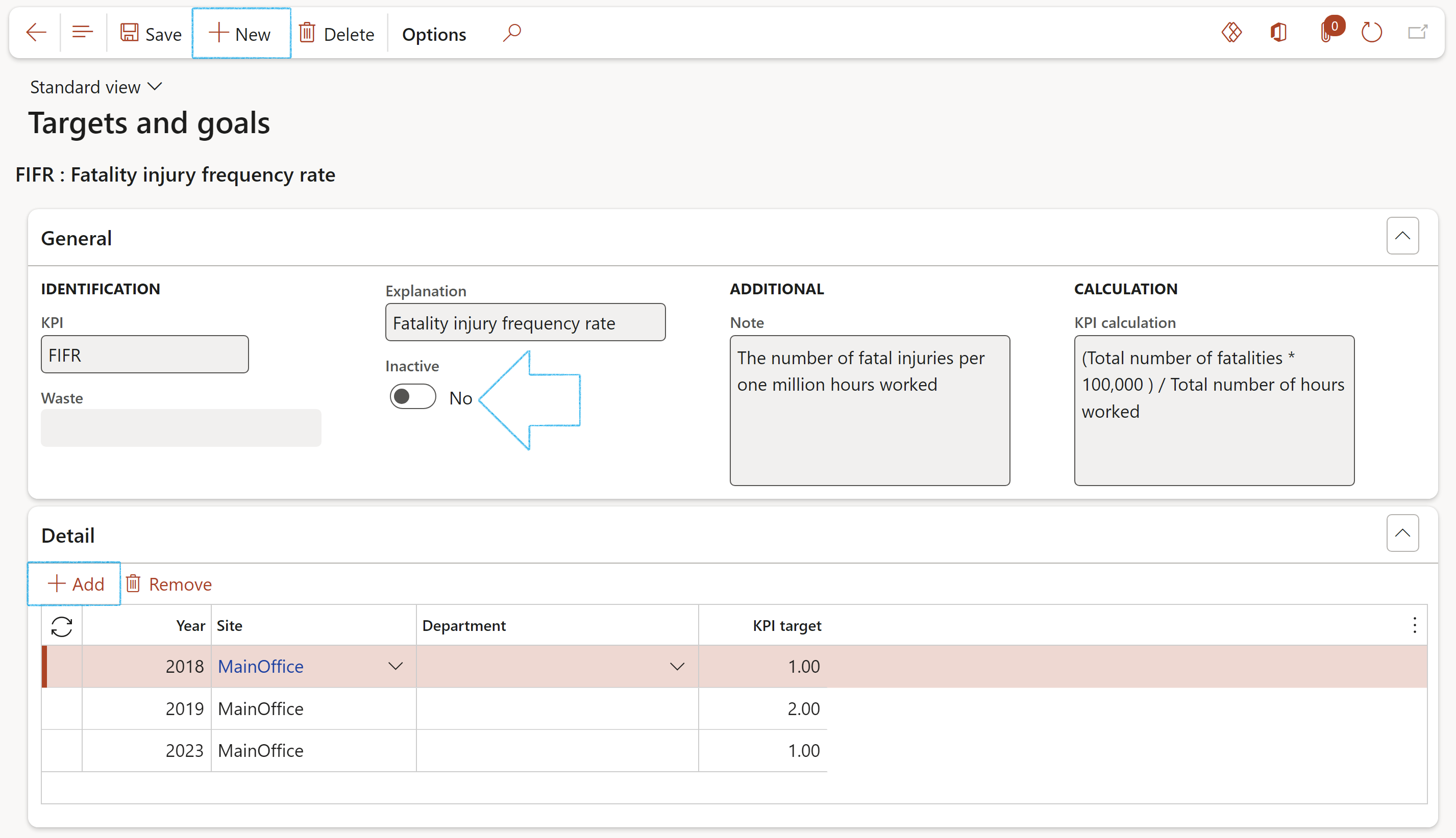
OR create a Custom KPI:
- On the Action pane, click the on New button
- In the KPI field, select Custom from the dropdown list
- Enter the KPI ID for the custom KPI
- In the Explanation field, enter a description of the KPI
- Enter an additional Note
- Enter the KPI calculation
- Mark the KPI as active/inactive
- Expand the Detail Fast tab
- In the Button strip, click on the Add button
- In the Year field, enter the Target year
- In the Site field, select the relevant Site from the dropdown list
- In the KPI target field, enter the KPI target value
- Expand the Calculation setup Fast tab
- In the Button strip, click on the Add button
- Enter the Element number
- Select the relevant Value from the dropdown list
- Enter a Test value
- In the Calculation expression field, enter the calculation expression (Placeholders [%1, %2, %3, etc.] can be used in the calculation expression)
Use % as a placeholder followed by the element number. E.g. %1 / (%2 + 0.001)
Valid operators in the Calculation expression fied are: - + * / ( )
Decimals should be denoted with .
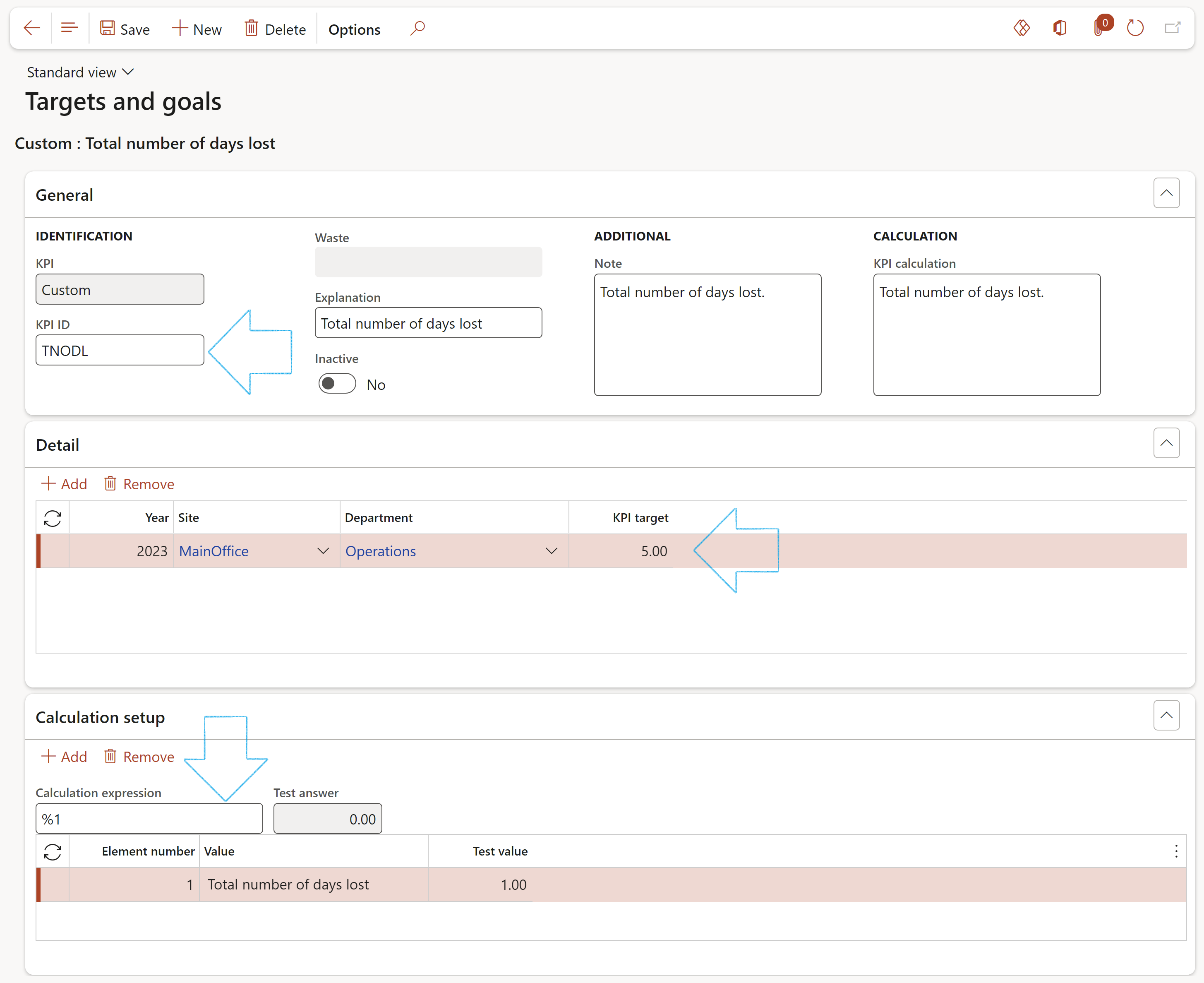
¶ Step 16: Create Members
In order to create members, a customer has to be setup first.
¶ Step 16.1: Create a Customer
Go to: Sales ledger > Customers > All customers
- On the Action pane, click on the New button
- On the Create customer dialog, enter the following information:
- Customer account number/name
- In the Type field, select Person from the dropdown list
- Enter the customer’s First name
- Enter the customer’s Surname
- Select the relevant Customer group from the dropdown list
- Click on the Save button
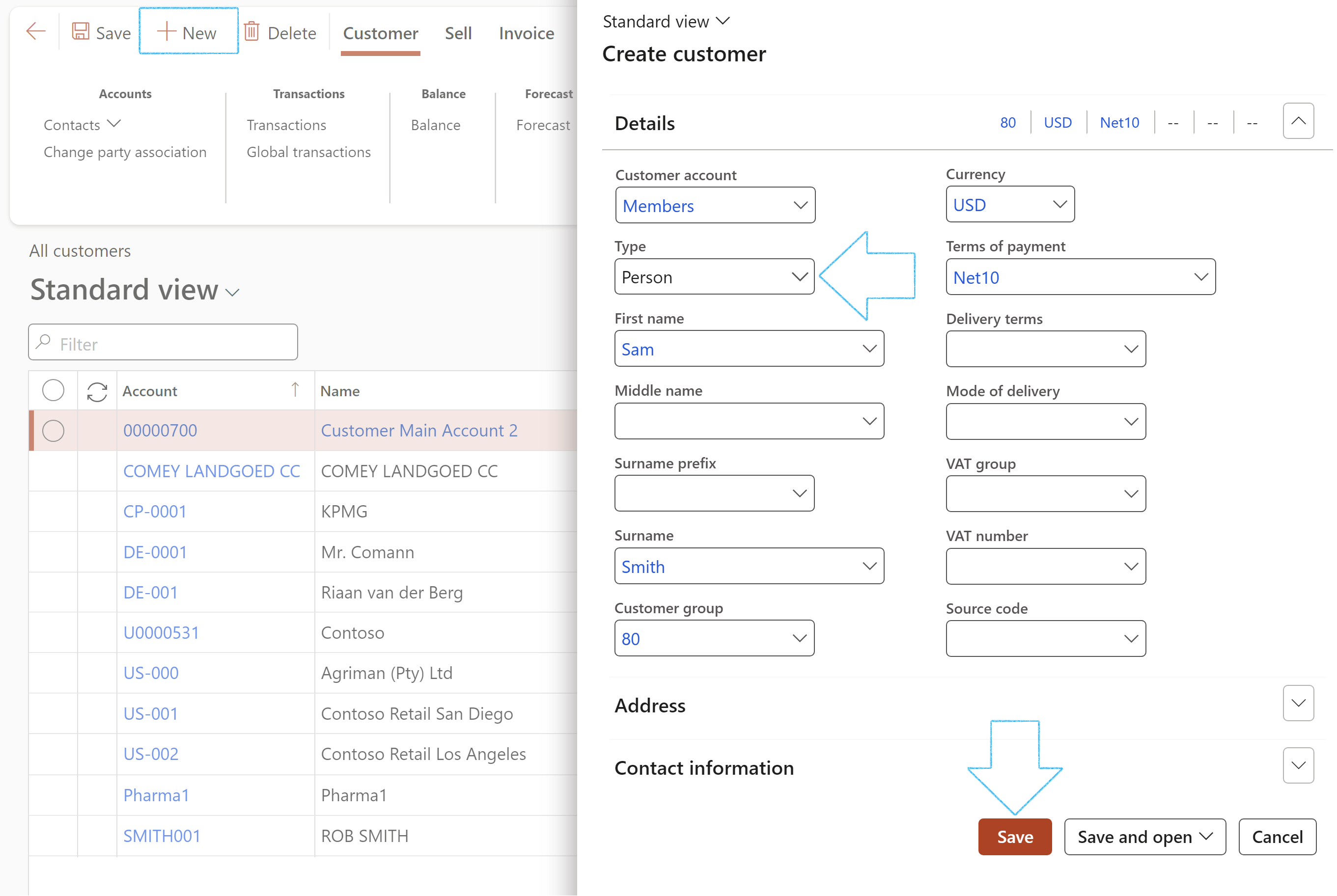
¶ Step 16.2: Creating the Members
Go to: HSE > Occupational health > Members
- On the Action pane, click on the New button
If the new member is not a worker in the company:
- Leave the Worker field blank
- Select the relevant Customer account from the dropdown list (the one created above)
- Enter the member’s First name
- Enter the member’s Surname
- Enter the member’s Date of birth
- Indicate whether this is the Main member
- Enter the Member number
- If this is a dependent member (not main member) select the Main member’s number form the dropdown list
- Enter the Date on which the member was added
- Select the Gender of the member
- Indicate whether the membership is Active
- Select the relevant Member type from the dropdown list
- Enter the member’s National ID number
- Enter the member’s Passport number
- Enter the member’s Mobile phone number
- Enter the member’s Email address

If the new member is a worker in the company:
- Tick the Worker checkbox
- Select the relevant Customer account from the dropdown list (the one created above)
- Select the relevant Person (worker in the system) from the dropdown list
- Complete the grid as described above

¶ Daily use
¶ Step 17: Reporting the incident
There is more than one entry point for people to record an incident into Dynamics. Inside Dynamics 365 HSE we have two forms that the users can use:
- A simple/quick form.
- A more involved and detailed form for typical back-office use.
Two menu steps exist for this function:
- All reported incidents (across all entities)
- All reported incidents in legal entity (the legal entity that you are currently logged into)
Inside D365 Projects, users can create an incident from the Projects list page
Users can also enter information about an incident via a mobile app or web site and it will be logged inside HSE
¶ Step 17.1: The simple form for reporting an incident
Go to: HSE > Incidents > Report an incident
- Select an existing incident from the dropdown list, or enter a new Description for the incident
- Select the Date and time of the incident (The default is Today’s date. A warning will pop up if a future date is selected)
- Select the Incident type from the dropdown list
- Select the name of the person who reported the incident
- Enter relevant details of the incident under the Other field group
- Print a Flash report of the incident by selecting Yes (see screenshot of the Flash report below)
- An email notification will be sent to the selected 1st level supervisor if the Email notification tick box is ticked
- Click OK
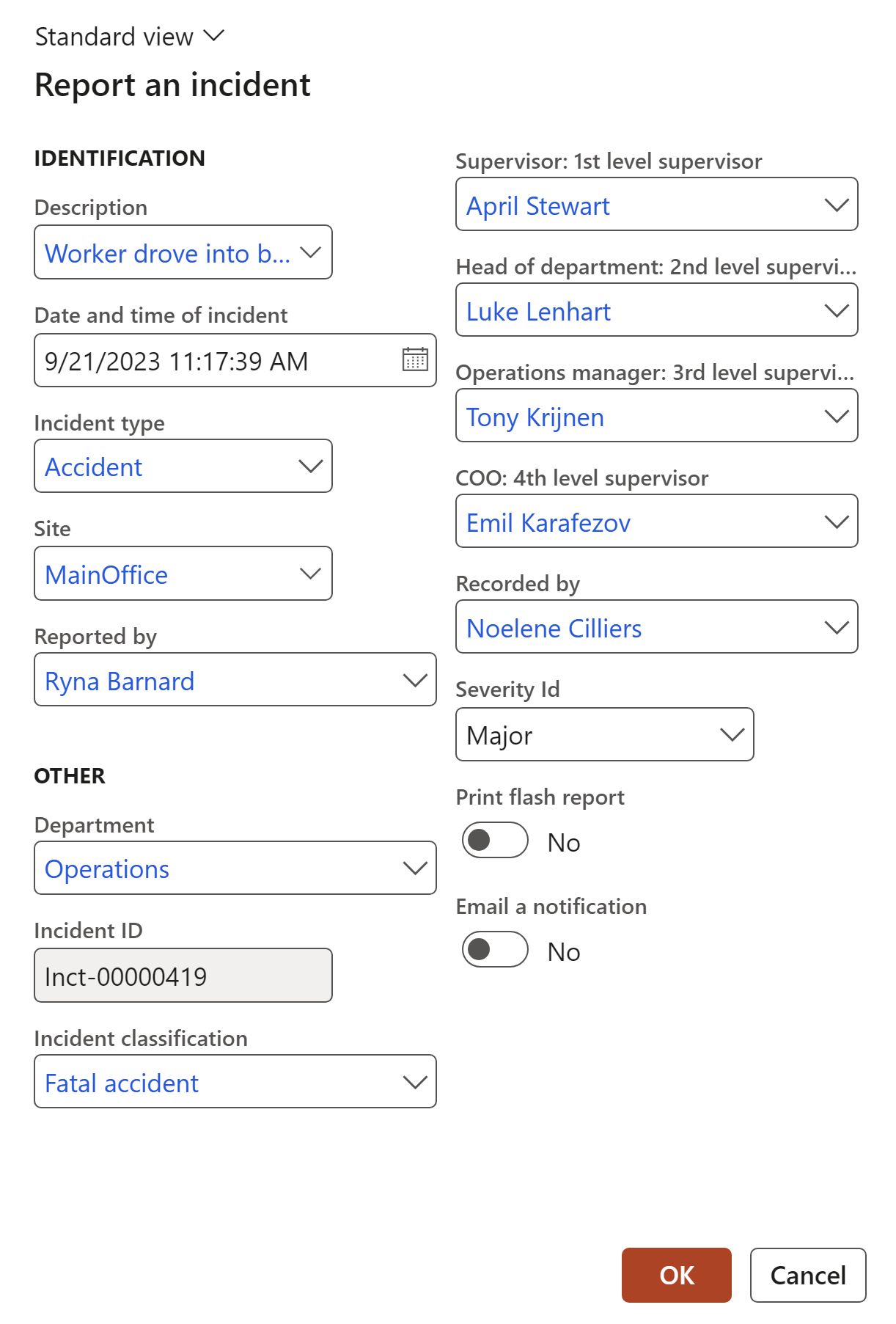
If it is required that the Print flash report and Email notification fields should not be visible on this form. Go to: HSE parameters > General tab, Other Fast tab, and leave the Admin user group field blank.
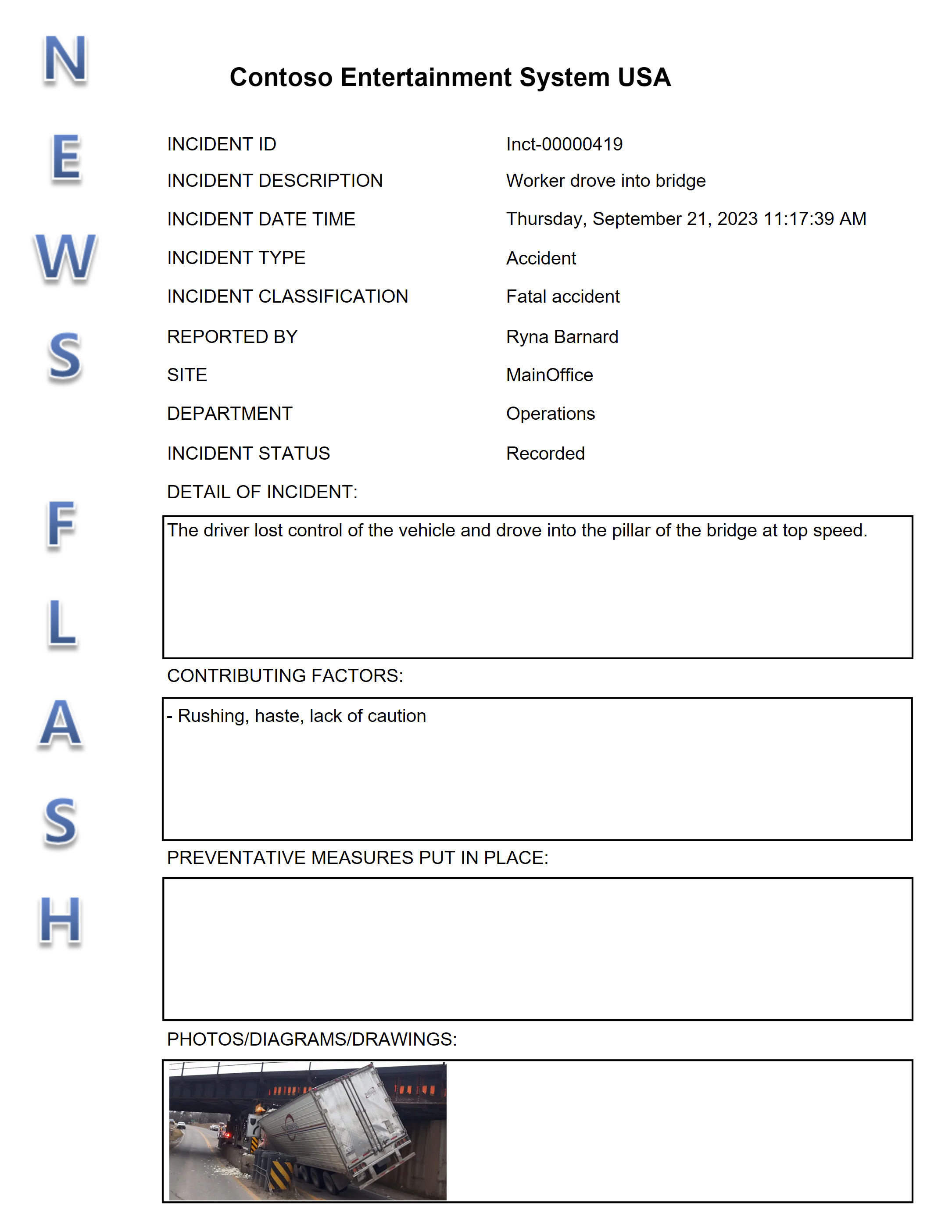
When a new incident is being reported, Dynamics 365 will check for duplicates of the following 4 fields:
- Incident type
- Site
- Department
- Incident classification
A blue line will appear to warn the user that a similar incident already exists:
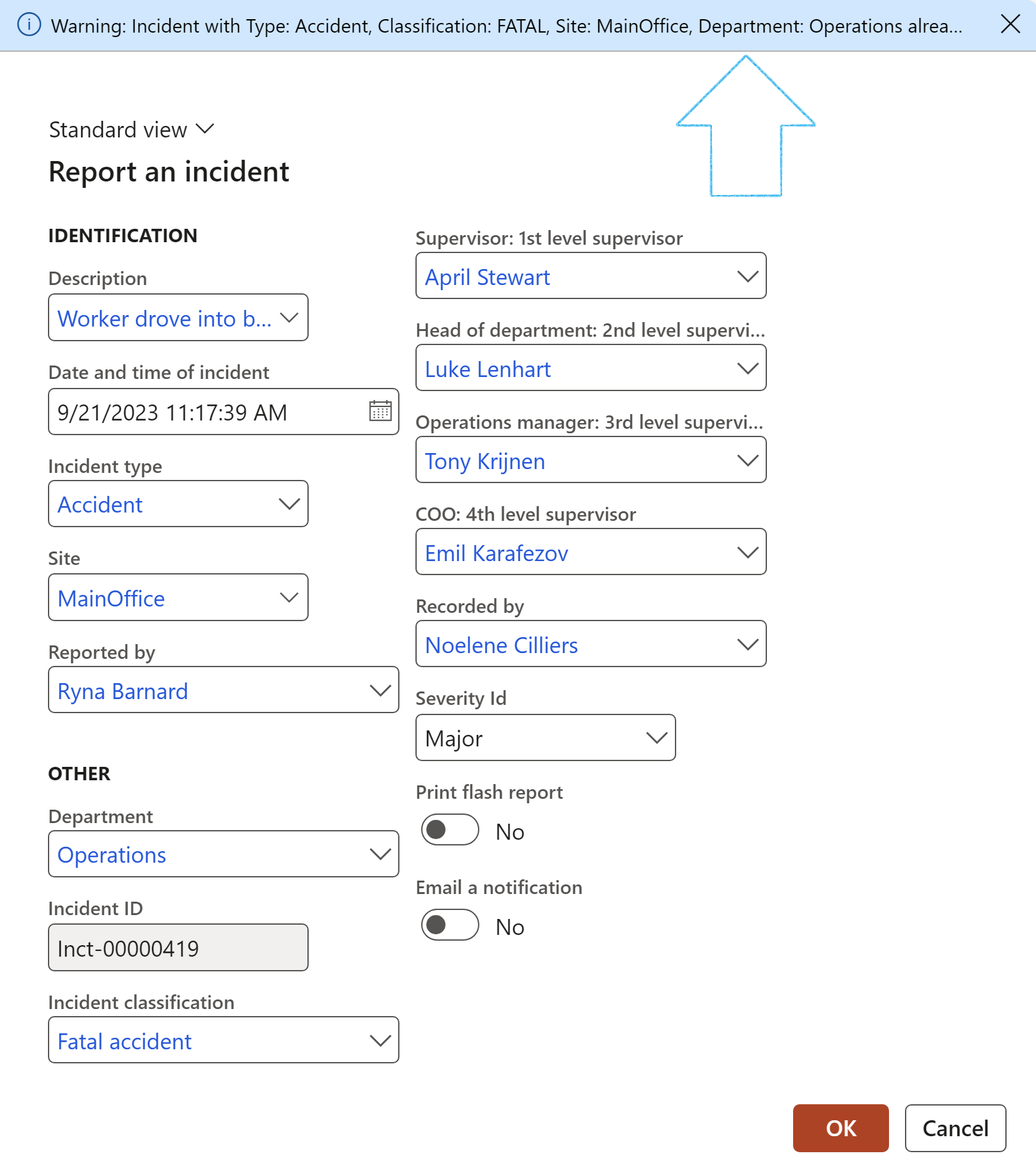
The setup form below is used to select the fields that need to be displayed on the simple Report an incident form when an incident is being recorded.
Users may choose to only have a few fields on the simple form to make it easy to use, while others might prefer more fields. Dynamics 365 HSE allows users to specify which fields to display.
Go to: HSE > Setup > Health, Safety and Environment parameters
- Click on the Incidents bullet
- Click the Update list button
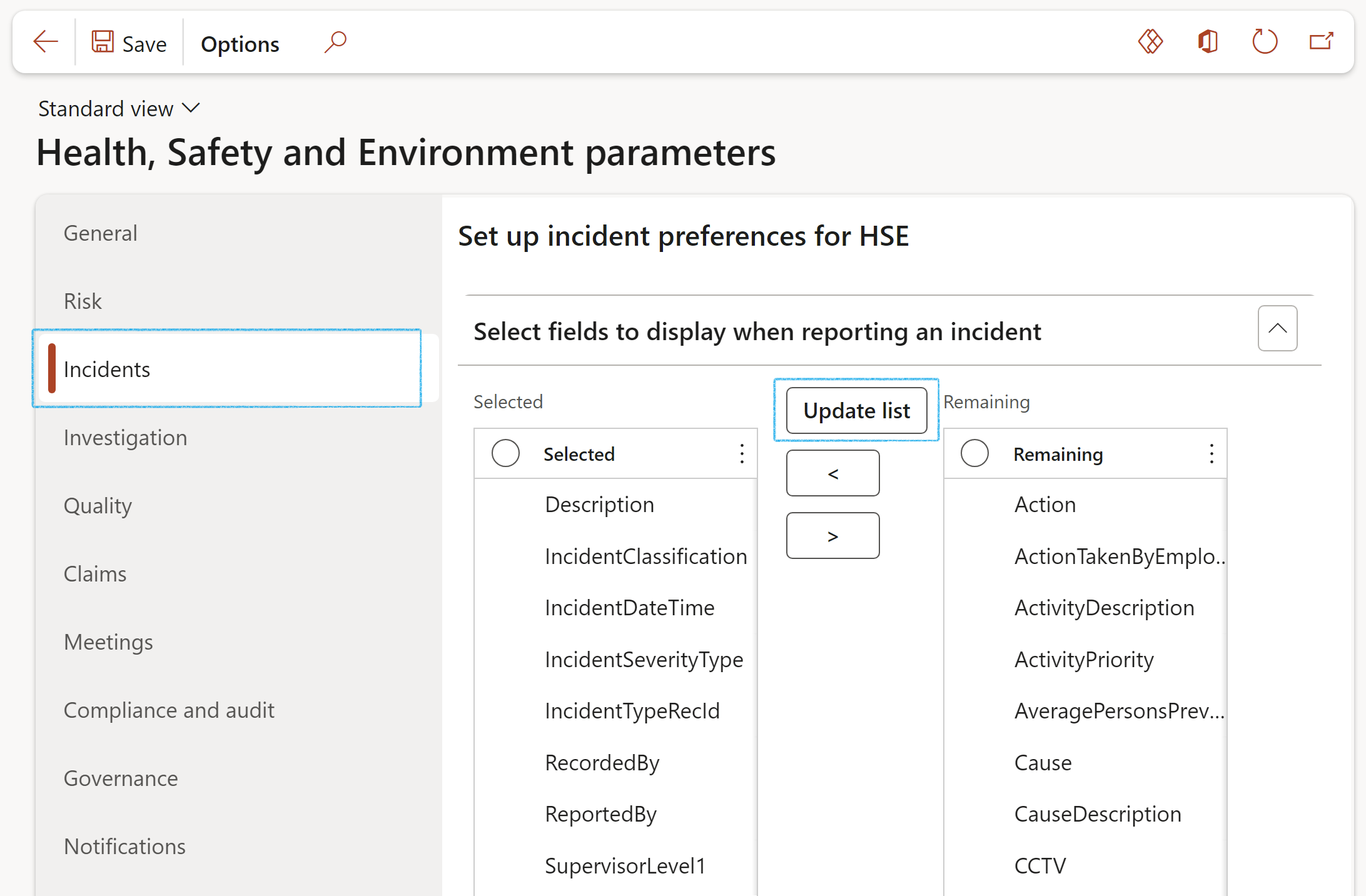
Select the fields to be displayed on the simple Report an incident form from the Remaining column and move them to the Selected column by using the < arrow button. (If fields need to be removed from the Selected column, use the > arrow).
¶ Step 17.2: The projects list page
When an incident has to be reported on a project, the quick create form can be accessed from the Project management and accounting module
Go to: Project management and accounting > Projects > All projects
- Select the relevant project
- On the Action pane, open the Manage tab
- In the New group, click the Incident button
- Enter the incident details as explained previously.
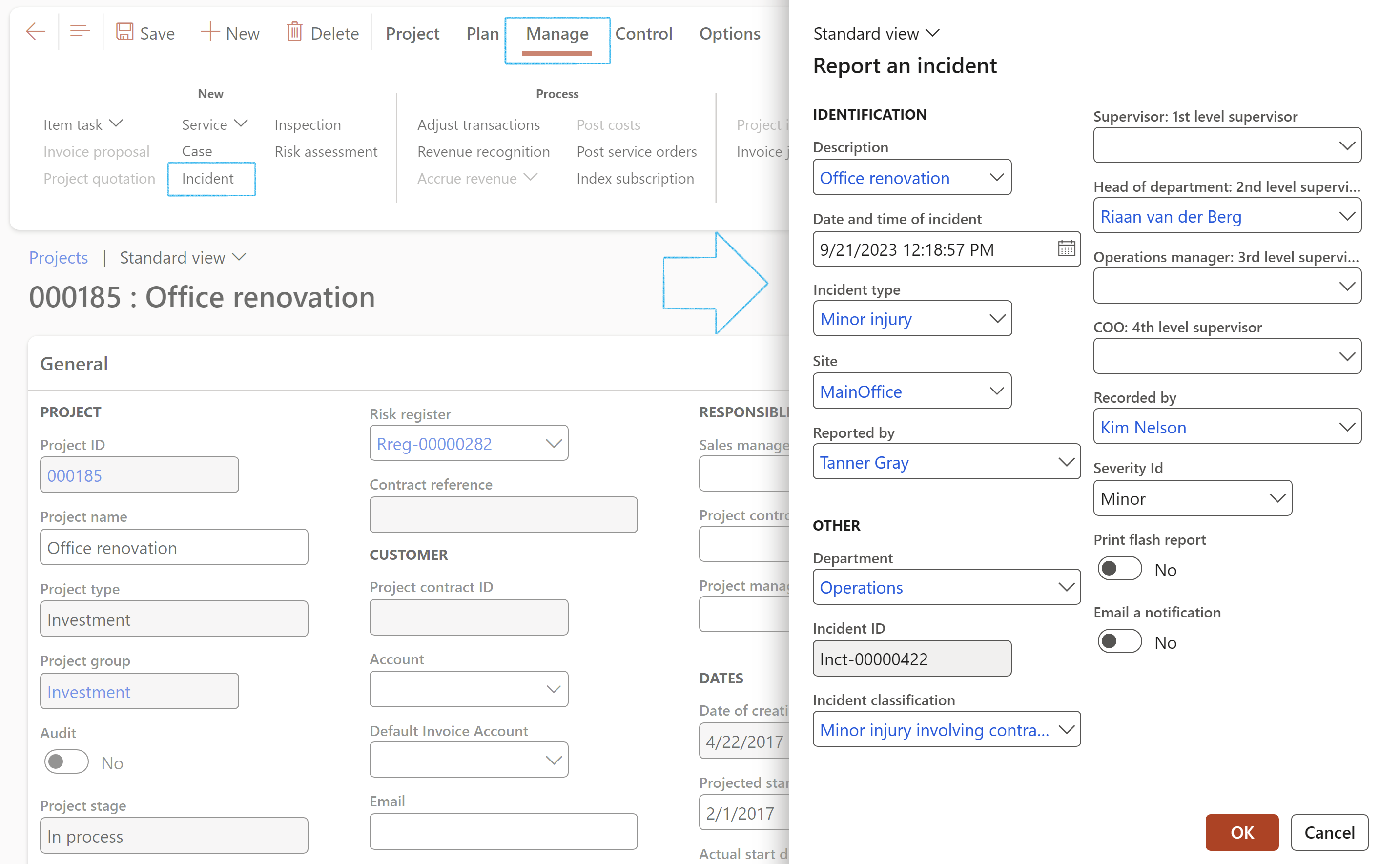
When an incident has to be reported on a project, the quick create form can be accessed from the Project module.
¶ Step 18: View the incidents
¶ Step 18.1: View the recorded incidents for all companies
Go to: HSE > Incidents > All reported incidents
- On this list page all incidents, regardless of company/legal entity, are listed
- Filters can be applied by selecting Site, Department, Location, Incident type and Legal entity

The buttons on the All reported incidents list page:

- Go to incident: Opens the Incident detail form for the selected incident
- Find duplicates: Opens the Find duplicates inquiry (See Step 27 below)
- Incident summary report: Prints the Incident summary report
- Create investigation: Opens the Investigations form which is populated with the data from the selected incident
- Export to Microsoft Excel: Exports the All reported incidents list page to Microsoft Excel
The All reported incidents in my department menu item opens a list of incidents where the logged in user is the Head of department: 2nd level supervisor
A list of incidents that were recorded by a worker, can be viewed from the Worker form
Go to: HSE > Worker
- Select the worker that you want to see all reported by incidents of
- In the Action pane, open the Health and safety tab
- In the Safety button group, click on the Events/Incidents button

¶ Step 19: Report/record an incident
Go to: HSE > Incidents > Report an incident
- Complete the Report an incident dialog
- Click on OK
The Incident detail form will open
¶ Step 19.1: Enter details of the incident
- Expand the General Fast tab
- The Incident ID is auto generated
- Select the relevant Description from the dropdown list
- Select the Date and time of the incident
- Select the Incident type from the dropdown list
- In the Date recorded field, select the date on which the incident was recorded. If the date entered in the Date recorded field is after the current system date, the date will automatically change back to the current date.
- The name of the logged in user will be displayed in the Reported by field. It can be edited
- In the Reference number field, enter the relevant accident of dangerous occurrence number
- Select the relevant Incident classification from the dropdown list
- The Status will be Captured
- Select the Severity ID from the dropdown list
- In the Work activity field, select the activity/action that the worker was busy doing when the incident occurred
- Enter the following information under the Main area field group:
- Site where the incident occurred
- Department where the incident occurred
- Location where the incident occurred
- Enter the relevant information under the Line management field group
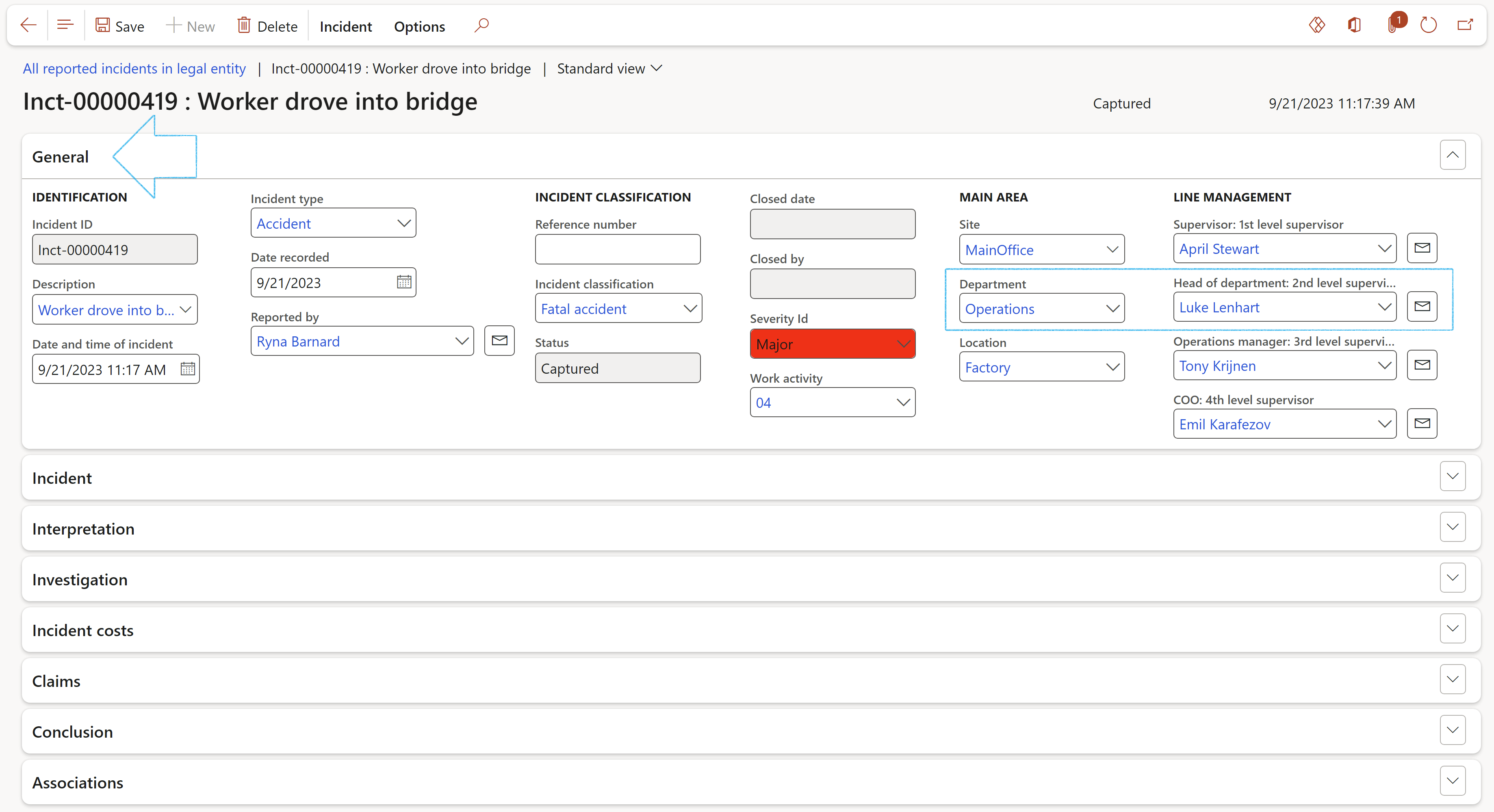
- The Head of department 2nd level supervisor field will be populated with the name of the department manager (manager of the selected department)
- The worker selected in the Head of department 2nd level supervisor field, will see incidents that have been recorded in his/her department under the All incidents in my department menu item
- To send an email to Line management, click on the email icon next to the relevant name
- The selected worker must have a primary email address
The buttons on the Incident detail form:

- Delete – Removes the selected record permanently
- Report an incident – Creates a new incident
- Triage – Changes the status of the incident to Triage
- Close – Changes the status of the incident to Closed and the record cannot be edited
- Re-open – Changes the status to In process
The Re-open button is only available for users with the following roles:
- Incident administrator
- Incident manager
- Incident address - The user can add additional physical and/or GPS location details for the place of incident
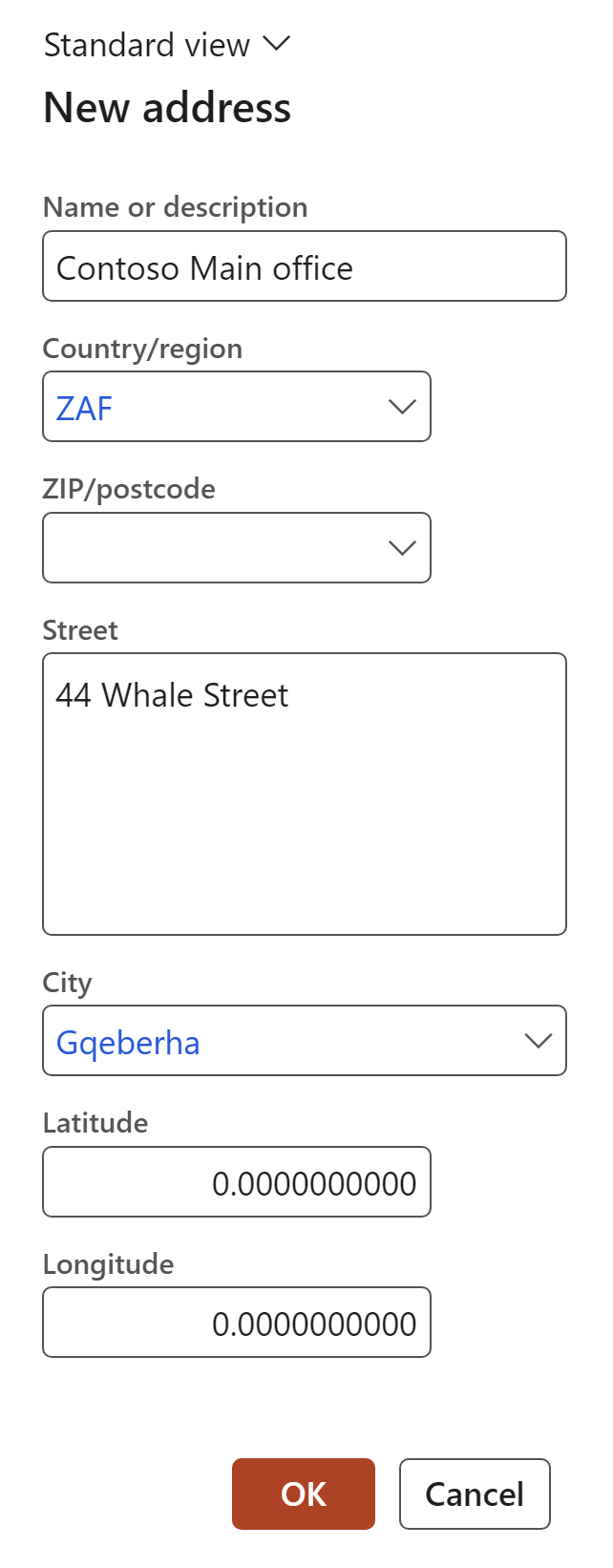
- Send email notification - Send an email notification to the selected stakeholders
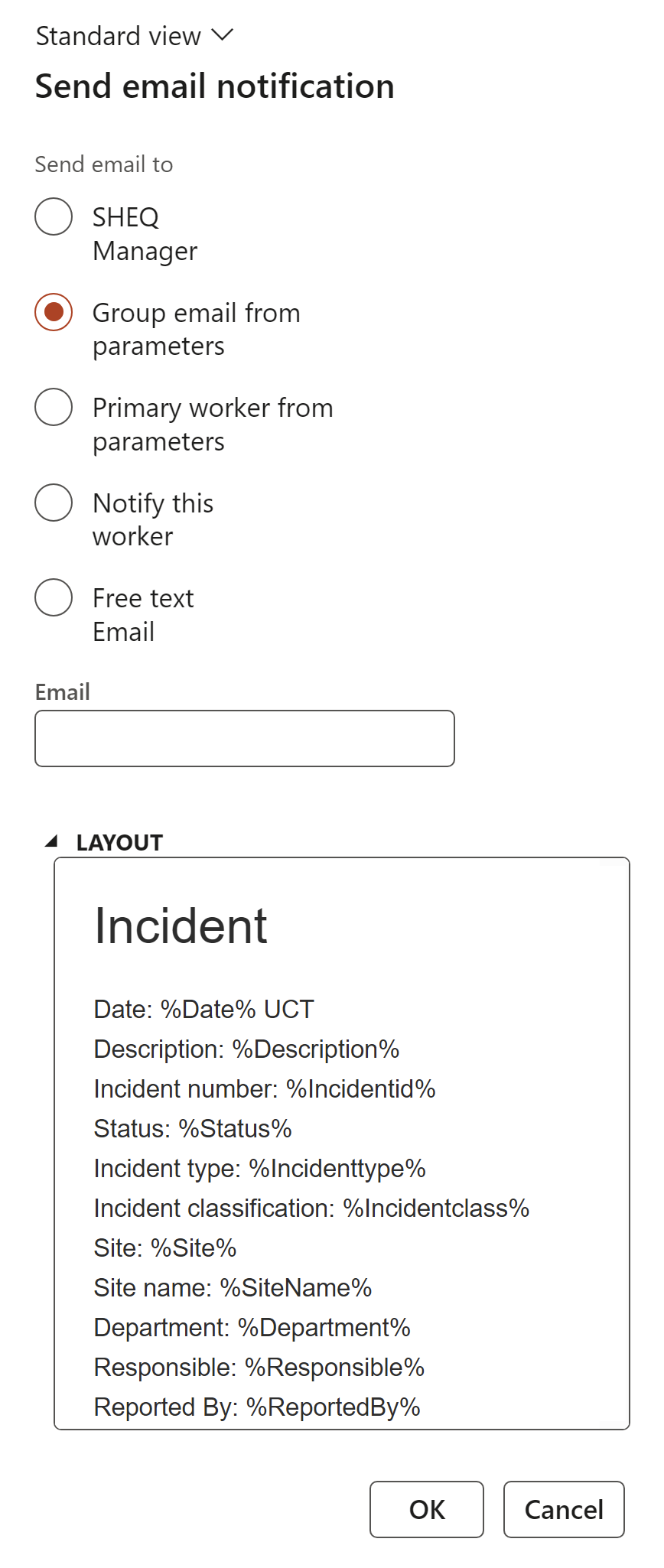
- Documents - To upload pictures that have to be printed on the Flash report
- On the Action pane, click on the Documents button
- On the Documents form, click on the New button
- If more than one picture is to be printed on the flash report, enter the Sequence number in which the image is to be printed
- Enter a Description for the image
- In the Type field, select Picture from the dropdown list
- If the image has to be printed on the flash report, tick the Print image box
- On the Action pane, click on the Save button
- On the Action pane, click on the File button
- Browse for the image that you want to upload
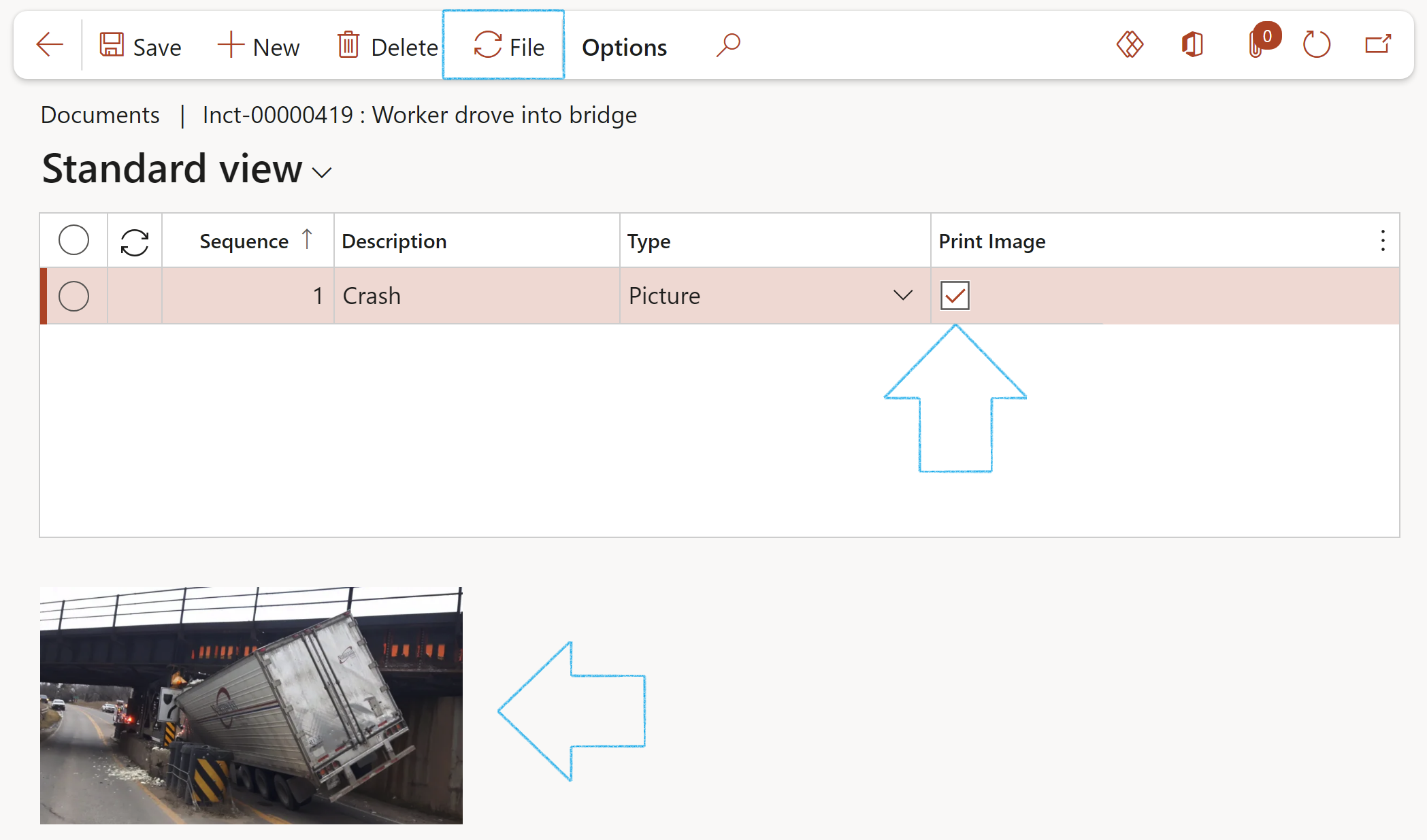
- Flash report - To print a Flash report of the incident
- Risk assessment
- Risk details can be added
- A new risk register can be created
- Select an existing risk entry
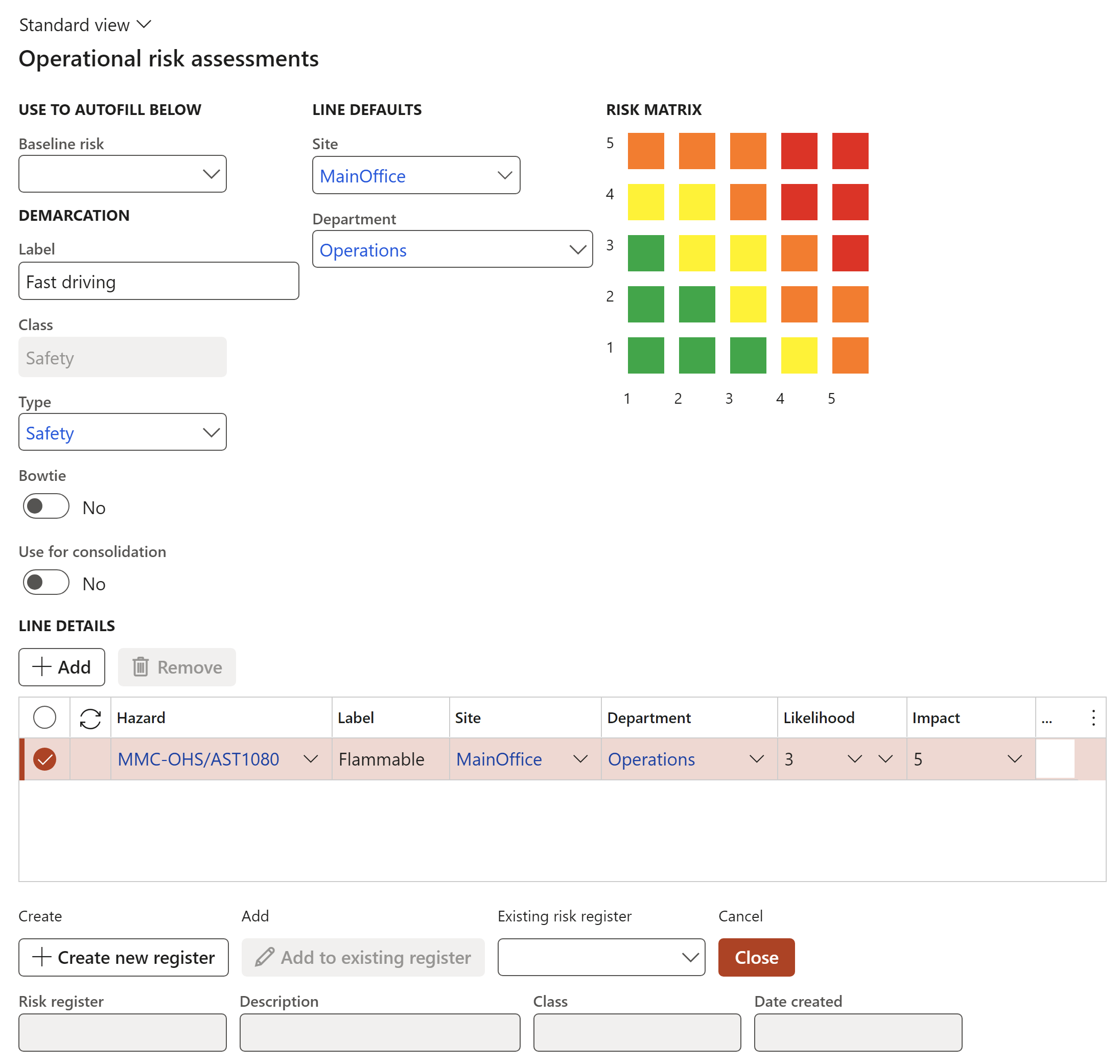
- Create activity
- On the Action pane, in the Function group, click on the Create activity button
- Complete the Create activity dialog that opens

For details on Activity management, refer to the Activity manager Wiki page.
- Attachments – The document handling functionality can be used to attach files/pictures/documents or notes that are applicable to the investigation
Buttons relating to details of the incident:

- Environmental – Opens a wizard that guides the user to enter additional environmental information related to the incident. (This button is only available if the Incident type = Environmental)
- Fires – Opens a dialog where the user can add additional information if fire was the cause of the incident
- Explosives - Opens a dialog where the user can add additional information if an explosion was the cause of the incident
- Fall of ground - Opens a wizard that guides the user to enter additional information if the incident was caused by fall of ground
- Heat exhaustion/stroke - Opens a wizard that guides the user to enter additional information if the incident was caused by heat exhaustion/stroke
- Response to incident – The dialog enables the user to enter the details of the first aid given at the site of the incident

¶ Step 19.2: View the recorded incidents for the CURRENT company/legal entity
Go to: HSE > Incidents > All reported incidents in legal entity
- Select the incident
- Expand the Incident Fast tab
This is where the core data of the incident is recorded
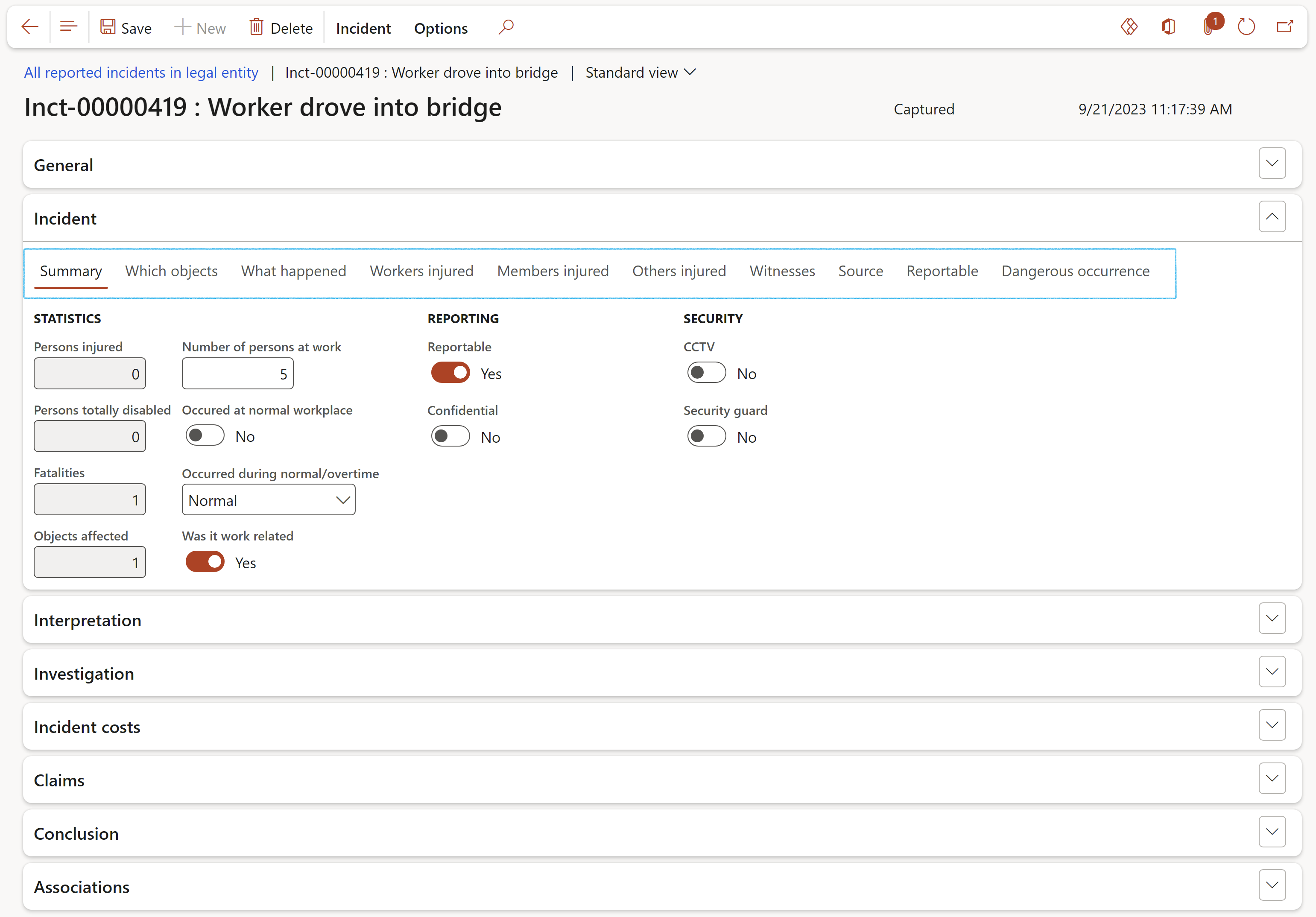
The index tabs at the top of the Incident Fast tab provide fields for adding additional details that will aid the investigators and the management teams to do detailed analysis.
¶ Step 20: Incident Fast tab
- The Summary index tab provides a summary of the statistics of the incident
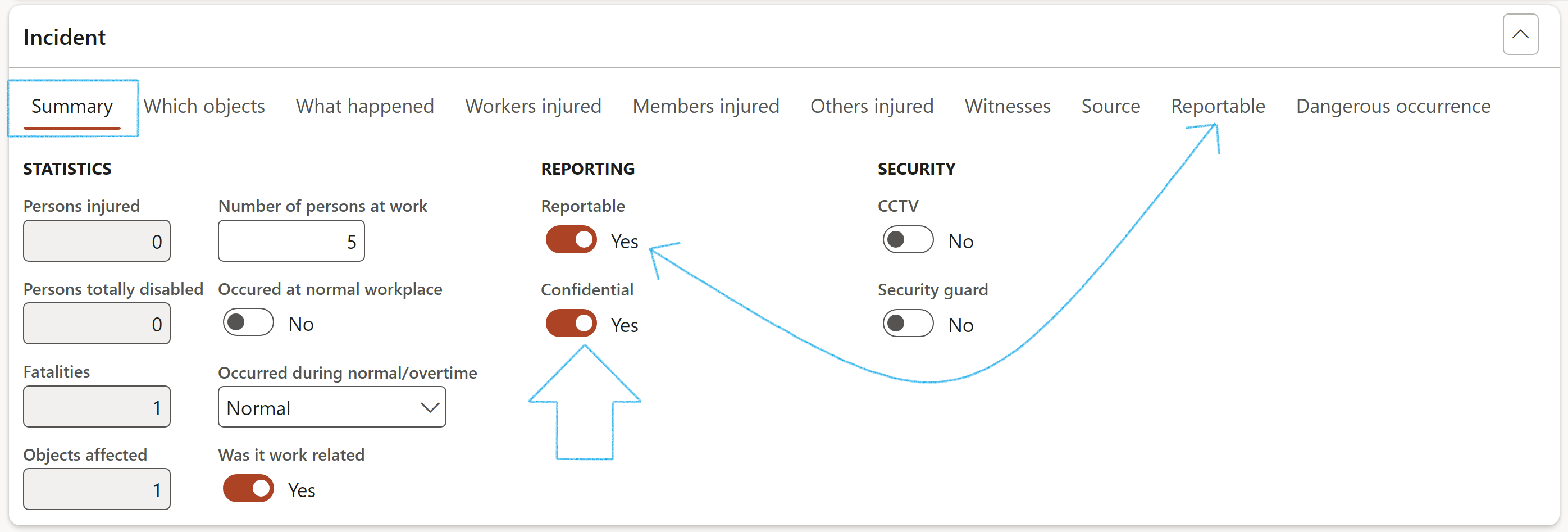
- The accuracy of the statistics depends on the correct setup on the Injury and illness setup form. Please refer to the setup above.
- The Include external parties slider on the Parameters form has to be set to Yes in order to include witnesses and visitors in incident summary calculations.
The Reportable Index tab is only available when the Reportable slider is moved to Yes
When the Confidential slider is moved to Yes:
- The incident will be on the All confidential incidents list page
- When a non SHREQ admin user tries to access confidential incidents from an incident list page, an action center info message will appear
- Details of the objects affected by the incident are entered in the Which objects index tab
- External objects affected by the incident can be entered
- Internal objects affected by the incident can be listed
- Additional information such as Serial number and Make and model of the object can be entered
- The user can indicate whether the object was correctly used
- The user can indicate whether the object Is/was in good working order
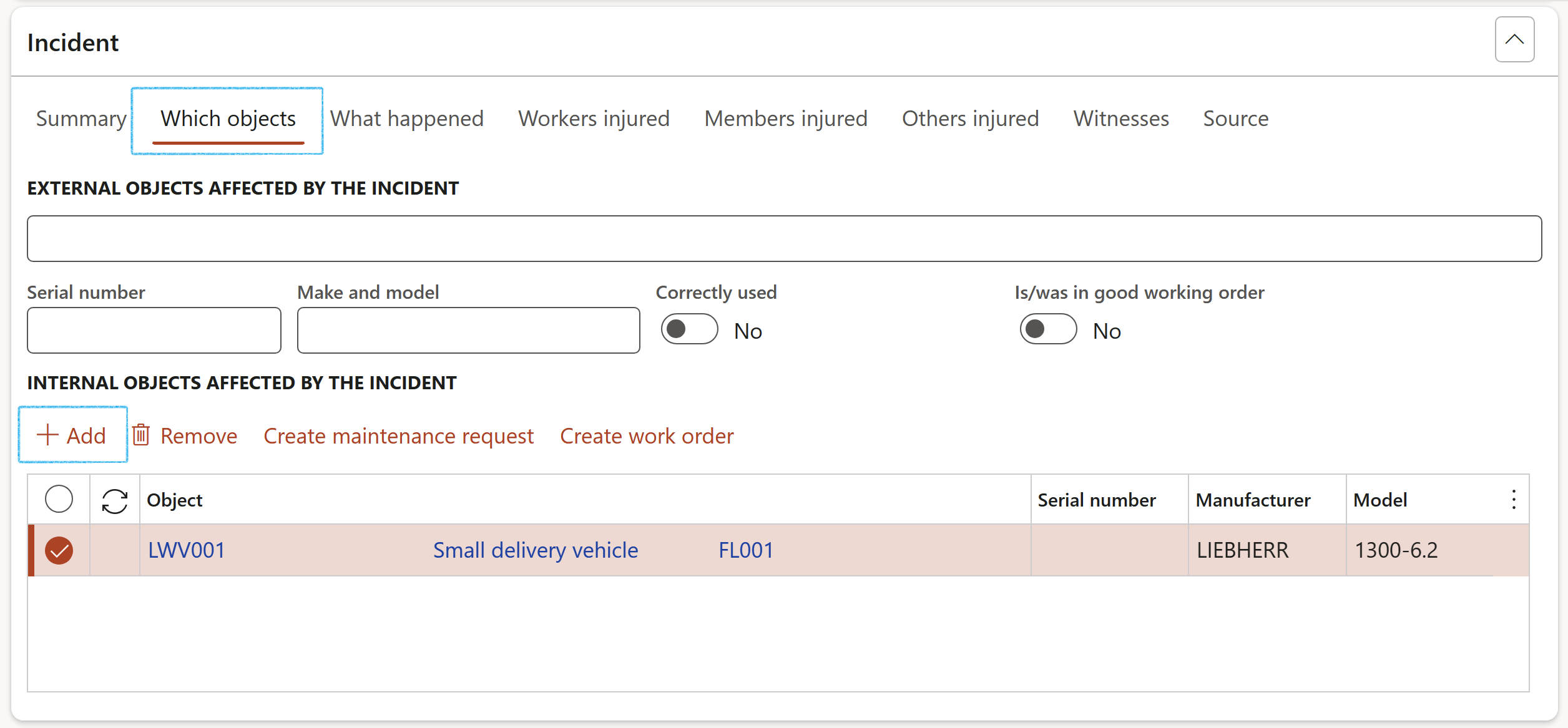
Internal objects affected by the incident might need some maintenance work done on it. The maintenance job might require a maintenance request.
- Select the object that you want to create the maintenance request for
- In the Button strip, click on the Create maintenance request button
- Complete the Create request dialog with the relevant detail
- Click on the OK button
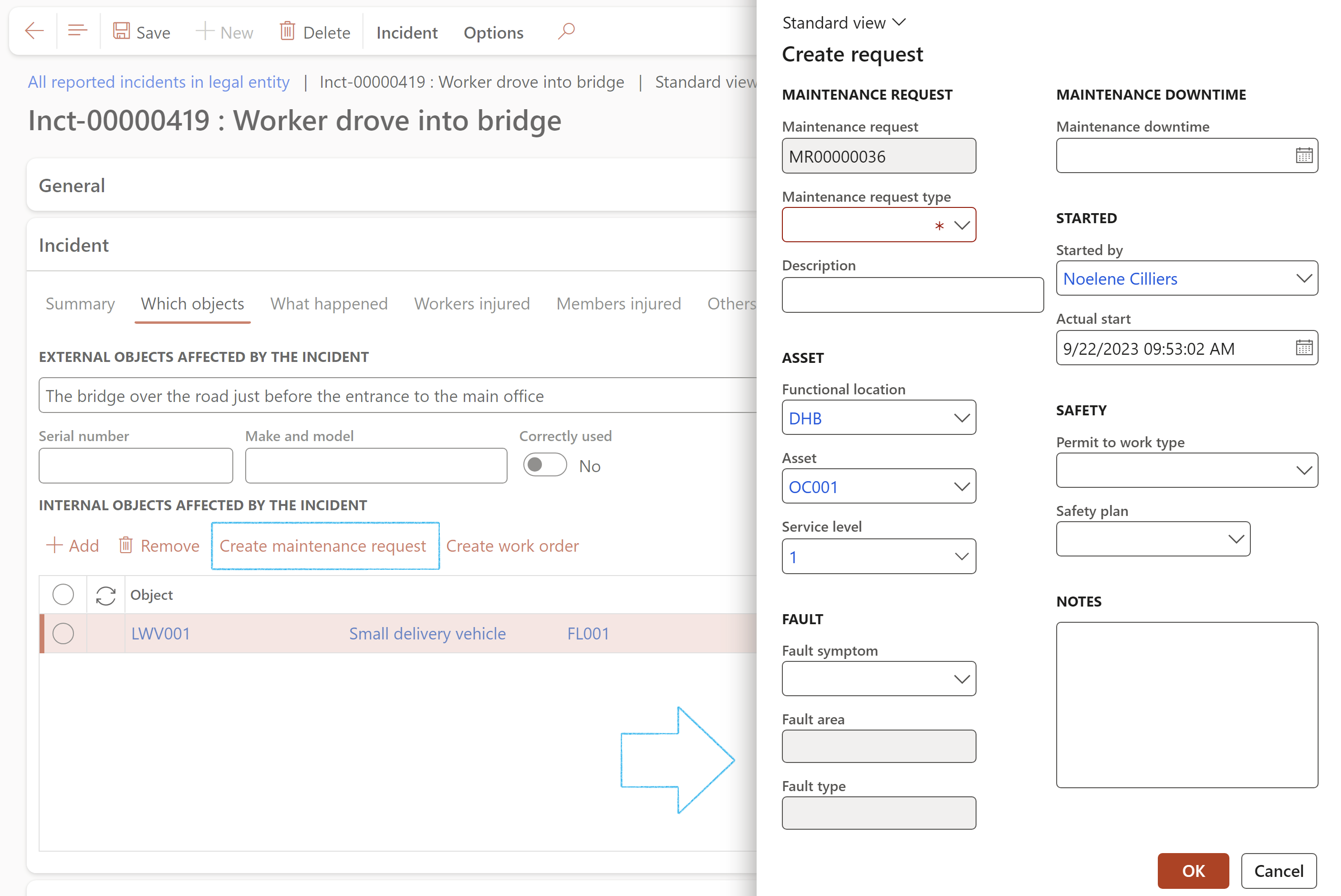
The Maintenance request detail form will open for the user to enter additional detail
A reference record will be added on the Incident under the Associations Fast tab
Internal objects affected by the incident might have to be repaired. The repair job might require a work order.
- Select the object that you want to create the work order for
- In the Button strip, click on the Create work order button
- Complete the Create work order dialog with the relevant detail
- Click on the OK button
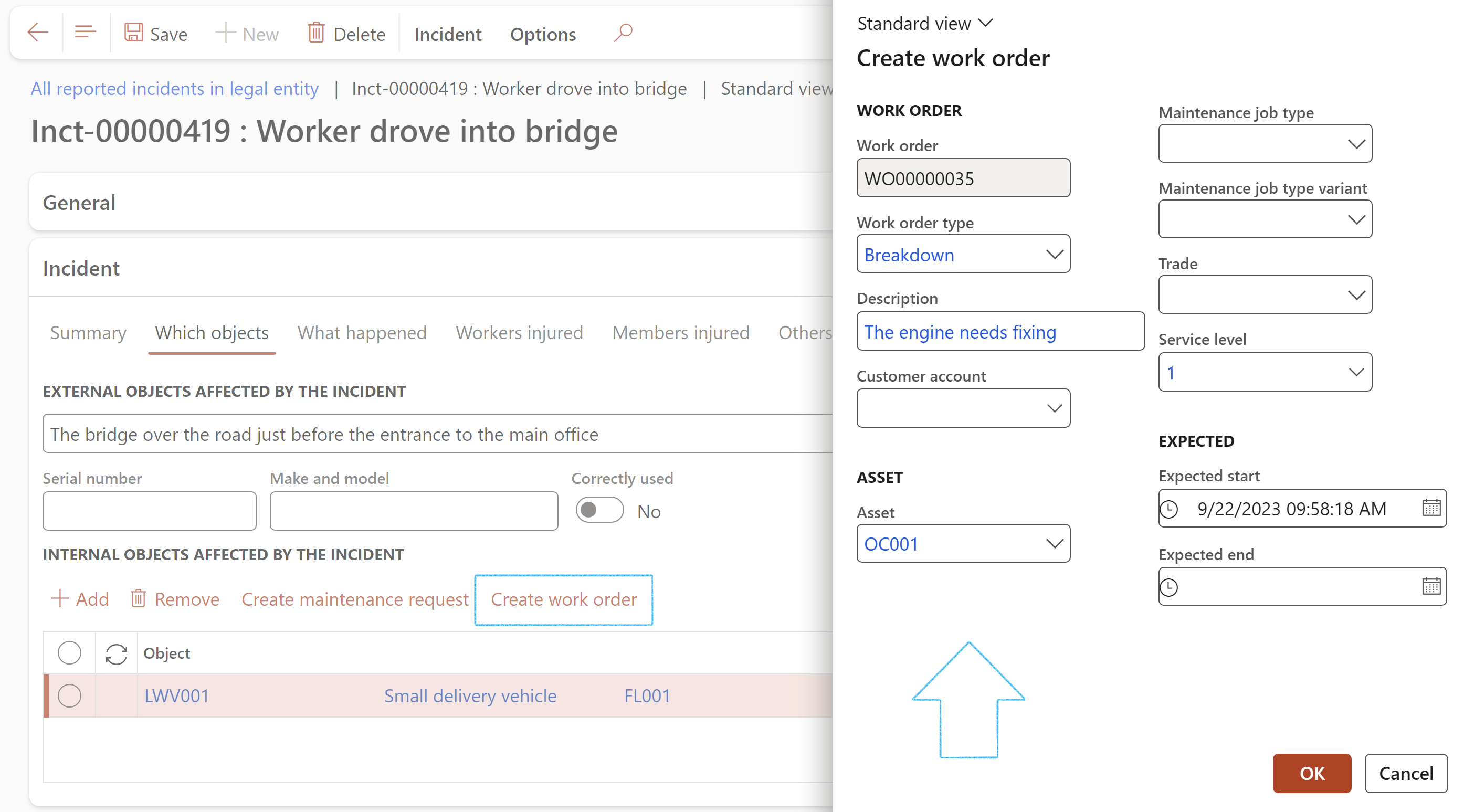
The Work order detail form will open for the user to enter additional detail
On the Work order, in the Action pane, View button group, the user can click on the Incident button to open a list of all Incidents linked to the Work order
A reference record will be added on the Incident under the Associations Fast tab
- Under the What happened Index tab, the Accident classification can be selected by clicking on the arrow next to the relevant phrase. This will open up the different levels to choose from. Multiple Accident classifications can be selected.
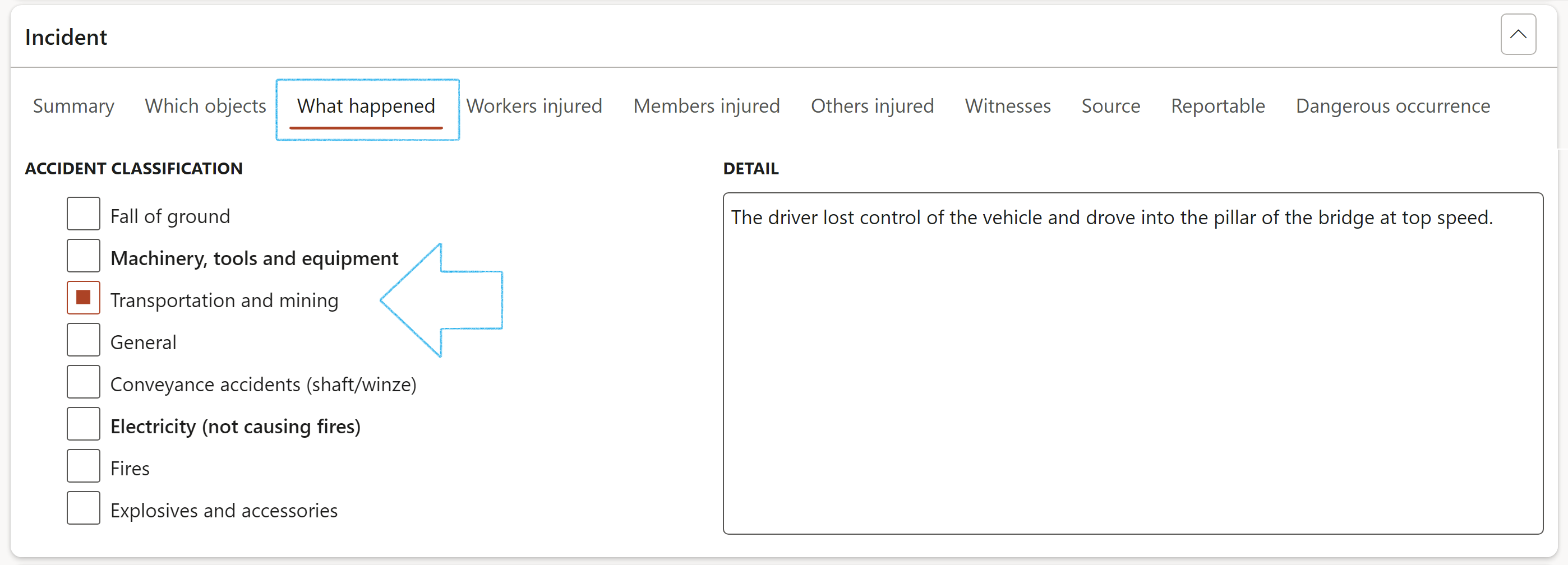
- In the Workers injured index tab, details of the injured worker can be recorded for example:
- The unique ID for the record in the database
- The outcome type of the incident
- What action the worker was doing when the incident occurred

- To create an injury from this form, click on the Create injury button in the Button strip
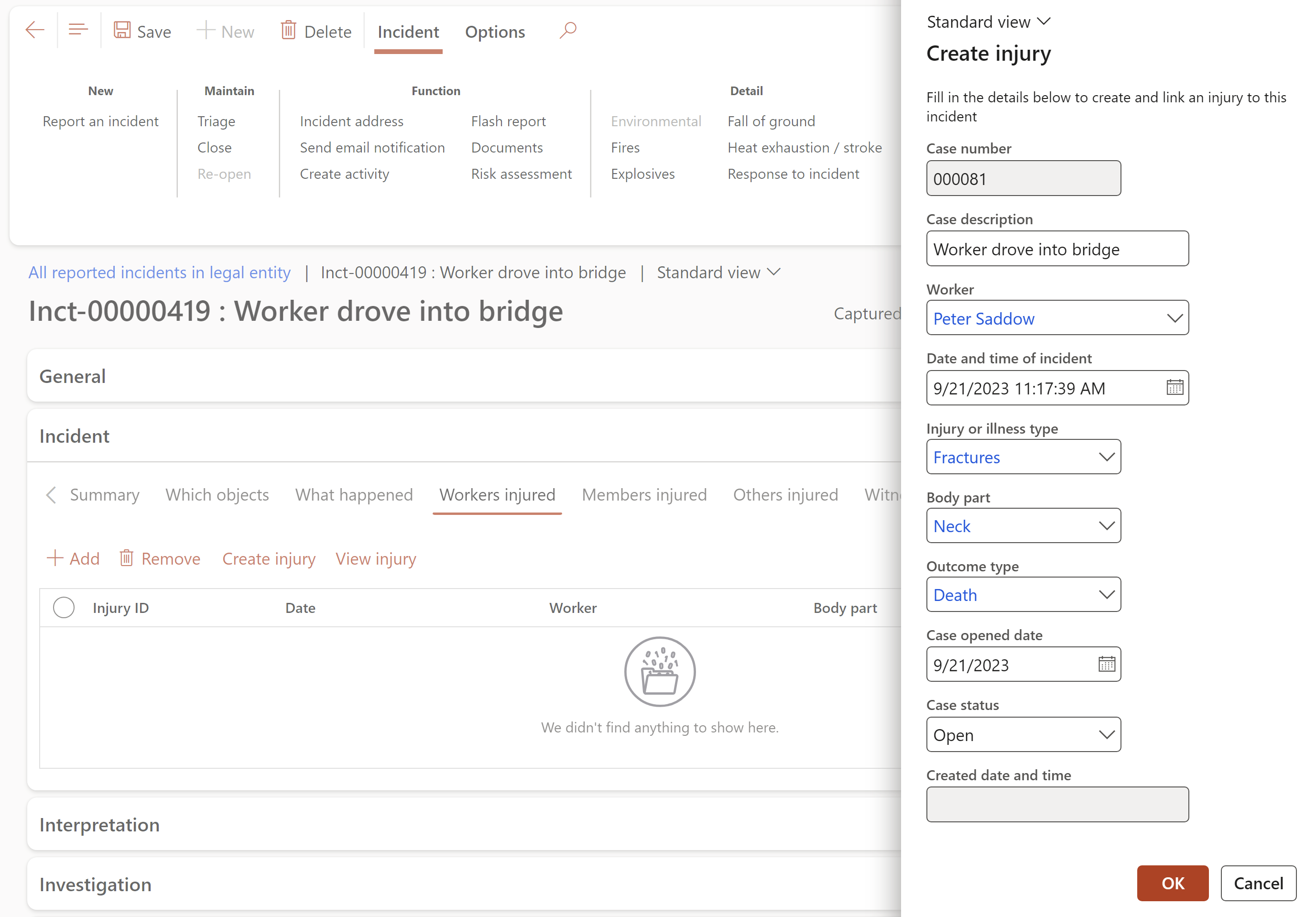
- To view the details of the selected injury, click on the View injury button in the Button strip

- The Members injured Index tab allows you to capture information of injured people that are members at the company. (i.e., club members)
- Select the Member from the drop-down list
- Select the relevant Outcome type from the drop-down list
- Indicate whether the injured person was a Minor (under 18 years old)
- Indicate whether the injury was Preventable
- Enter additional information in the Note box provided
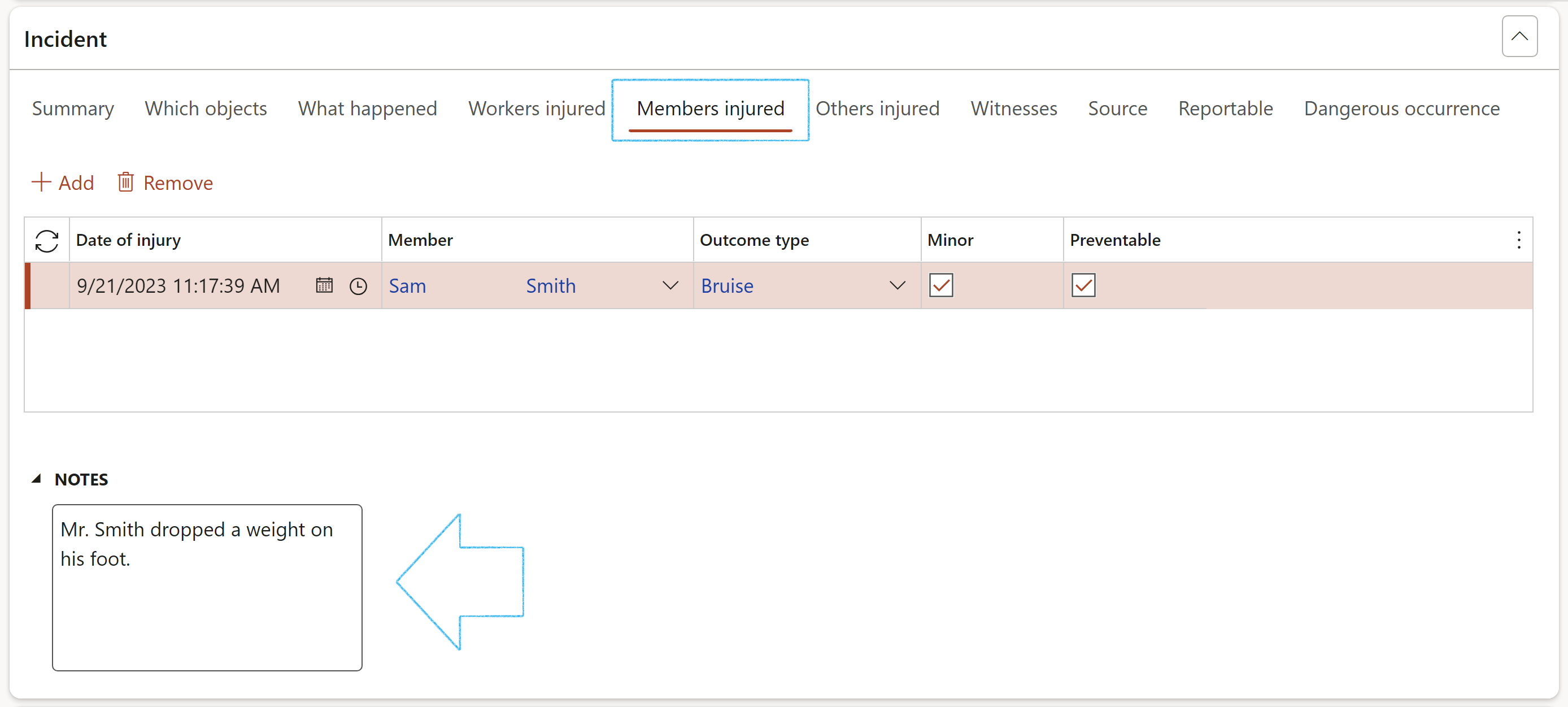
Only members created as described under Step 16 will be on the Member dropdown list
- The Others injured Index tab allows you to capture information of injured people that are not necessarily workers at your company. They could be contractors or visitors, which means they are a 3rd party involved in the incident.
- Select the relevant Outcome type from the drop-down list
- Indicate whether the injured person was a Minor (under 18 years old)
- Indicate whether the injury was Preventable
- Enter additional information in the Note box provided

- The Witnesses Index tab allows you to capture information of witnesses that are not necessarily workers at your company. They could be contractors or visitors, which means they are a 3rd party who witnessed the incident.
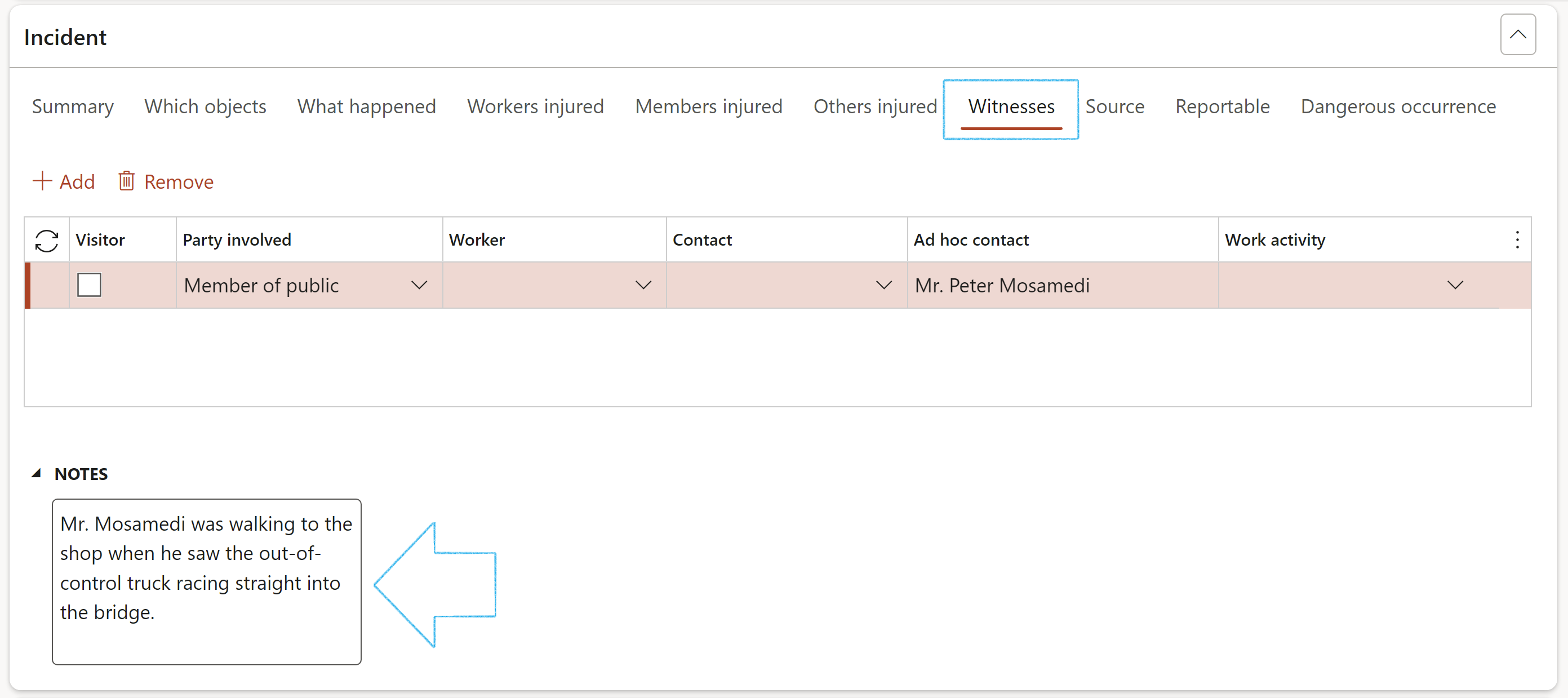
- The Source Index tab provides a free text field where the user can enter a brief description of the source of the incident
- If the incident was created from a project, the Project ID and Project name will be displayed

- The Reportable index tab will only be available if Yes is selected for reportable on the Summary index tab. Multiple Reporting agencies can be added but only ONE can be marked as Primary
- An email can be sent to the Contact person selected on the Reporting agency
- The Reporting category for the selected Reporting agency is displayed. Reporting categories can be added/removed
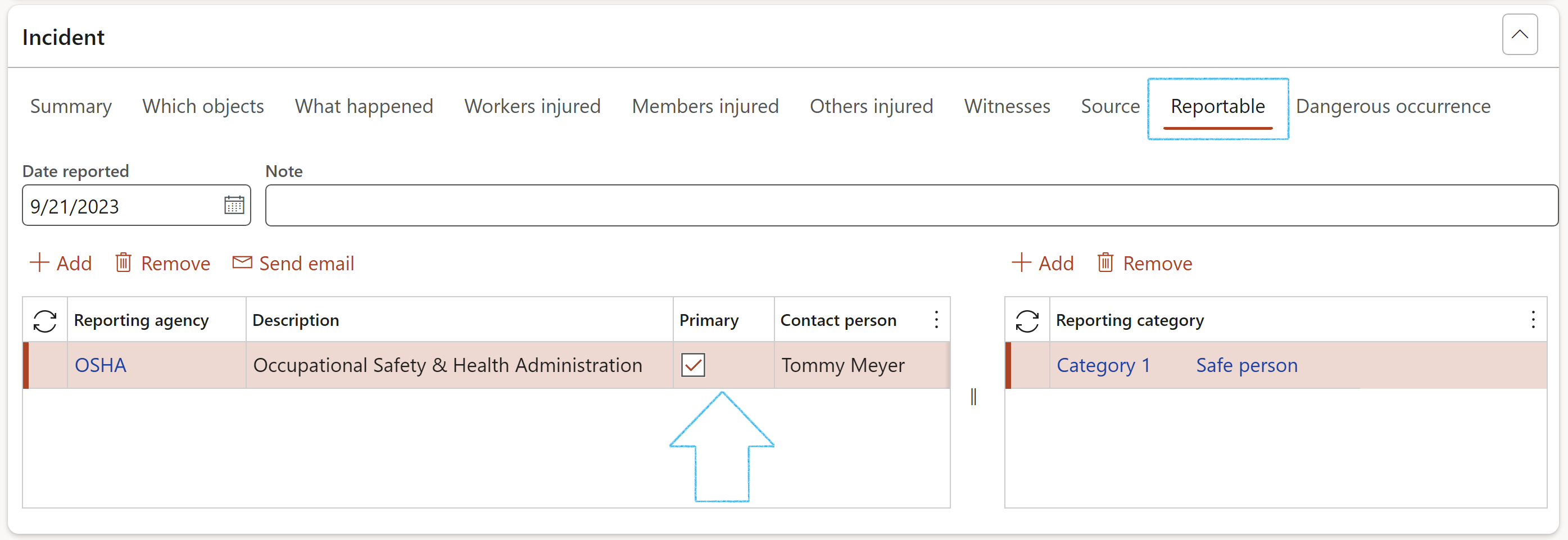
- The Dangerous occurrence Index tab allows the user to select multiple dangerous occurrences per incident. The Dangerous occurrence index tab is only available if the user has selected a Primary reporting agency under the Reportable index tab.

Some of the relevant fields populated under the Incident detail form (as described above) will be passed to the relevant workers' injury records (Injury or illness incidents form) in the HR module.
¶ Step 21: The Interpretation Fast tab
The Basic probable cause as well as the Underlying causes of the incident are recorded by specifying Cause and Non-conformance by using the index tabs at the top of this Fast tab. All the selections are made in the Tree view.
To select the Primary probable cause:
- Open the Cause Index tab
- Select the relevant Basic cause from the dropdown list
- Under the SECONDARY CAUSES field group, click on the Add button
- Select the relevant Cause from the dropdown list
- Select the relevant Cause type from the dropdown list
- Select the relevant Life saving rule from the dropdown list (if applicable)
- Indicate whether the 5 WHY investigation method should be used
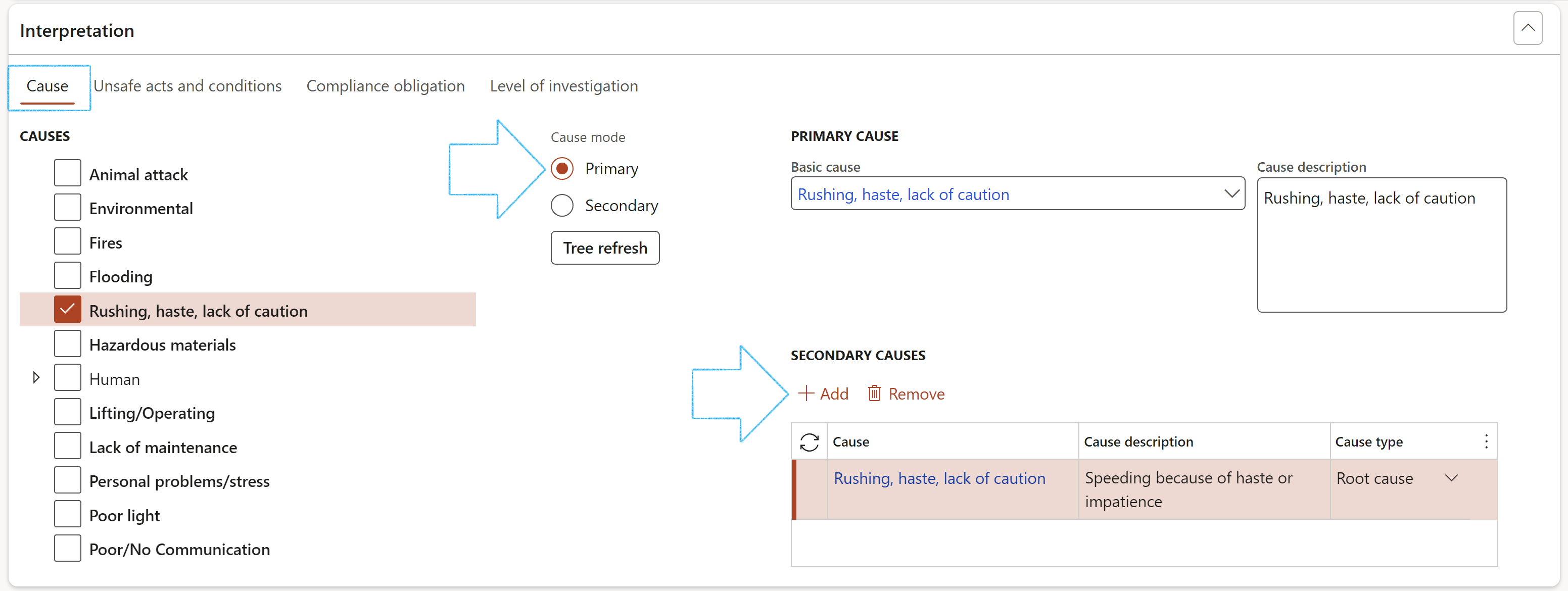
Only one Basic cause can be selected for an incident
- The underlying causes can be done by the subsequent investigation team by working on the Investigation form
- The Unsafe acts and conditions Index tab allows the capturing of the following details:
- Details of the non-conformance
- Root cause of non-conformance
- Corrections (solutions)
- Corrections verification and close out
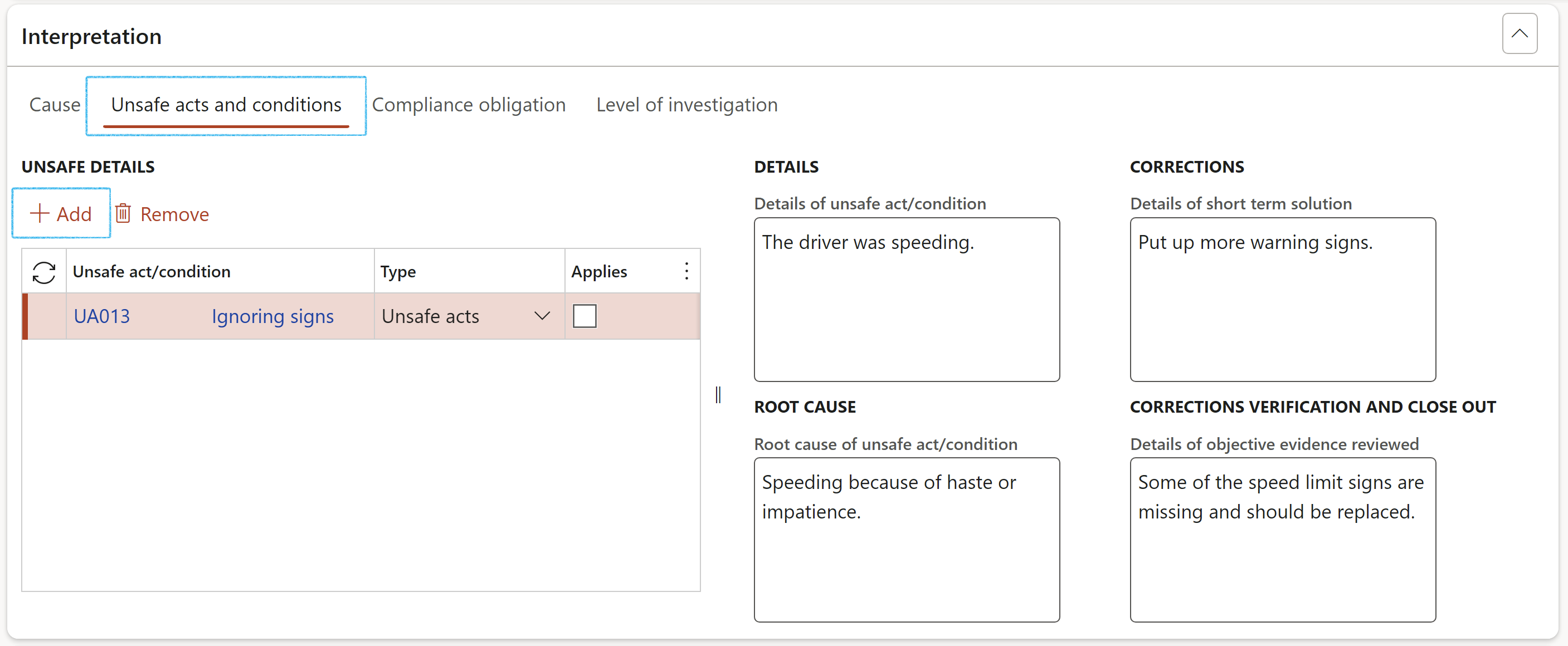
- Under the Compliance obligation Index tab, the user can select the relevant Organisation application (if applicable)

- The Level of investigation Index tab allows the capturing of the following details:
- Likelihood of the incident occurring
- Impact if the incident does occur
The level of investigation is displayed

Based on the reason and consequence, Dynamics 365 HSE will decide (based on the rules on the parameter form) what the Level of investigation level of details should be.
¶ Step 22: The Incident costs Fast tab
- Click the Add button to add details about the costs relating to the incident
- Select the Date on which the cost of the incident was acquired
- Select the Cost type of the incident
- Enter the cost Amount of the incident
- The documents/attachments icon in the Documents field will indicate whether a document has been attached
- Tick the Claimable tick box if the costs of the incident may be claimed back
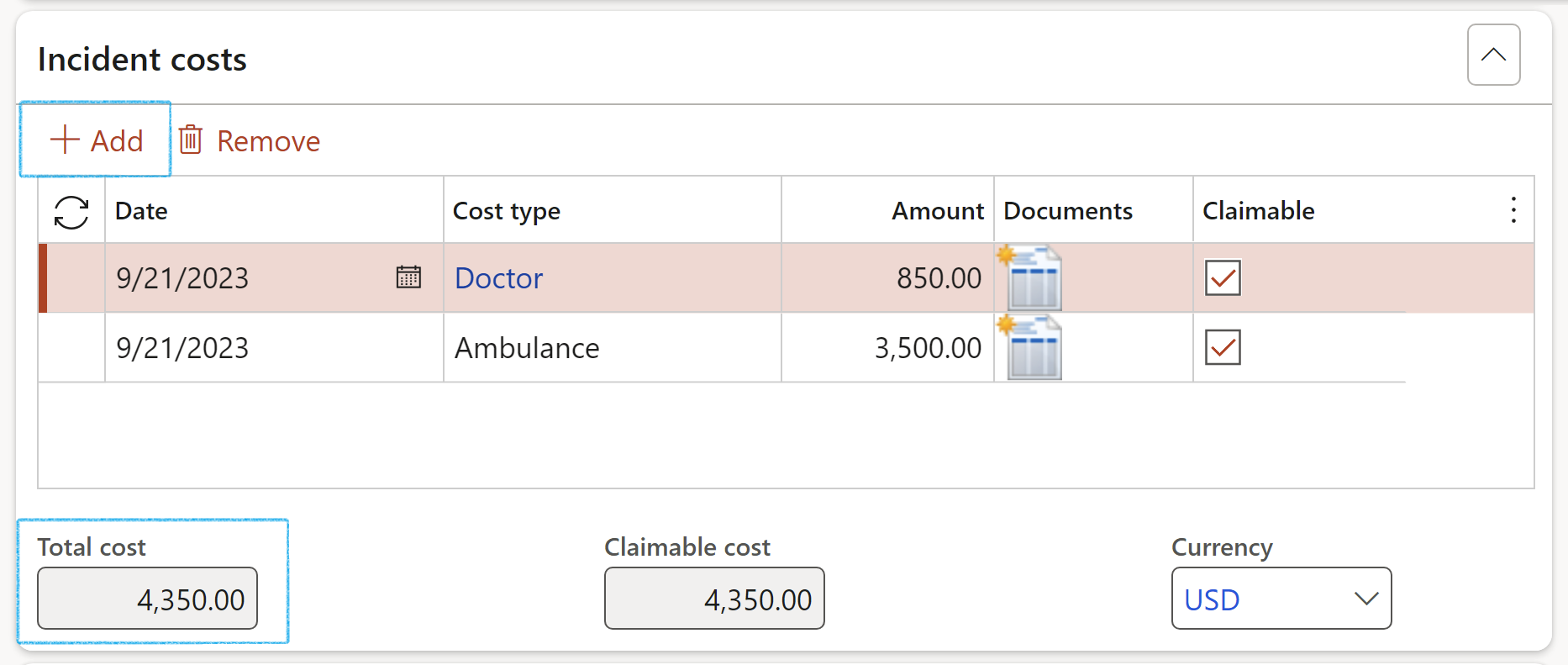
- The amount in the Total cost field will be passed to the investigation that it is linked to
- For details on the Investigations Fast tab, please refer to Step 27 below
¶ Step 23: The Claims Fast tab
- In the Button strip, click on the Create claim button
- Enter a Description for the claim
- Select the relevant Policy from the drop-down list
- Select the relevant Claim type from the drop-down list
- The Claimable cost field will be populated with the claimable cost entered under the Incident cost Fast tab
- Click on OK
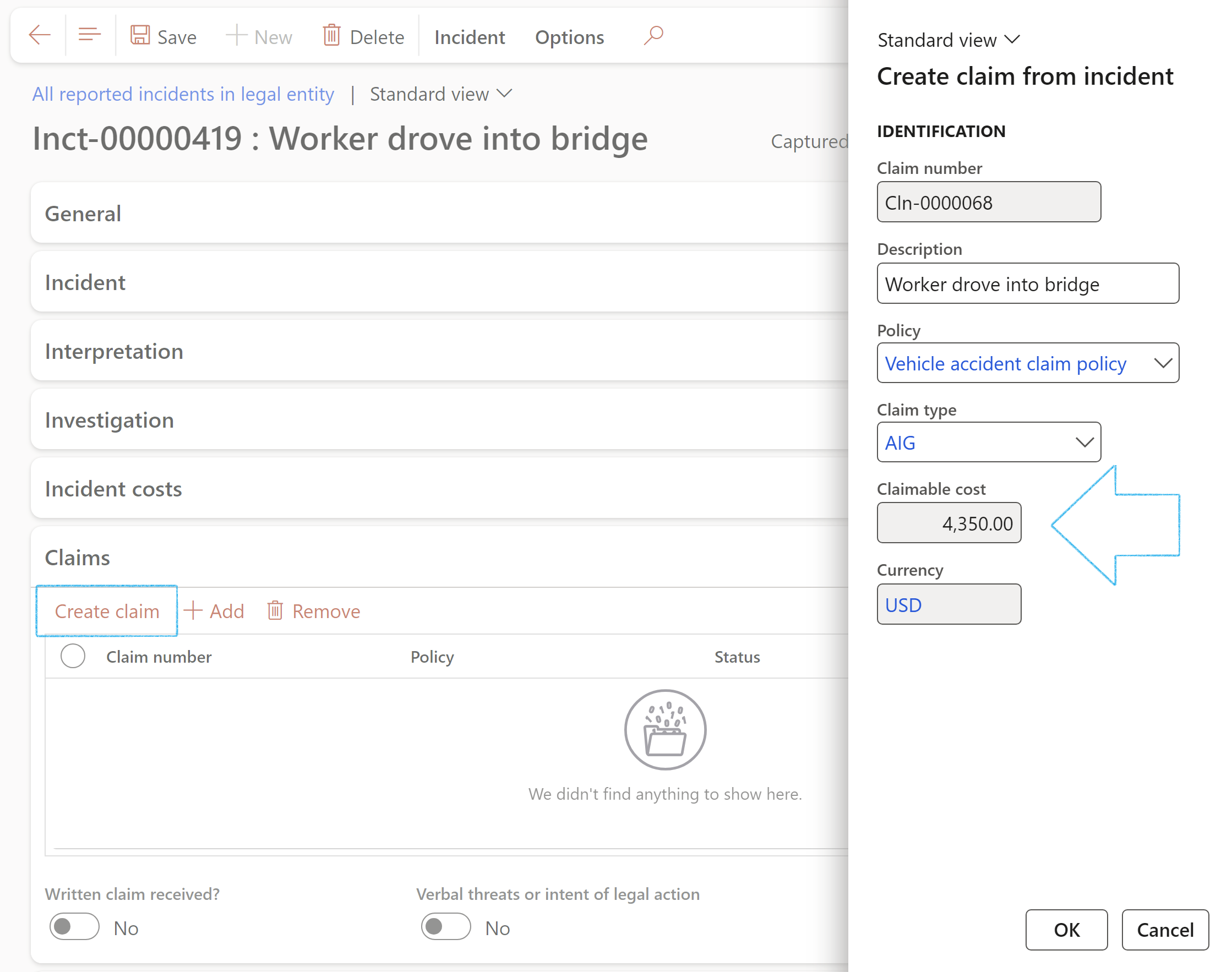
A message will pop up to inform the user if a claim has already been created from this incident
OR
- Click on the Add button
- Select the relevant Claim number from the dropdown list
- Indicate whether a written claim was reseived
- Indicate whether there are verbal threats or intent of legal action

The detail of the selected claim will be displayed when you refresh the page or click on Save
¶ Step 24: The Conclusion Fast tab
- Open the Lessons learned Index tab
- Enter Lessons learned in the box provided
- The Action taken by employer based on last investigation will be displayed

- Open the Activity Index tab
- Enter the Due date for the activity
- Select the Responsible person for the activity
- Enter a Description
- Select the Priority
- On the Action pane, click on the Create activity button and select the relevant action from the dropdown list
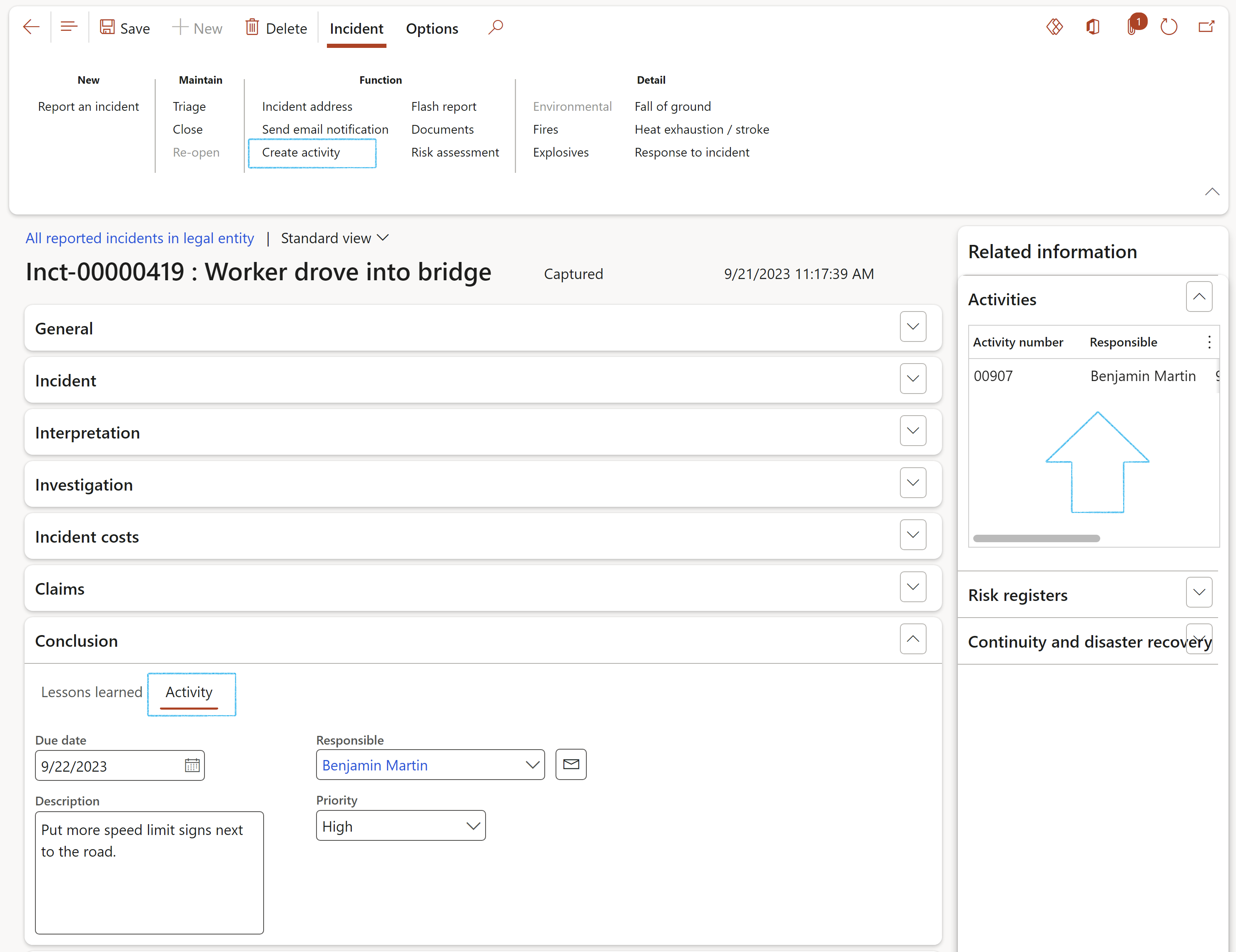
¶ Step 25: The Associations Fast tab
The Associations Fast tab offers the user the option to add items or other entity types to be linked to the incident. There might be a lost air pump on board a boat during the incident which can be accounted for.
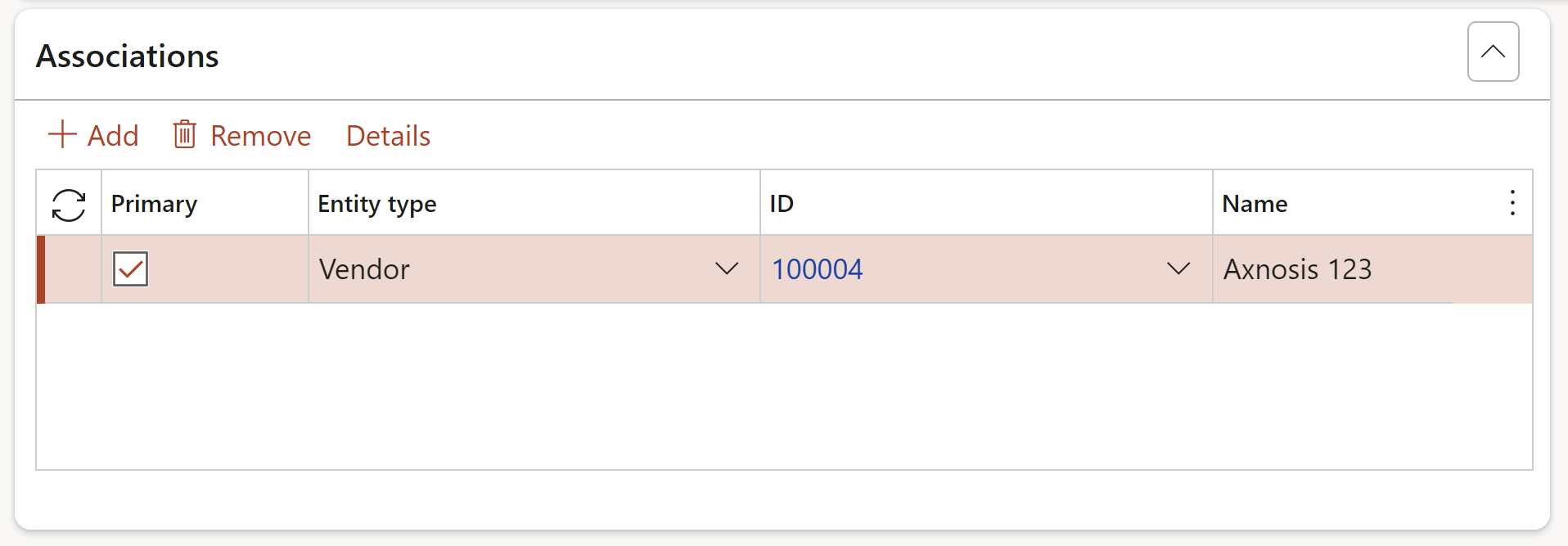
¶ Step 26: Close the incident
- On the Action pane, in the Maintain group, click on the Close button
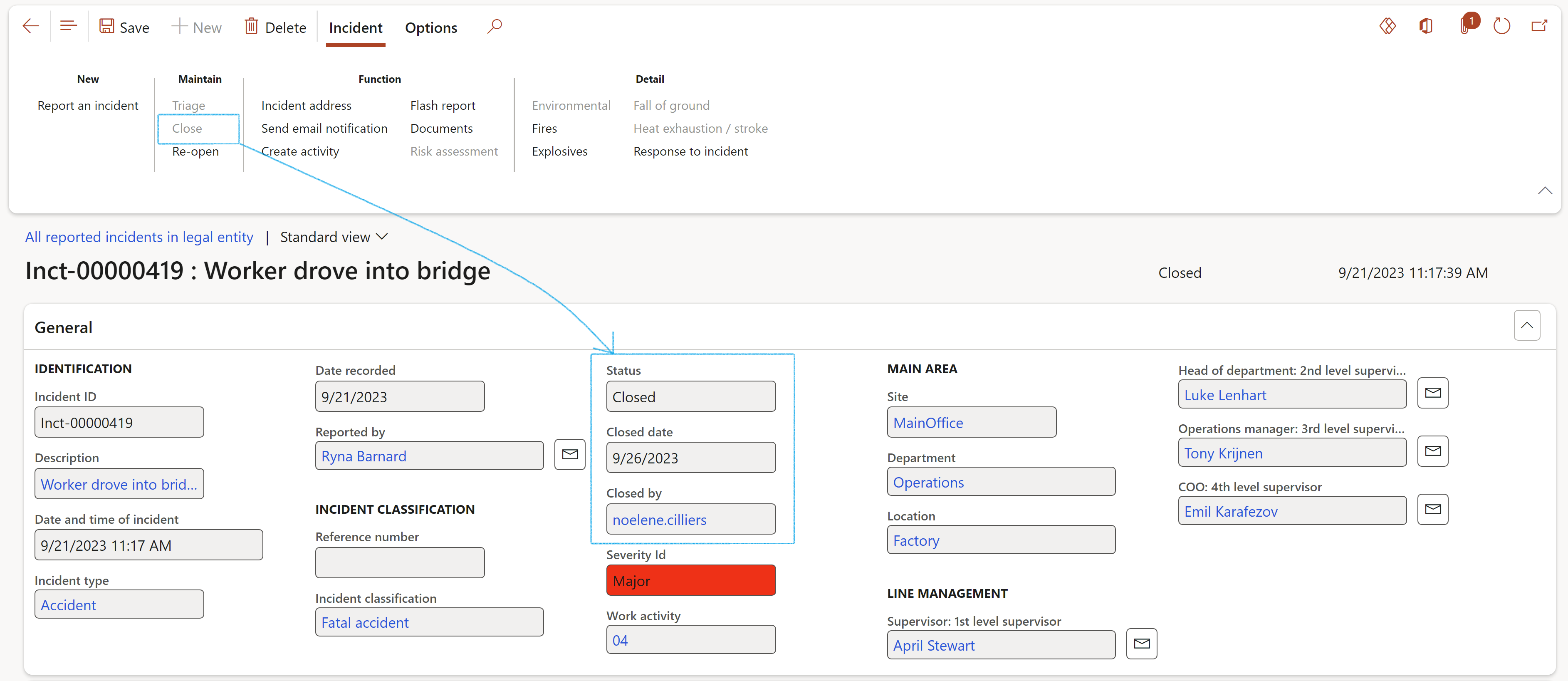
- The Status of the incident changes to Closed
- The Closed date is automatically populated with today’s date
- The logged in user’s name will populate the Closed by field
- Once the incident is closed, the recorded information cannot be edited
When the linked Investigation is Closed, the above-mentioned points will also occur
¶ Step 27: Policies
An incident policy refers to a plan that outlines an organization’s reaction to an incident. A standard policy usually comprises of the composition of incident policy team within the company, the role of the various team members, the individuals responsible for policy testing, the means, resources and tools that will be needed for recovery and how to put the plan into action.
Go to: HSE > Incidents > Policies
- On the Action pane, click on the New button
- Complete the New policy dialog
- Click OK
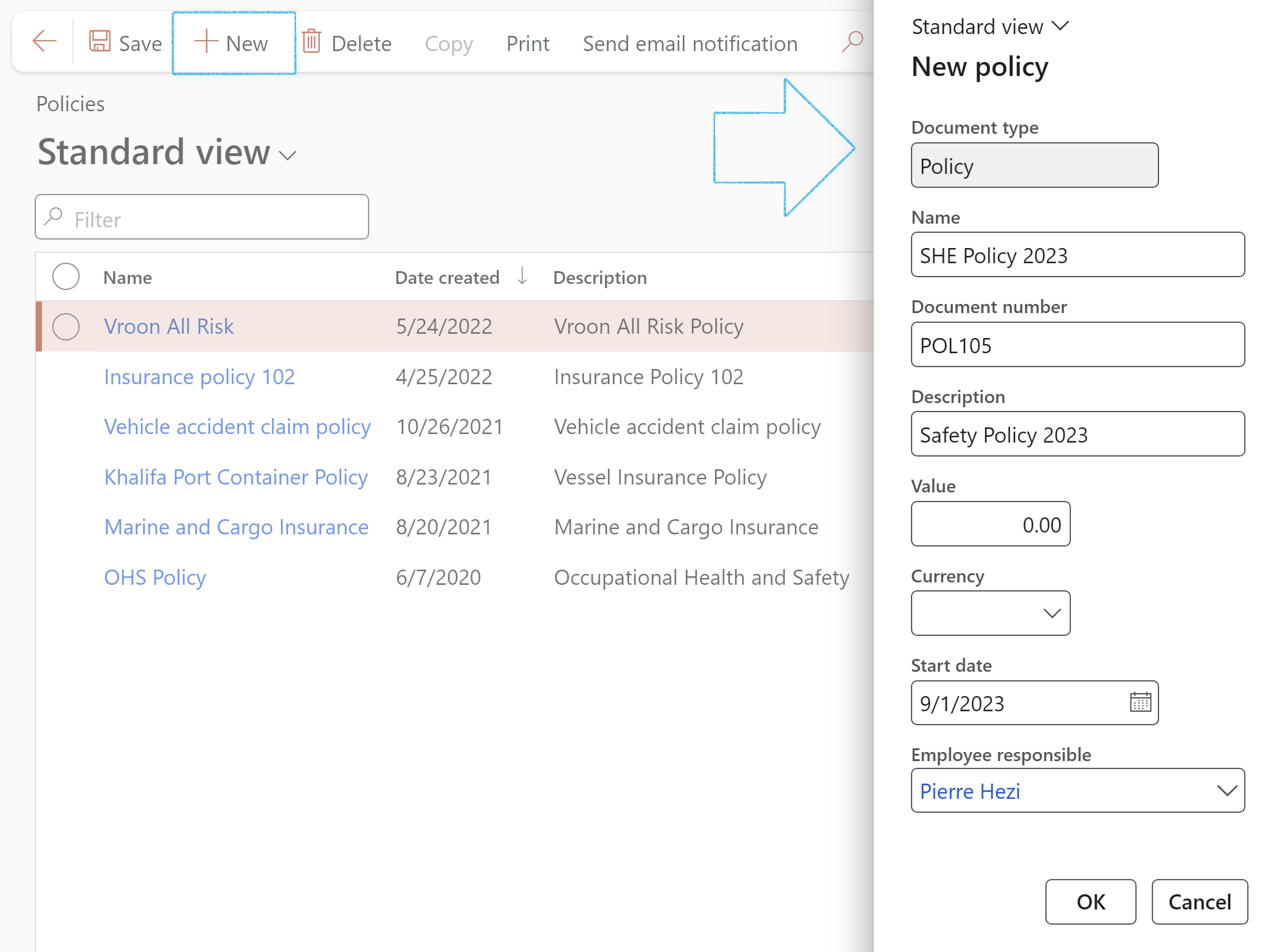
¶ Step 27.1: The Content Fast tab
- Expand the Content Fast tab
- Under the Cover page Index tab:
- The Document type field will be populated with Policy
- Indicate whether this is an Insurance type policy
- Enter a SharePoint URL
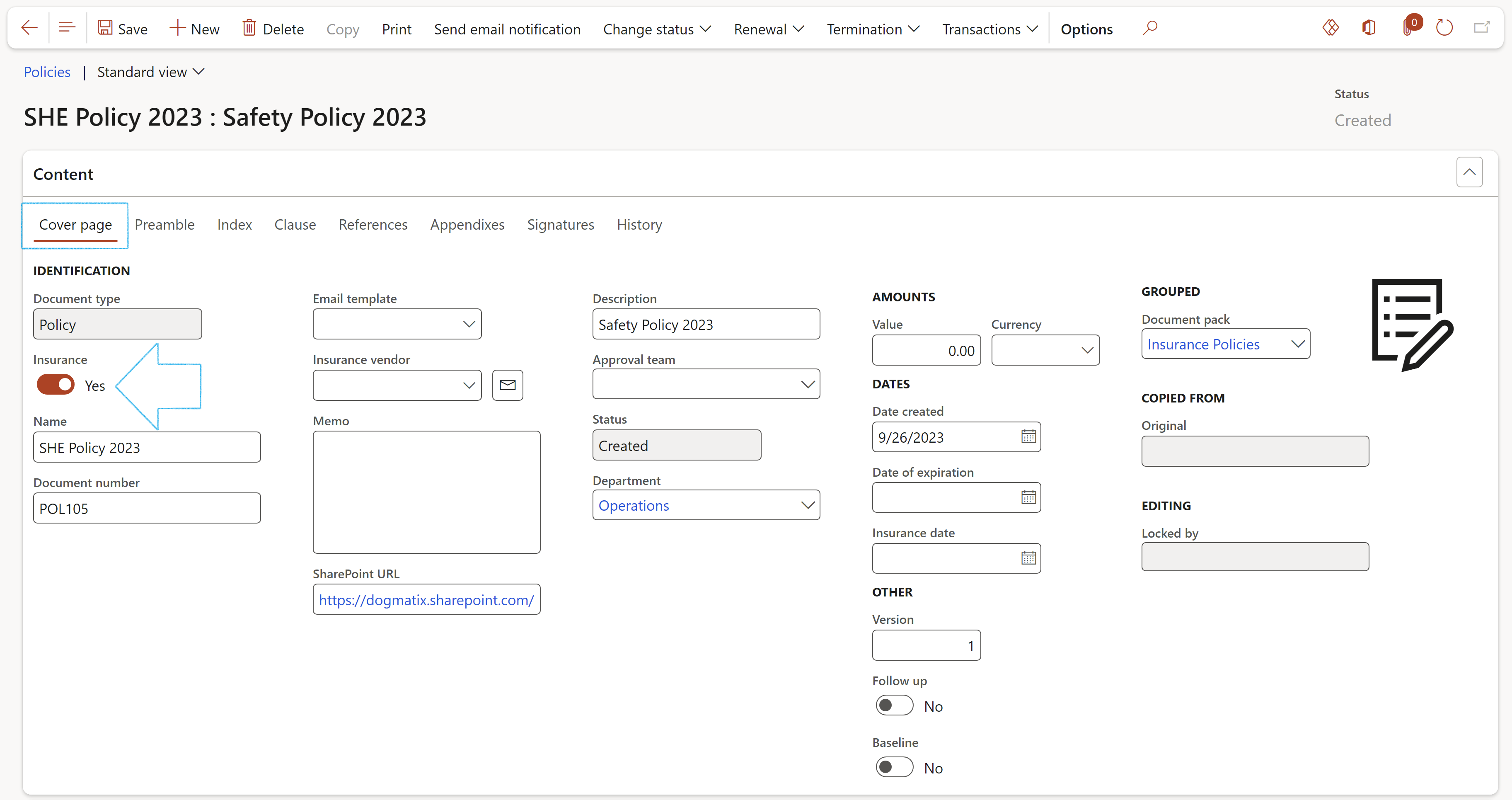
- Under the Clause Index tab:
- In the Button strip, click on the Add button
- The Clause number will be generated by the system
- Select the Heading (Heading 1 for a primary heading, Heading 2 for a secondary heading)
- Enter a Description
- Use the box provided to type the Clause definition
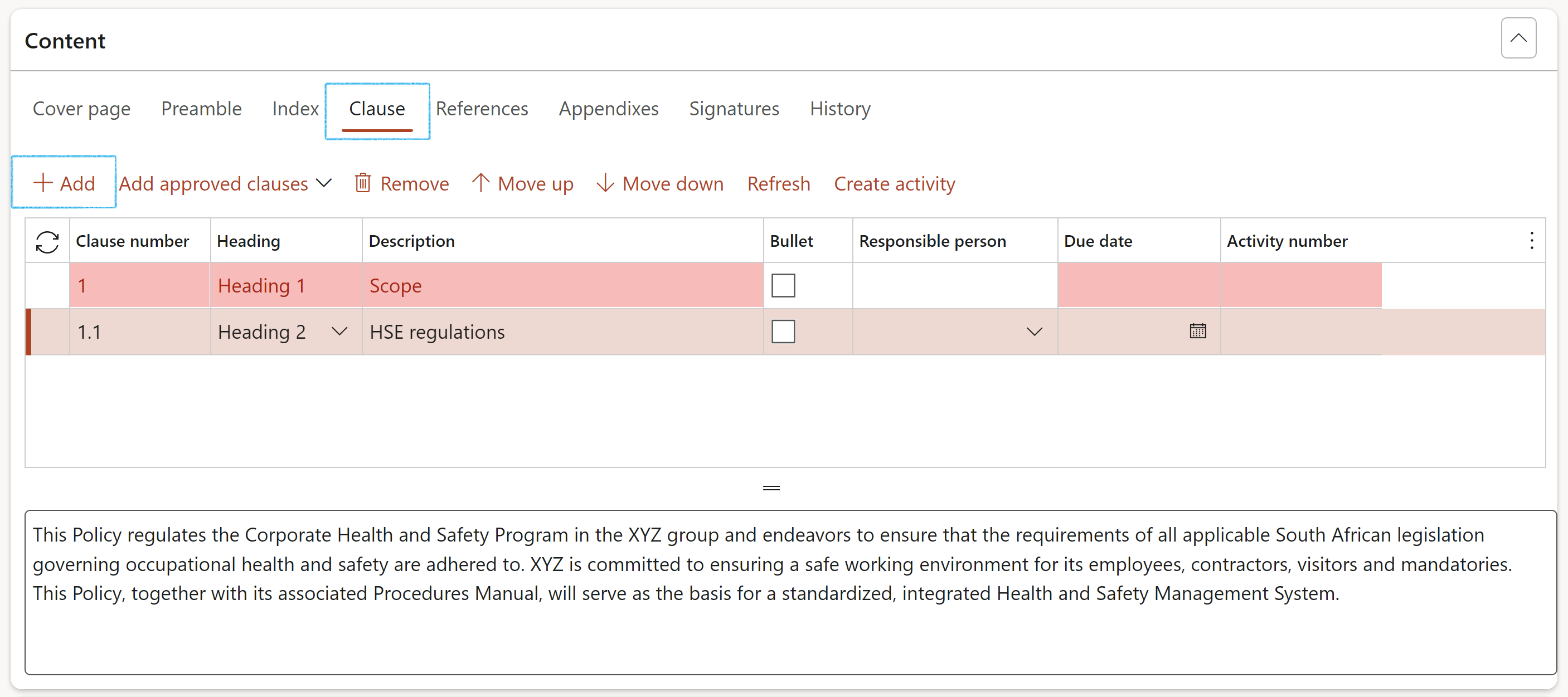
- Under the Signatures Index tab:
- Enter a Signature description
- Enter the Internal signature details
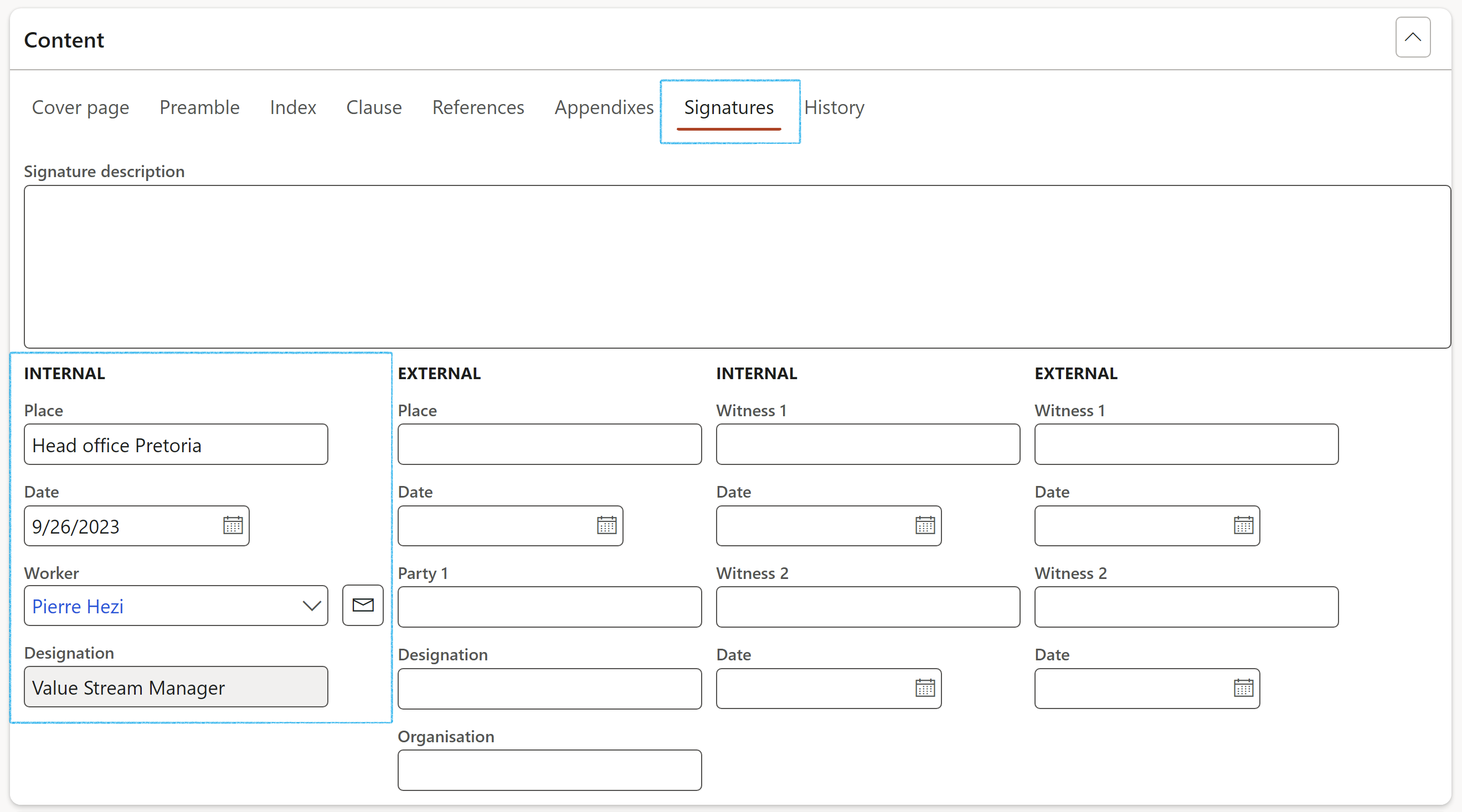
¶ Step 27.2: Policy statuses
| Status | Rules |
| Created |
|
| Draft |
|
| Receive |
|
| Submit |
|
| Approve |
|
| Revise |
|
| Reject |
|
| Archive |
|
¶ Next steps
¶ Step 28: Create an investigation
An investigation can be created directly from the Incident detail form:
Go to: HSE > Incidents > All reported incidents in legal entity
- Select the incident that you want to create the investigation for
- Expand the Investigation Fast tab
- In the Button strip, click on the Create investigation button. The Select investigation parameter dialog will open
- In the Responsible field, select the worker responsible for the investigation from the list
- Enter a brief Description
- Select the worker who has to be notified of the investigation from the list
- Click OK
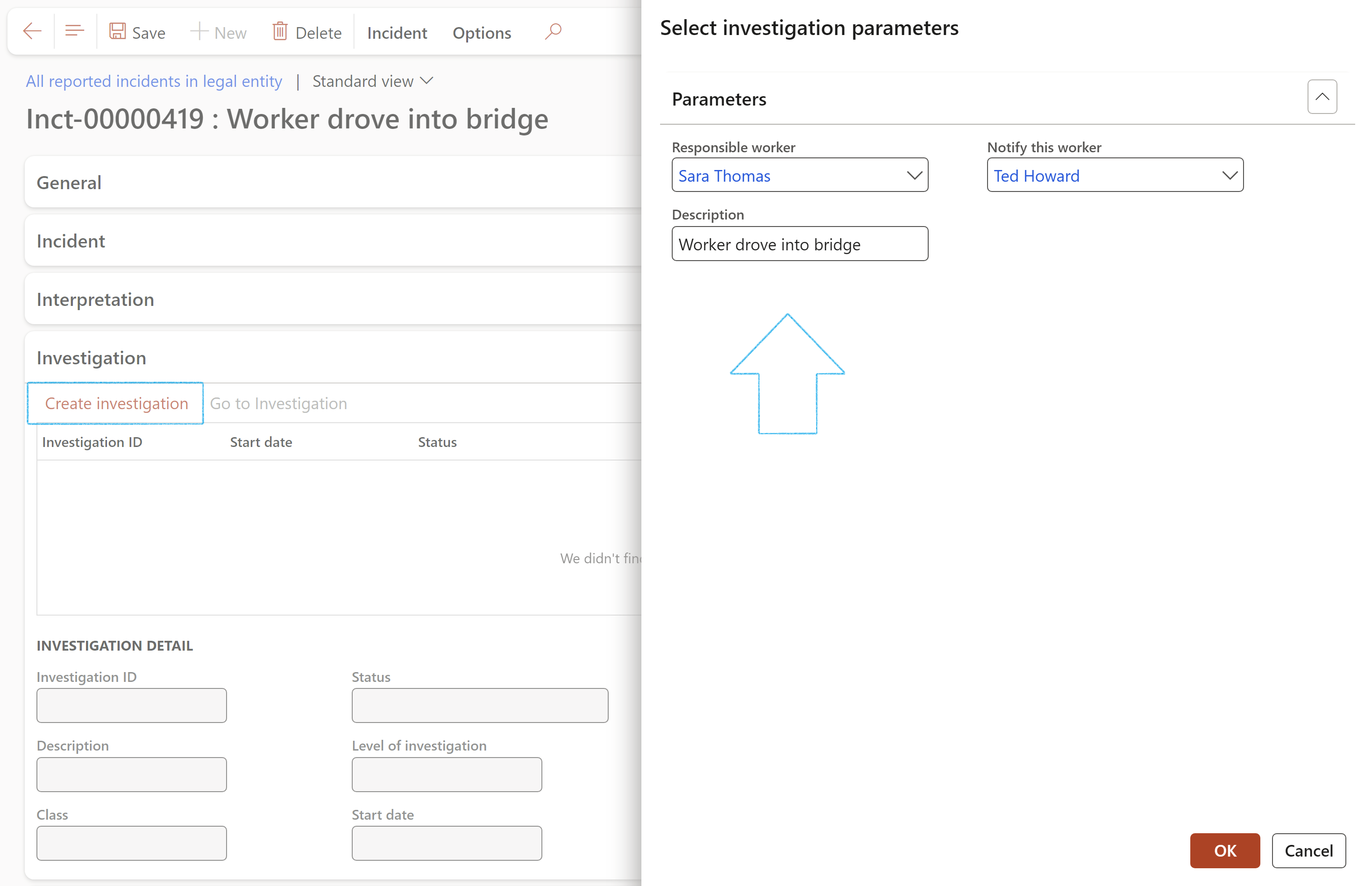
- The Investigation detail form will open where the user can add more detail
- Refer to the Wiki page on Investigations
Detail of the investigation will now be displayed on the incident form under the Investigation Fast tab
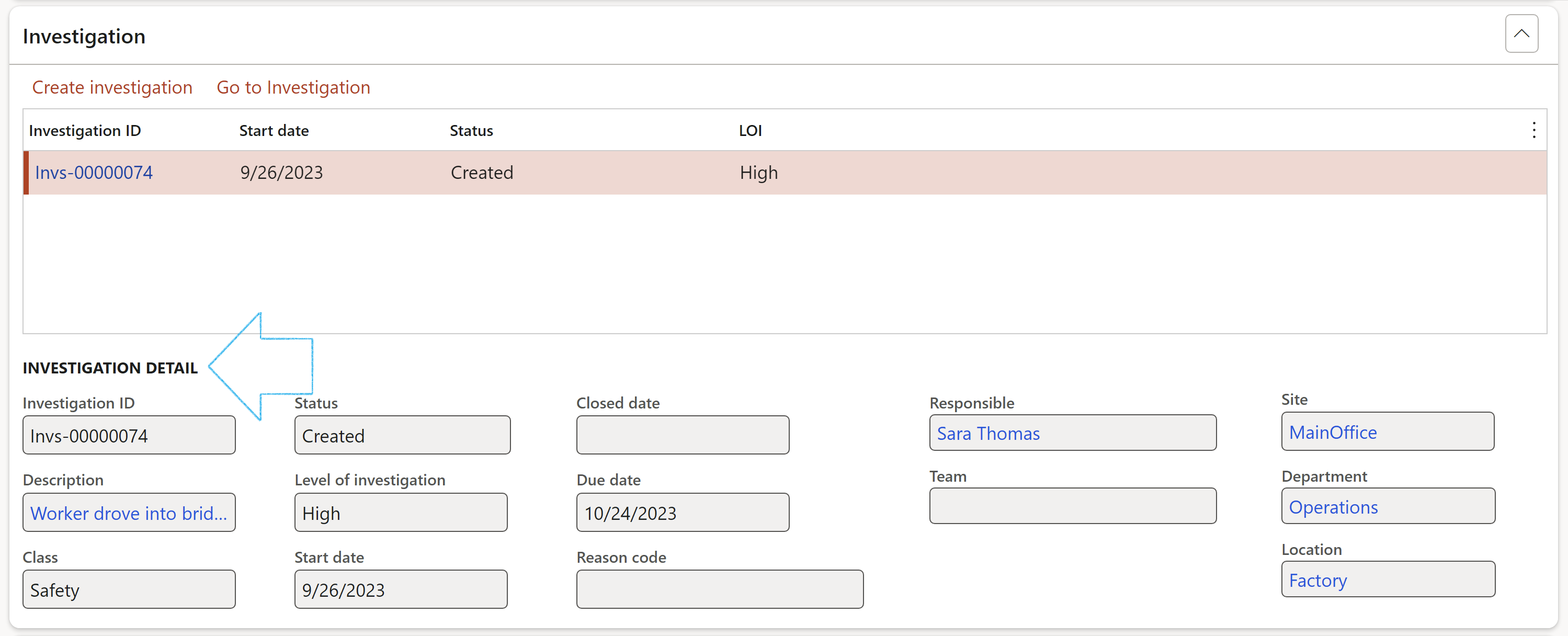
¶ Step 29: Using the HR Injury or illness incident form
Go to: Human resources > Workers > Injury and illness > Injury or illness incidents
The Action pane offers additional actions and functions:
- New – Opens up a new investigations form where the details of a new case can be captured.
- Delete – Removes the selected record.
- Status – Update the status of the investigation by selecting the relevant status from the dropdown list when you click on the Status button. The updated status can be seen in the General Fast tab.


Attachments – The document handling functionality can be used to attach files/pictures/documents or notes that are applicable to the investigation
The Injury/illness Fast tabs
Expand one or more Fast tabs to see the additional fields that you can work with on the form. In addition, you can collapse Fast tabs to hide fields that are not relevant to you.
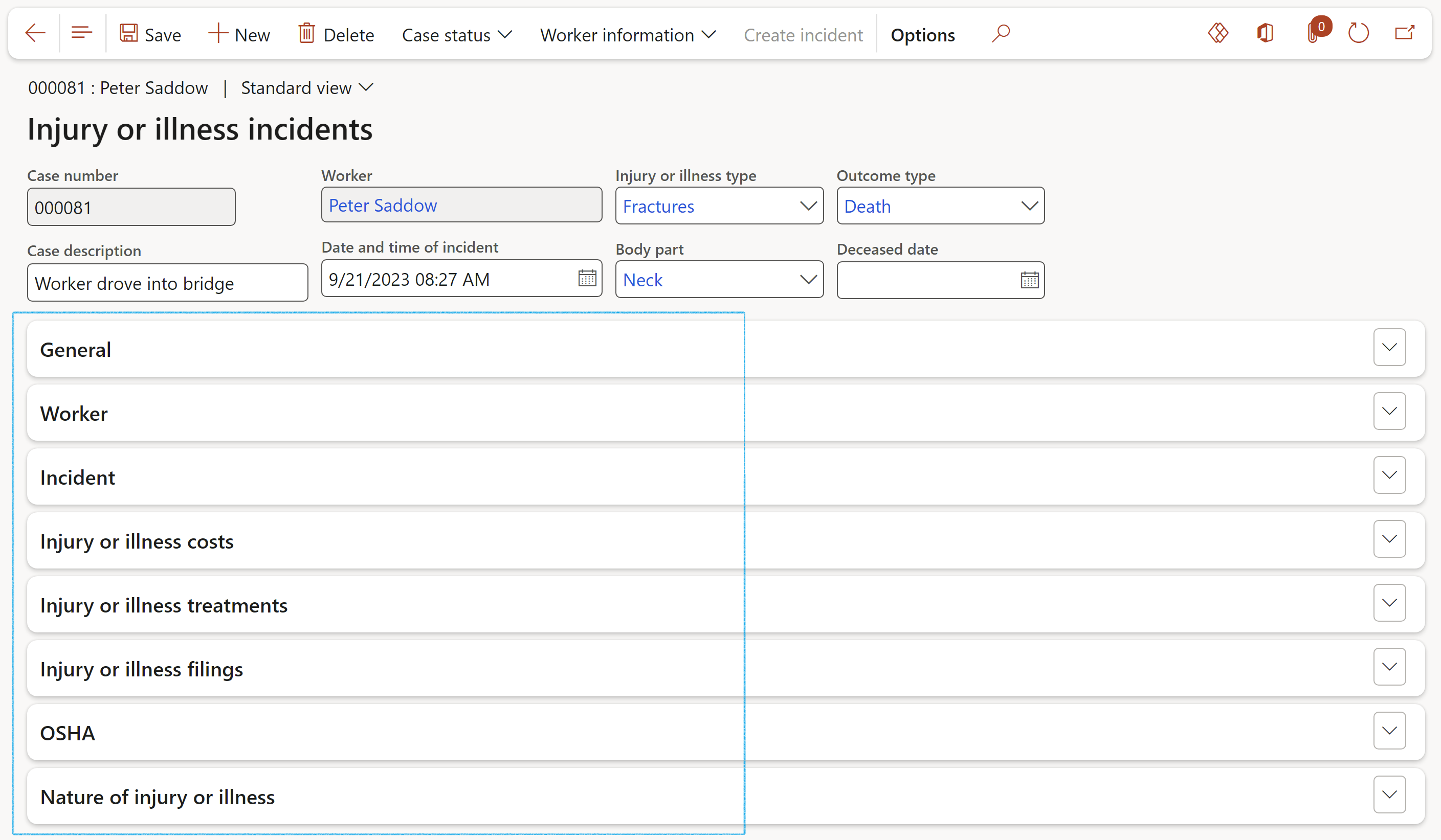
¶ Step 29.1: The General Fast tab
- Enter the case information:
- Date and time reported
- Person who reported the case
- The case status
- The status is displayed as selected in the Action pane
- Enter the Case opened date. If the status is Closed, the date cannot be edited, and the Case closed date field will be populated.

¶ Step 29.2: The Worker Fast tab
- Select the injured worker’s information from the dropdown lists:
- Position
- Supervisor
- Human resources contact

¶ Step 29.3: The Incident Fast tab
- Summary information about the injury or illness can be entered here:
- The Date and time that the worker started work, on the date that the injury occurred
- Severity level
- Safeguards that were provided
- Actions to be taken, etc.
- If this kind of incident has happened before, the incident can be selected from the dropdown list
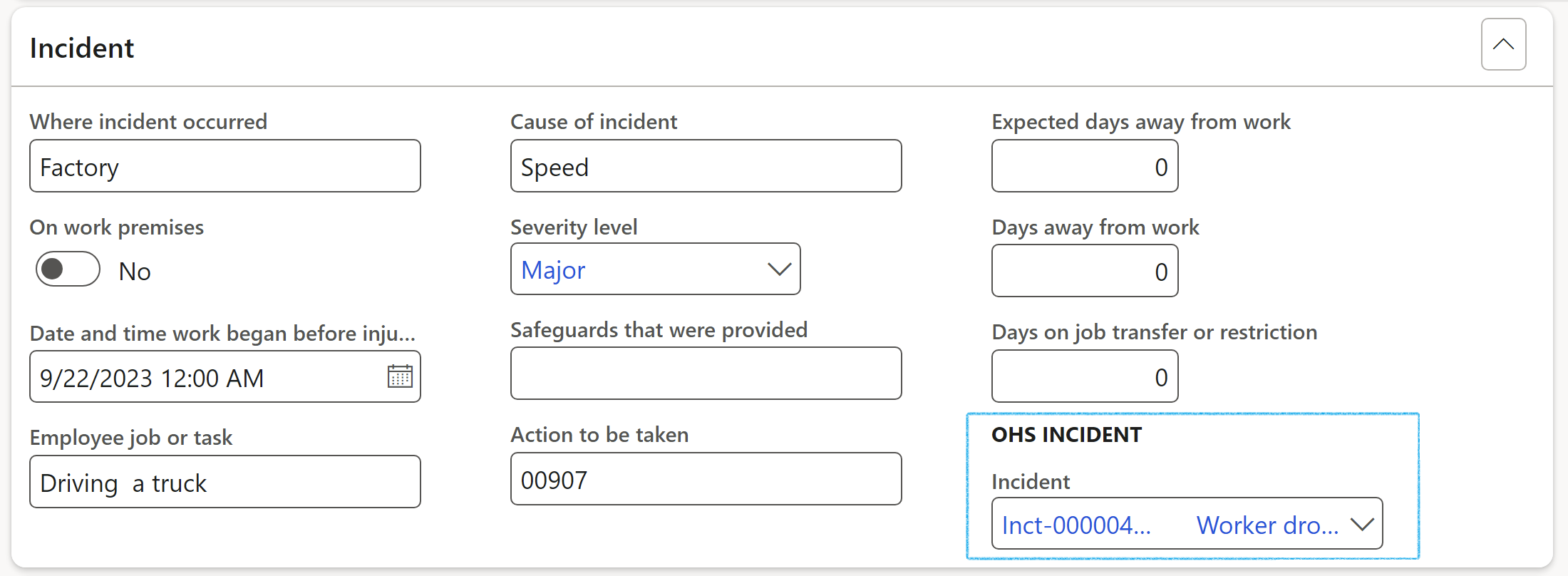
- If this is an incident that has not occurred before, click on the Create incident button on the Action pane

¶ Step 29.4: The Injury or illness cost Fast tab
- Information about the costs involved with the incident can be entered under this Fast tab
- Date
- Cost type (doctor, hospital…)
- Amount
- Documents (invoices, doctor’s notes…)
- The total of the costs is displayed in the Total field at the bottom of the Fast tab
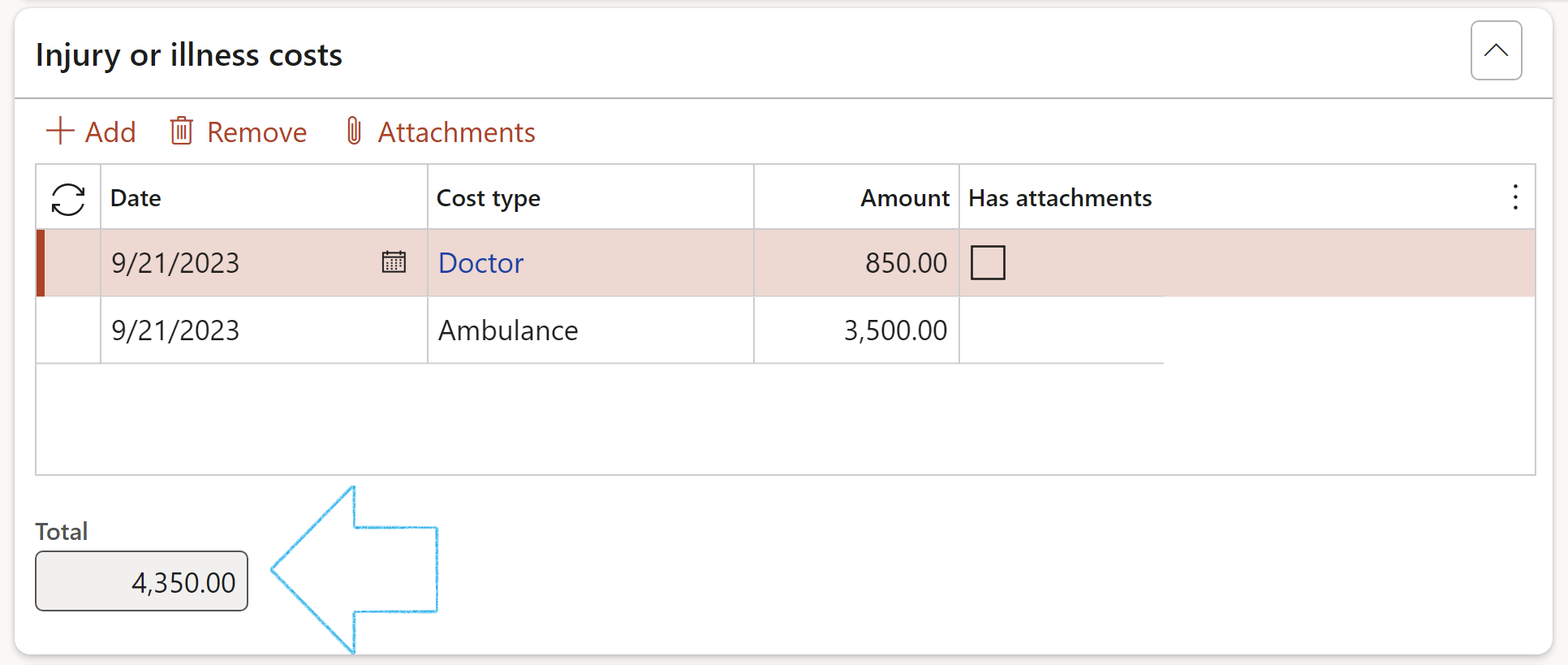
¶ Step 29.5: The Injury or illness treatments Fast tab
- The following information about the treatment that the worker received can be entered under the Treatment group
- Treatment date
- Treatment type
- Treatment comments
- Information about the physician that attended to the worker can be entered under the Primary physician information group

¶ Step 29.6: The Injury or illness filings Fast tab
- Details about the reporting agency are entered here
- Relevant documentation can be attached to this form
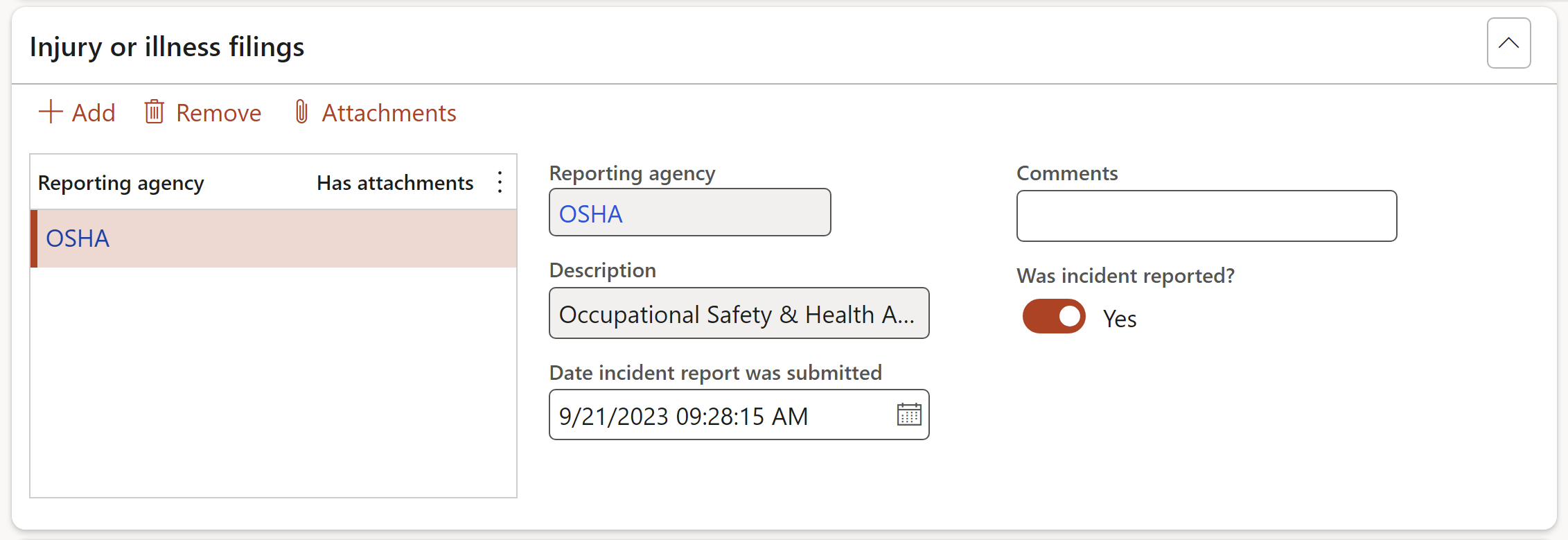
¶ Step 29.7: The Nature of Injury or illness Fast tab
- Details about the nature of the injury or illness is entered here
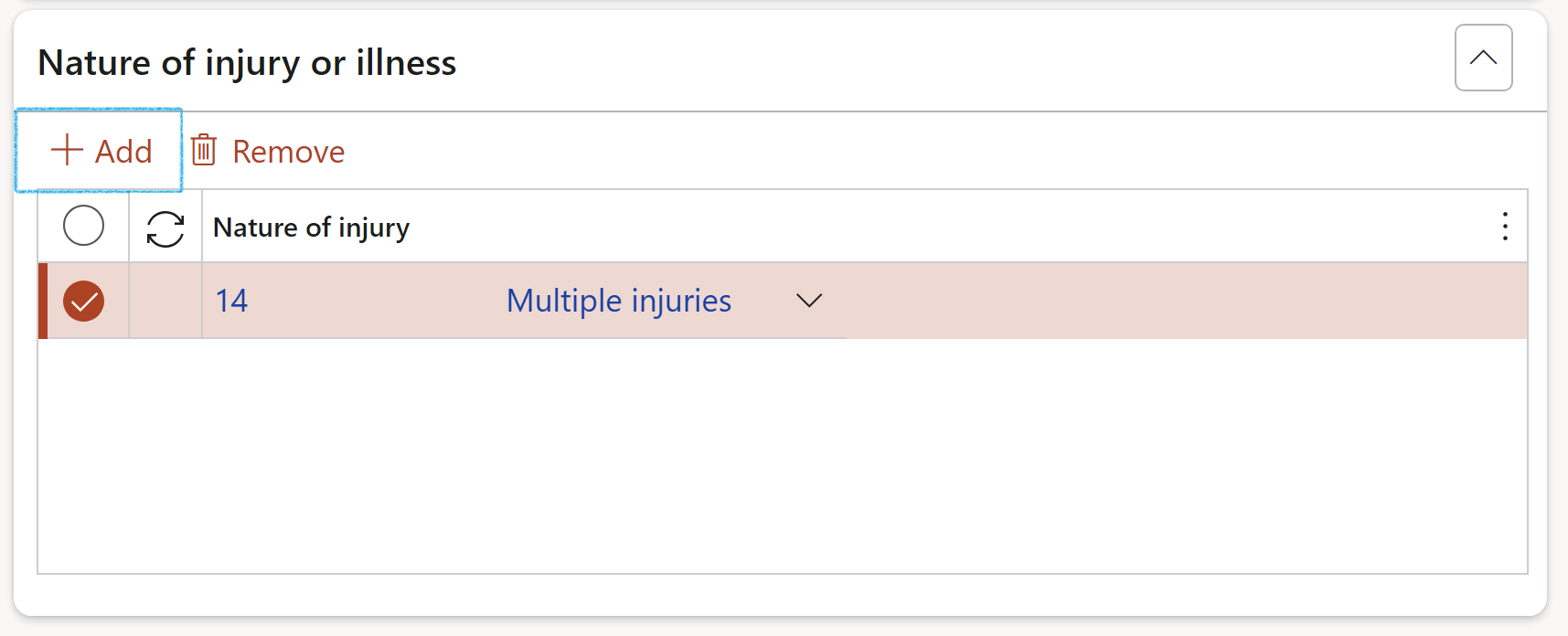
¶ Step 30: Environmental incident
** Environmental** – This button remains greyed-out until the user creates an environmental incident record and selects the Incident type Environmental.
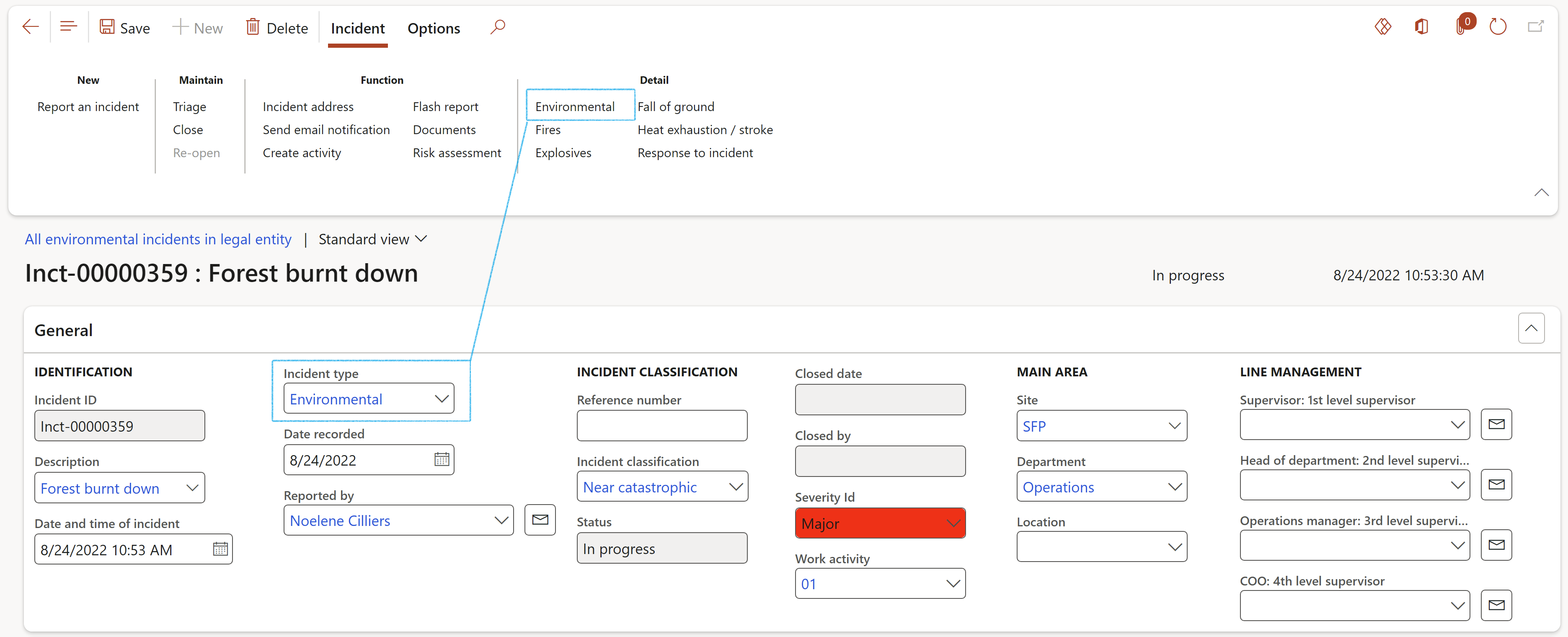
- The Incident environment wizard will guide the user to enter the environmental details of the incident
- Note the Incident number, Incident description and Date and time of incident will pull through from the Incident form
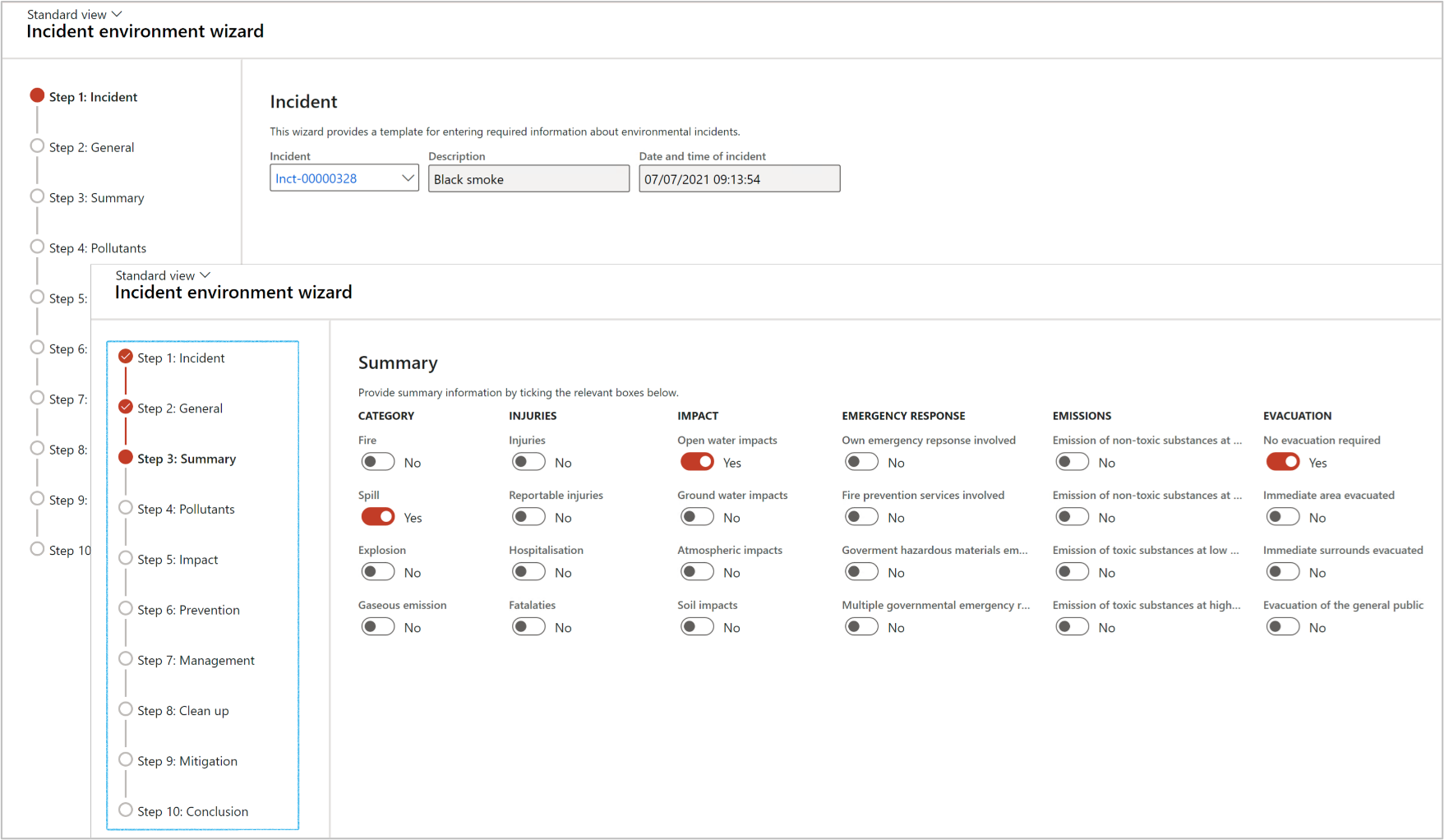
- Under the General bullet, fill in the incident details
- Under the Summary bullet, tick the boxes relevant to the incident
- Under the Pollutants bullet, select from the possible hazards already setup, and complete with all the relevant data
- The Impact bullet is used to describe the impact of the incident
- The Prevention bullet is for describing whether the incident could have been foreseen
- Under the Management bullet, the initial incident management details can be added
- Capture details of the cleanup/decontamination under the Cleanup bullet
- Under the Mitigation bullet, the measure, objective, cost and timing involved in reducing/eliminating the severity of exposure to risks, or minimization of the potential impact can be captured
- Authorisation-, History- and Event summary details are captured under the Conclusion bullet
¶ Step 31: Hours worked
Go to: HSE > Setup > Work force > Hours worked
- Under the General Fast tab, enter the following details:
- In the Year field, enter the annual year value
- Select the relevant Site and Department from the dropdown lists
- In the Months active field, enter the number of operationally active months in the year
- In the Average staff compliment field, enter the average number of staff employed during the year
- In the Estimate hours field, enter the estimated number of hours worked during the year
- In the Actual hours worked field, enter the number of actual hours worked during the year
- In the Hours lost field, enter the estimated number of hours lost during the year
- Expand the Actual hours worked Fast tab
- Enter the number of hours worked per month
- Click on the Daily quantity button
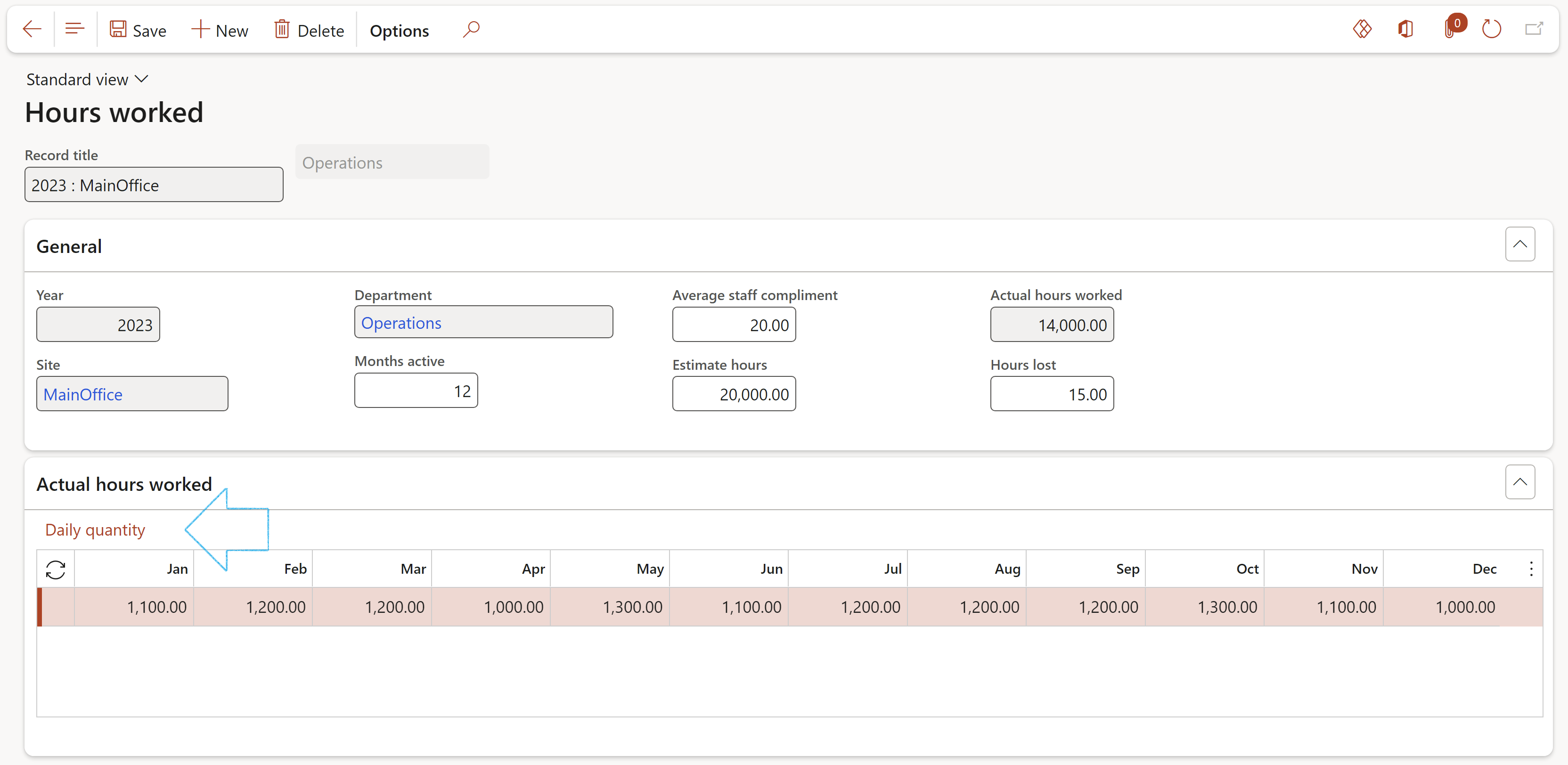
The Hours worked – Daily form will open
- Select the month that you want to update the daily hours worked for
- On the Action pane, click New
- Select the Date that needs to be updated
- Enter the correct quantity of hours worked on that date
- Enter a description of, for example; “Data from the time and attendance”
- Click on the Calculate/update button
- Close the form

The updated value of actual hours worked will be displayed
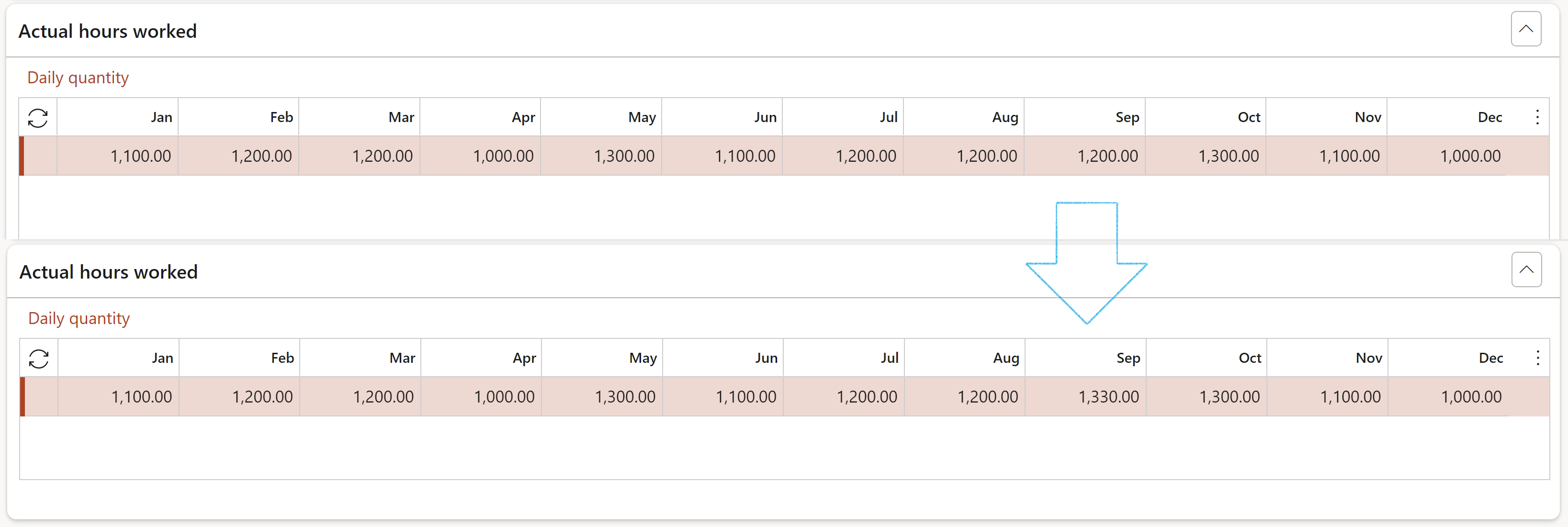
¶ Reporting
Before closing the incident or launching into an investigation, users can print some reports like the cost report.
¶ Step 32: Print Injury cost report
Go to: HR > Workers > Injury and illness > Incident costs report
- Enter the required parameters
- Click OK

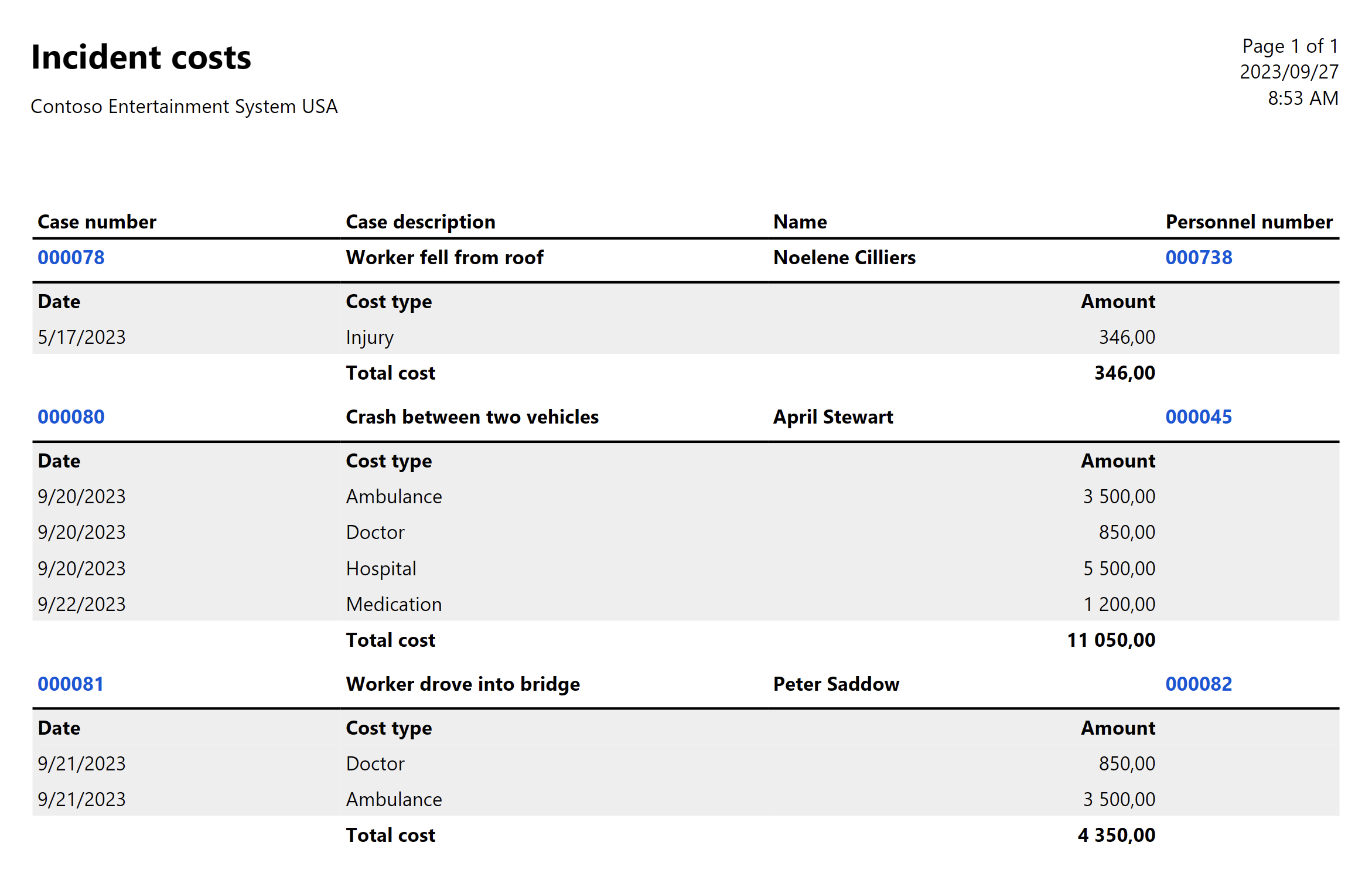
¶ Step 33: Find duplicate incidents inquiry
Go to: HSE > Incidents > Reports and Inquiries > Find duplicate incidents
- Select the Search criteria by:
- ticking the relevant boxes under Incident types
- selecting the relevant site and/or Department under Demarcation
- in the Containing text field, only text fulfilling this regular expression will be part of the result
- Click the Find now button
- Duplicate incidents can be closed by clicking on the Close button on the Action pane
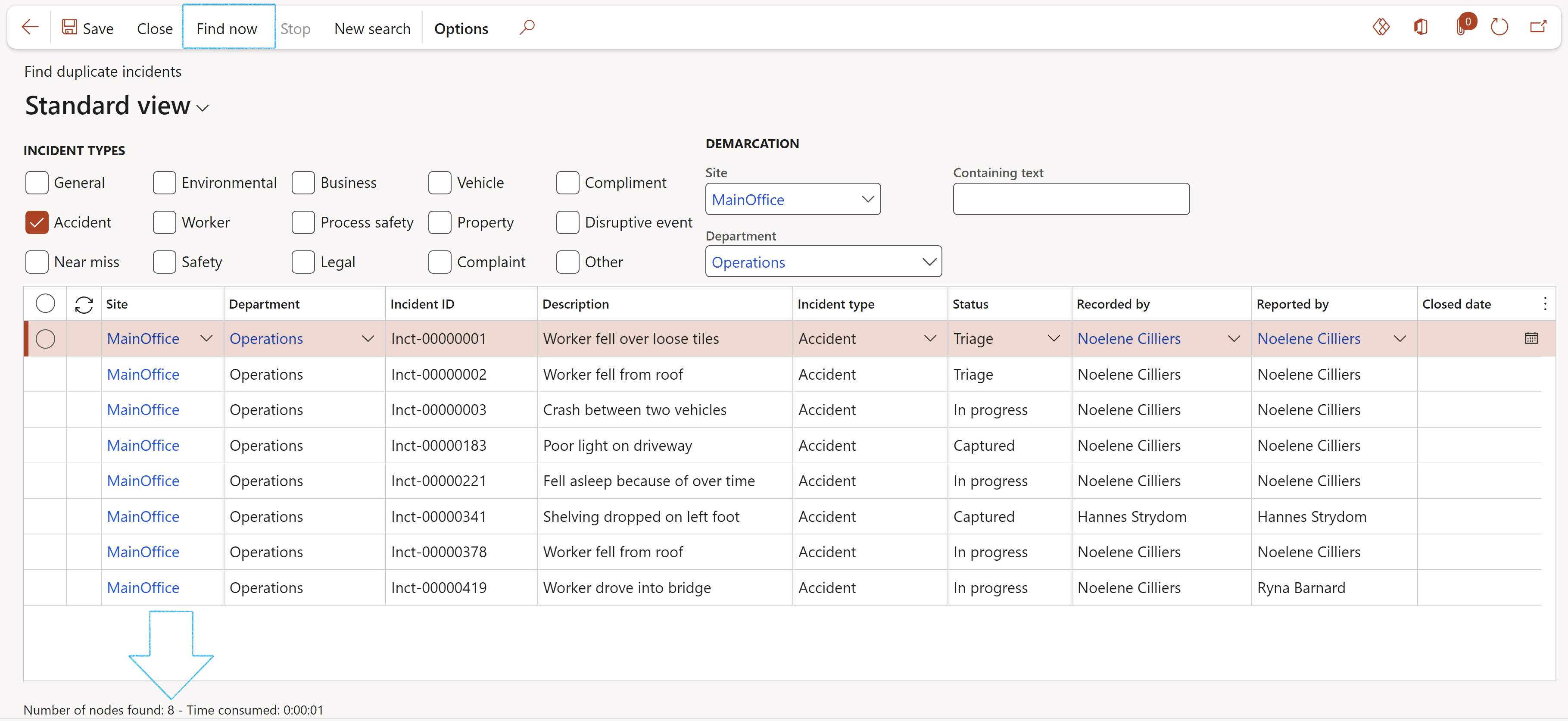
The results of the search will populate the grid
The number of nodes found will be displayed below the grid
¶ Step 34: Report of an injury
This report is a complete summary of the selected injury/incident
Go to: HSE > Incidents > Reports and inquiries > Report of an injury
- On the Report of an injury parameters form:
- Select the Incident ID of the injury that you want to see the report of, from the dropdown list
- Select the relevant Site from the dropdown list
- Select the relevant Department from the dropdown list
- Click OK
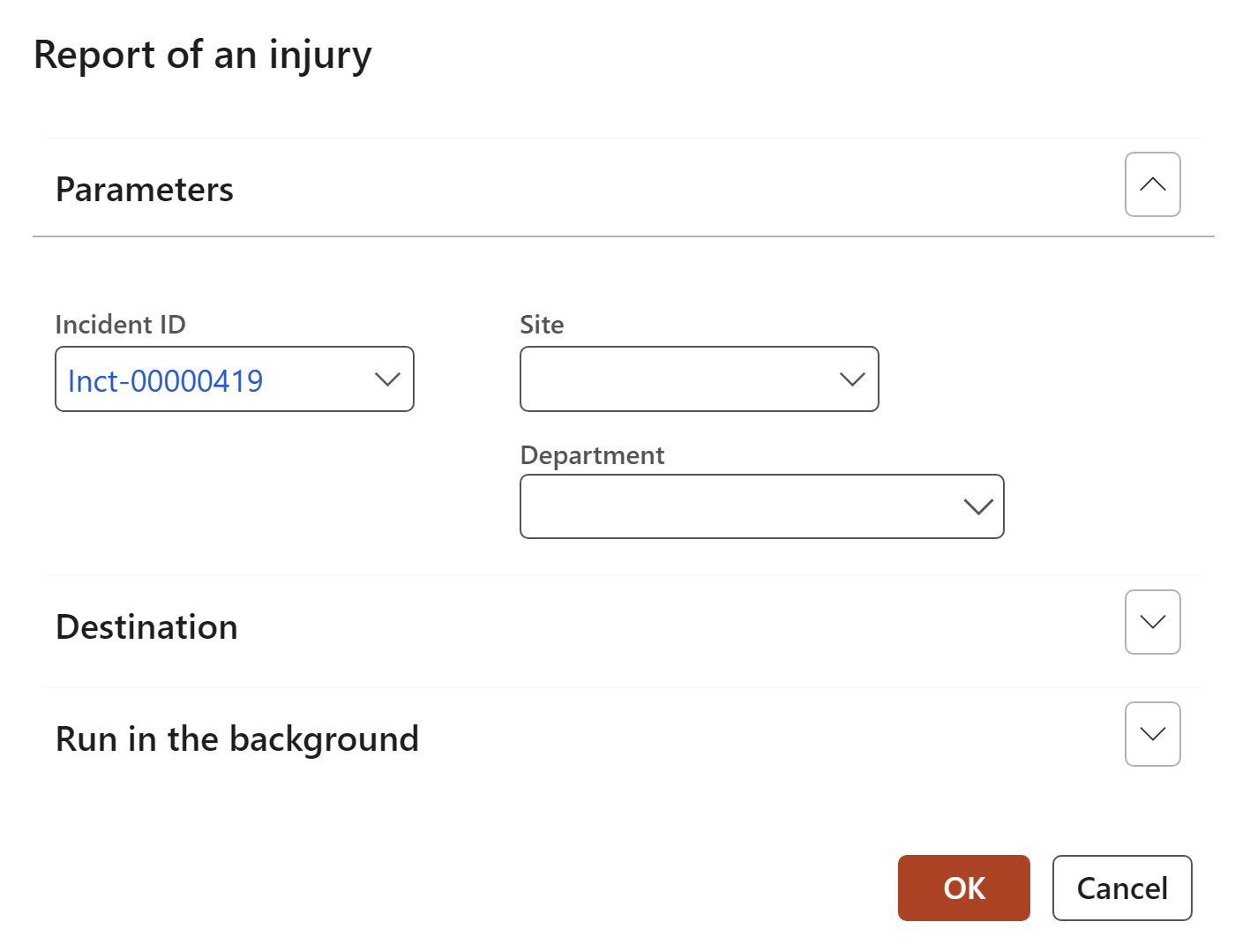
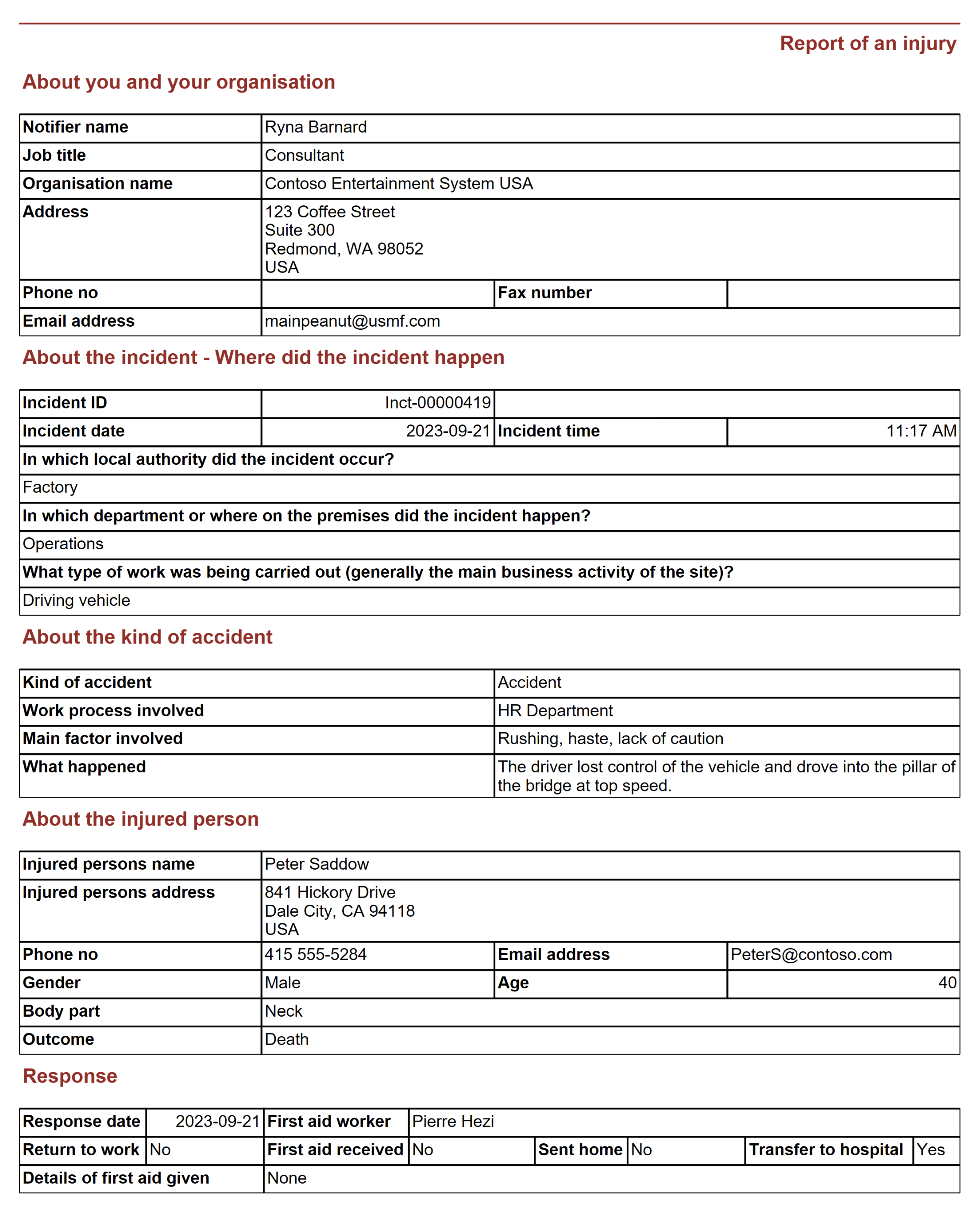
¶ Step 35: Global incident report
When an Occupational Health and Safety incident or near miss has occurred, it is important that it is reported and managed properly in order to remedy the damage and prevent recurrence.
Go to: HSE > Incidents > Reports and inquiries > Global incident report
- On the Global incident report parameters form:
- Select the applicable Year from the dropdown list
- In the Display field, elect the range of years to display
- Select the relevant Company from the dropdown list
- If you want all the Companies’ details printed in this report, select Yes under the Include all field
- The user can choose to display/not display rates for specific companies under the Hide rates for field group
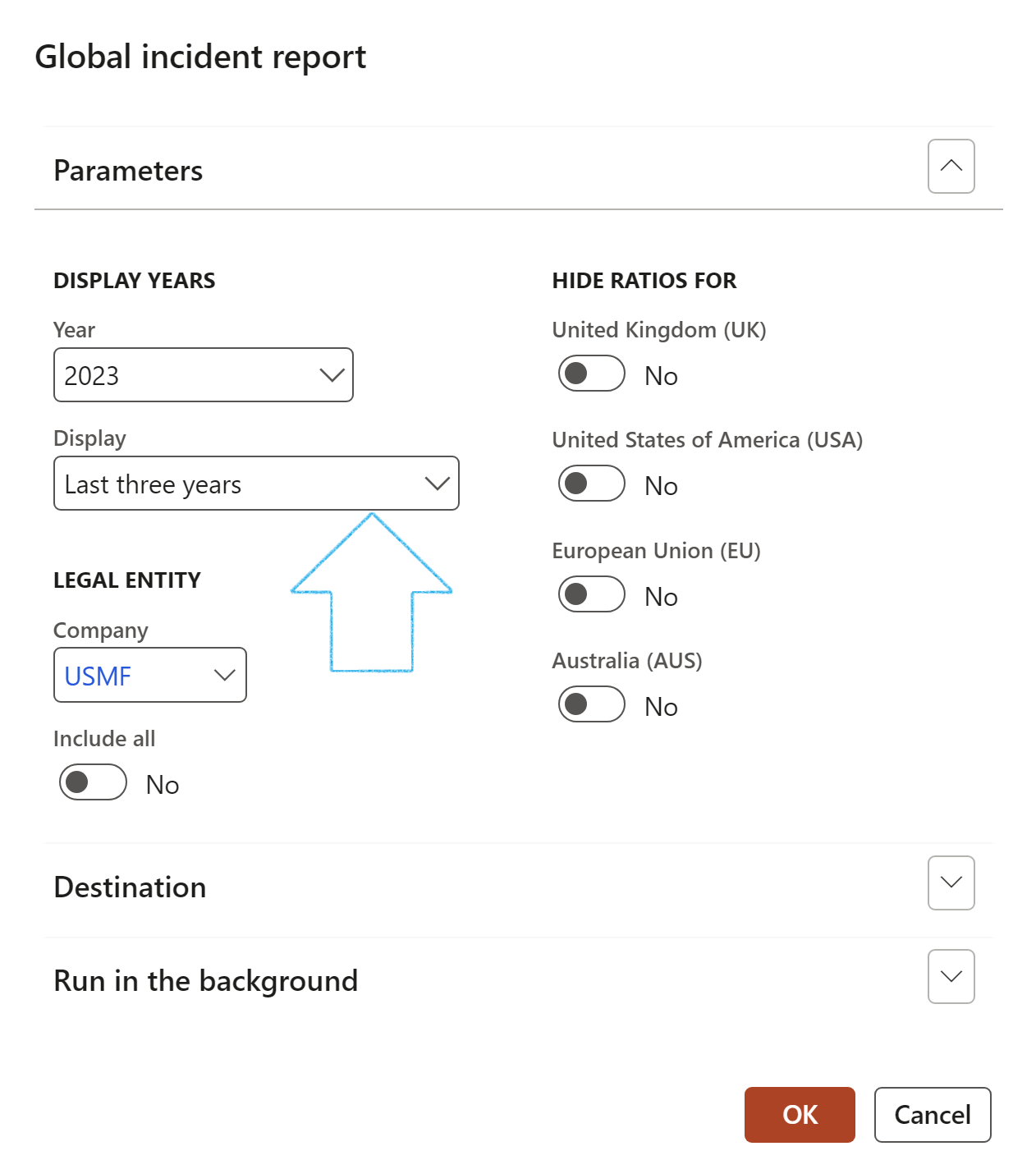
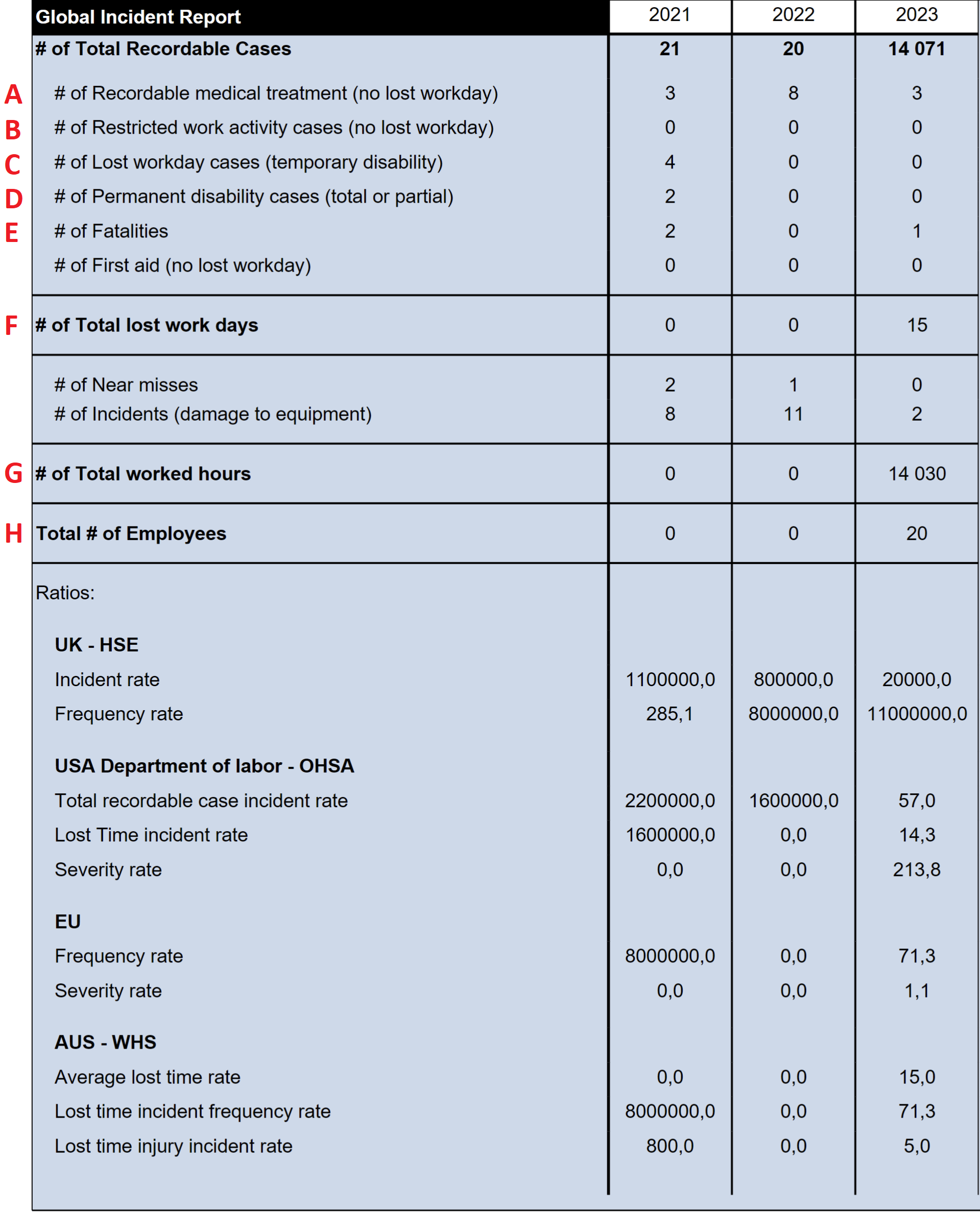
UK – HSE
- Incident rate = (A+B+C+D+E) x 100,000 / (H)
- Frequency rate = (A+B+C+D+E) x 1,000,000 / (G)
USA Department of labour - OHSA
- Total recordable case incident rate = (A+B+C+D+E) x 200,000 / (G)
- Lost time incident rate = (C+D+E) x 200,000 / (G)
- Severity rate = (F) x 200,000 / (G)
EU
- Frequency rate = (C+D+E) x 1,000,000 / (G)
- Severity rate = (F) x 1,000 / (G)
AUS - WHS
- Average lost time rate = (F) / (C) + (D) + (E)
- Lost time incident frequency rate = (C+D+E) x 1,000,000 / (G)
- Lost time injury incident rate = (C+D+E) x 100 / (H)
Statutory
Additional tailor-made reports for external reporting exist and are being expanded.
These reports can be exposed and added to the core Dynamics 365 HSE installation.




¶ Step 36: Three-year injury stats
Go to: HSE > Incidents > Reports and inquiries > Three year injury stats
- On the Three year injury stats report parameters form:
- Select the Injury or illness type from the dropdown list
- OR
- Select Yes to view All injury types
- Select the relevant Year from the dropdown list
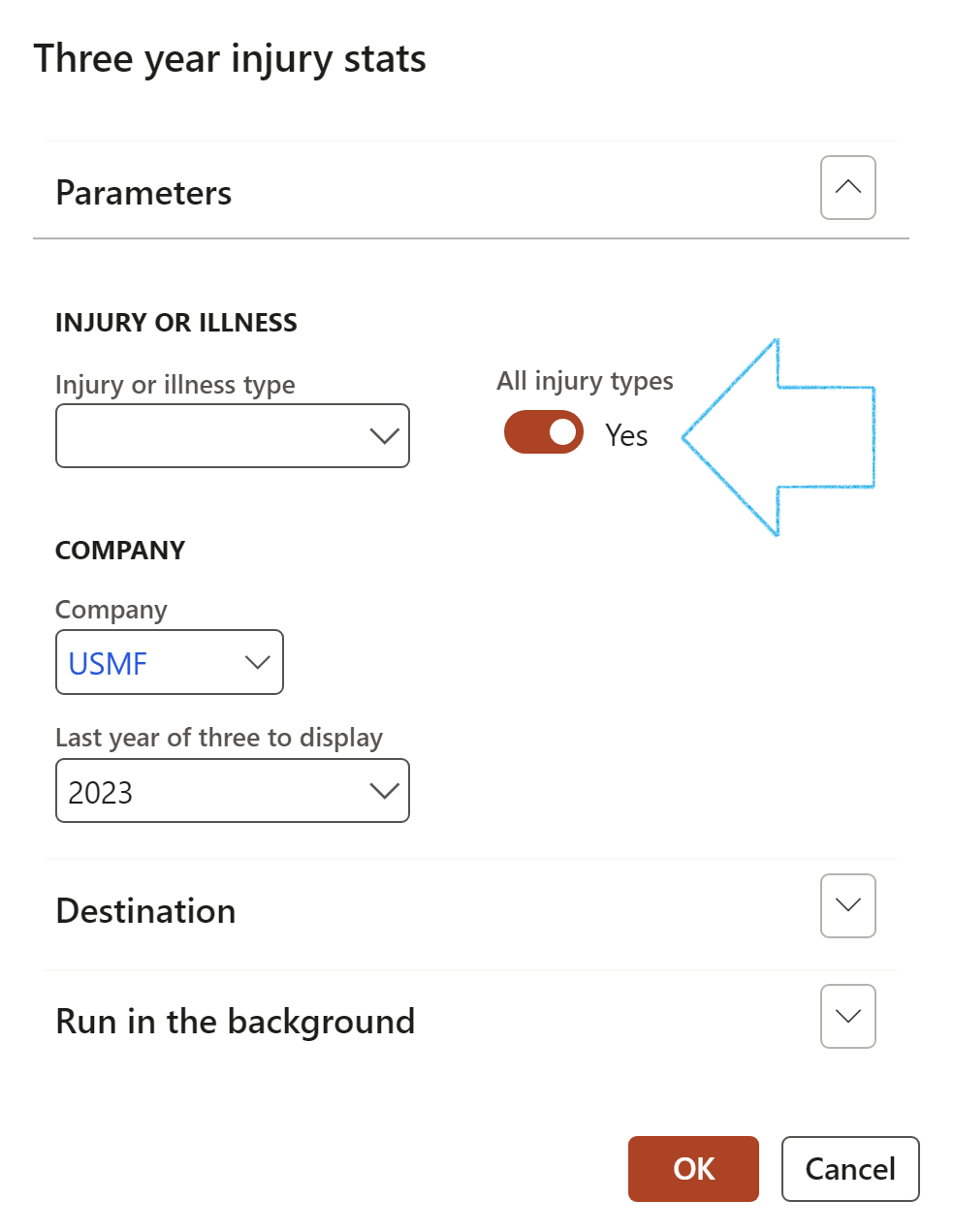
The Three year injury stats graph displays stats for three years. The Year selected on the Parameters dialog will be the last year of tree displayed on the graph.
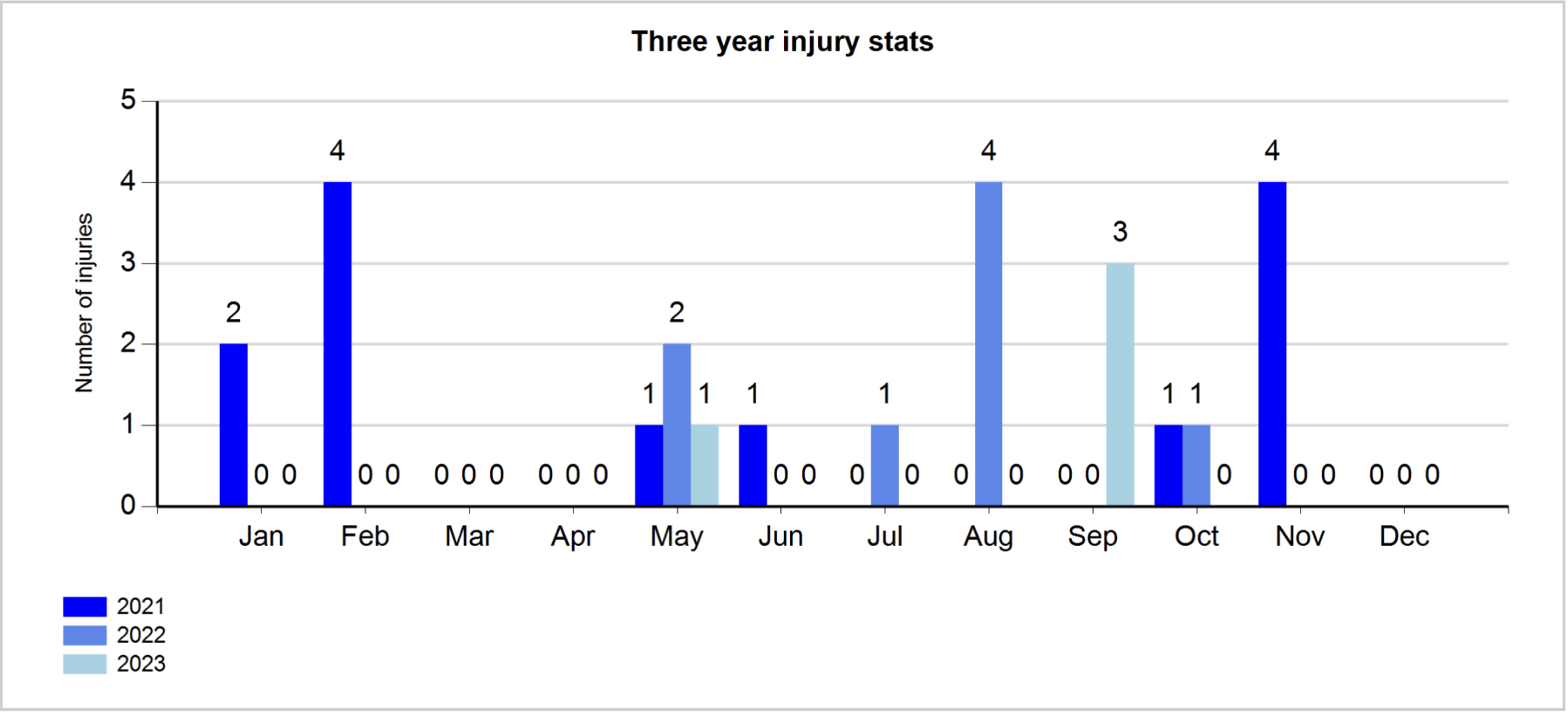
¶ Step 37: Incidents by country and severity report
Go to: HSE > Incidents > Reports and inquiries > Incidents by country and severity report
- On the Incidents by country and severity report dialog:
- Select the Year and Month from the dropdown list
- Click OK
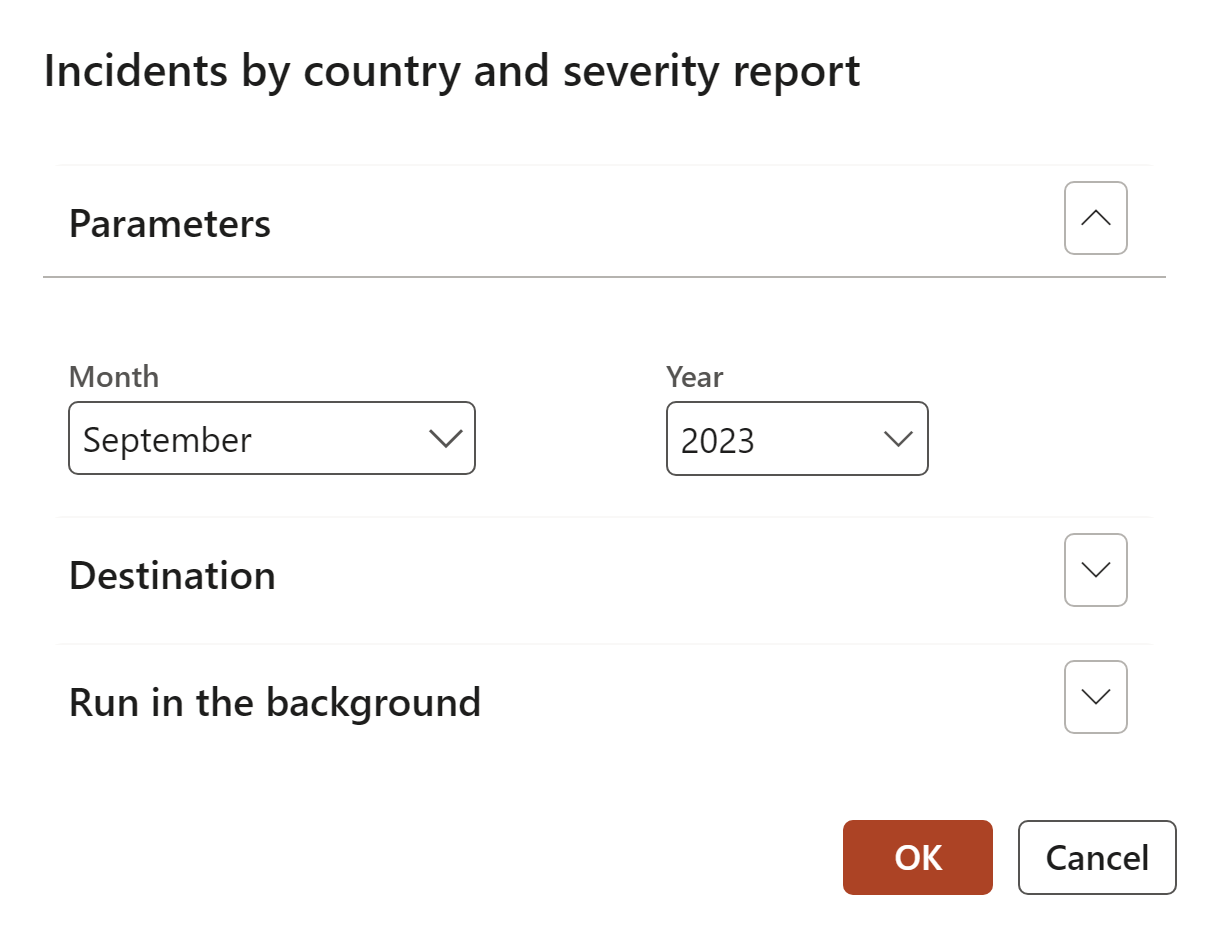
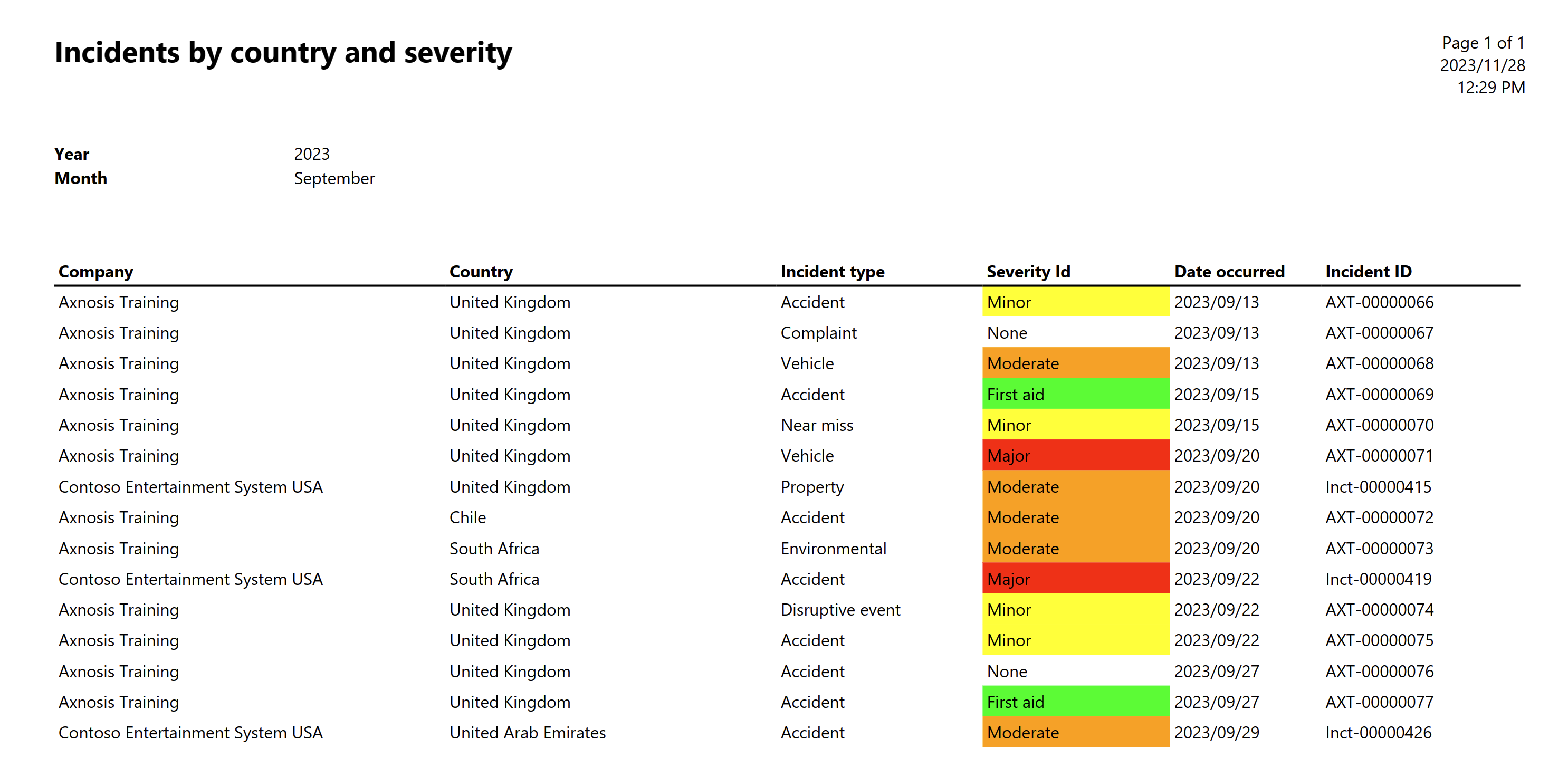
¶ Step 38: Incident graphs
Go to: HSE > Incidents > Reports and inquiries > Incident graphs
- On the Incident graphs report parameters form:
- Select the Year and Month from the dropdown list
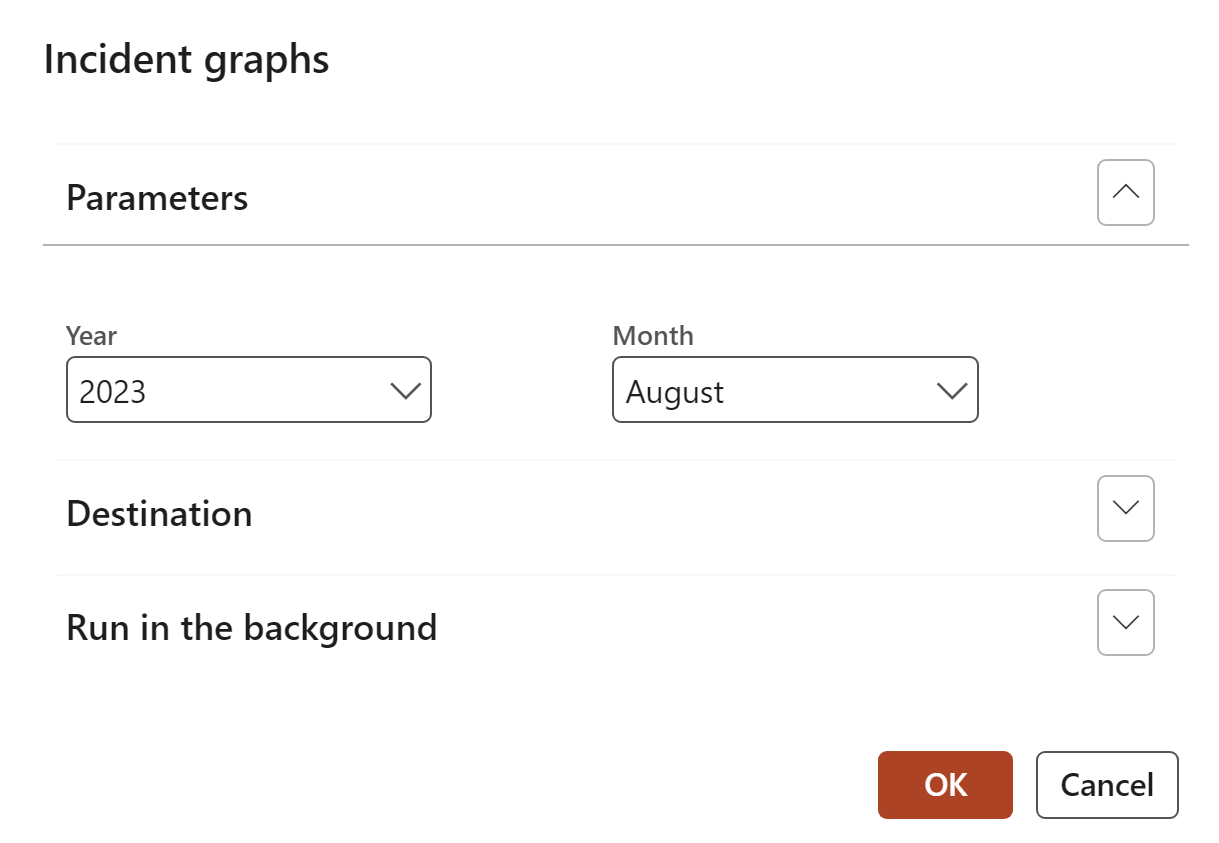
The Near misses graph as well as the Vehicle incidents global graph, displays stats for three years. The Year selected on the Parameters dialog will be the last year of three displayed on the graphs.
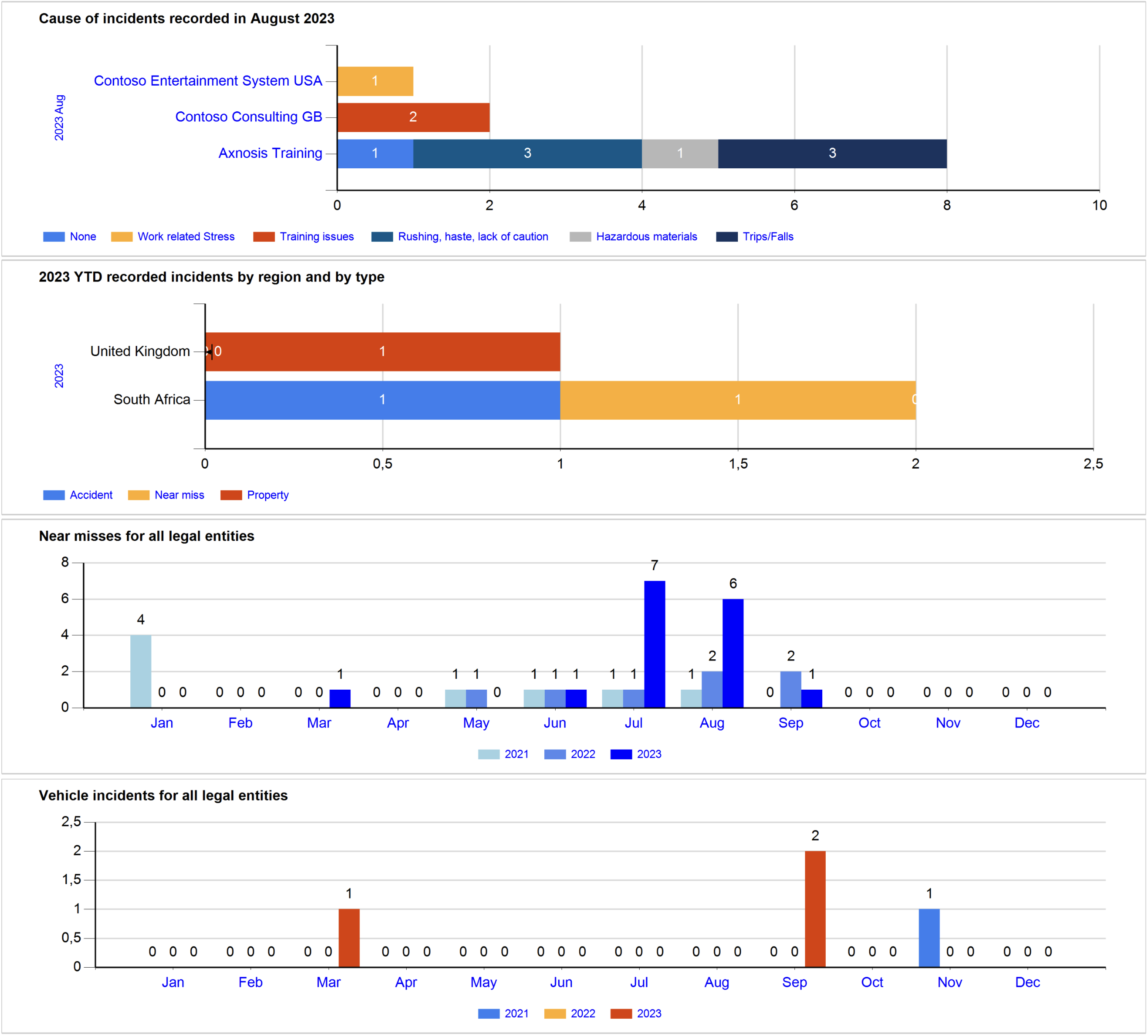
¶ Step 39: Target vs actual workspace inquiry
Go to: HSE > Workspaces > Safety management >Target vs Actual
- Use the filters to specify the data that you want to view
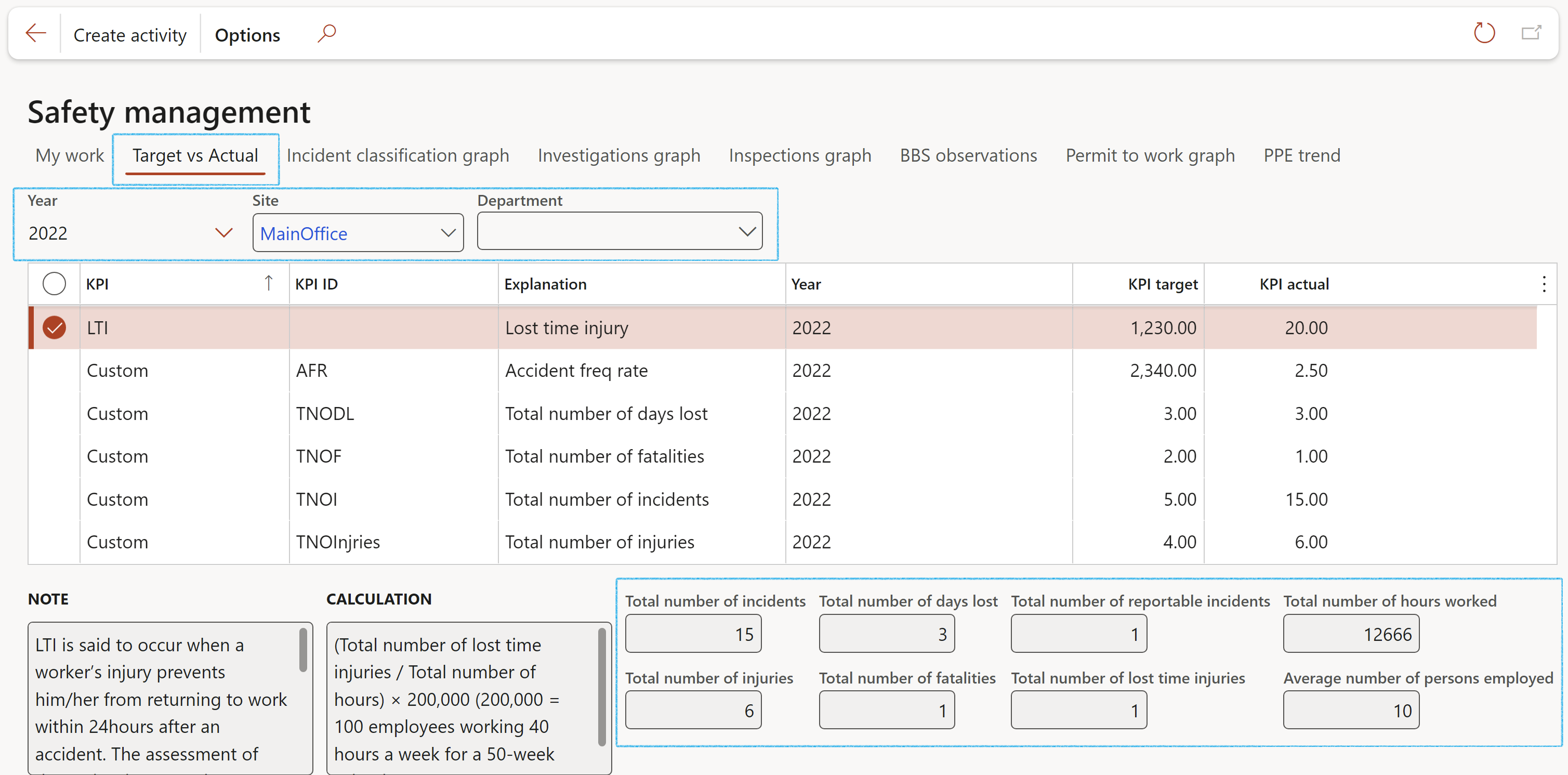
The data displayed below the grid, comes from the following sources:
- Total number of incidents: The number of incidents in the accounting period, for the selected site and department.
- Total number of injuries: The number of persons injured in all incidents in the accounting period, for the selected site and department.
- This is the number of records where the Outcome type is linked to the following results:
- Injury, no medical treatment
- Injury, First aid
- Injury, Medical treatment
- Total number of days lost: The sum of Days away from work on all Injury or illness incidents in the accounting period, for the selected site and department.
- Total number of fatalities: The number of incidents in the accounting period, for the selected site and department, where the Outcome type is linked to Fatality
- Total number of reportable incidents: The number of records on the Injury or illness incidents forms, under the injury or illness filings Fast tab, where the Was incident reported? slider is set to Yes. Where these records are linked to incidents, and the incidents are in the accounting period for the selected site and department.
- Total number of lost time injuries: The number of records on the Injury or illness incidents forms, where the Days away from work is greater than 0, and where the record is linked to an incident and the incident is in accounting period, for the selected site and department.
- Total number of hours worked: The information comes from the Hours worked form, for the accounting period and for the selected site and department. Go to: Health, Safety and Environment > Setup > Work force > Hours worked.
- Average number of persons employed: The information comes from the Hours worked form, for the accounting period and for the selected site and department. Go to: Health, Safety and Environment > Setup > Work force > Hours worked.
¶ Reference table
Definitions
| Incident: | An unplanned event resulting in, or having potential for injury, ill health, damage or other loss. Incidents may involve actual or potential injury/illness, property/environment damage, motor vehicle accidents or near-misses. |
|
Hazard: |
Any source or situation with a potential for harm in terms of injury/illness, damage to property/plant/equipment, or damage to the environment. |
|
Near misses: |
Near Misses may be incidents that involve very minor losses or no loss as such, and when there is no injury/illness involved. Near-misses, however, highlight workplace hazards and the need to initiate corrective action, e.g.: tripping without falling. |
|
Staff: |
Staff refers to any persons employed by the Institute, whether employment is ongoing, fixed term, part-time or casual/sessional. |
| Supervisor: | An Institute Staff member with supervisory responsibilities, either of students or other staff. Staff supervisors will include Commercial Managers, Support Managers, and Executive Officers. Student Supervisors will include teaching staff, as well as the listed staff supervisors. |
| Risk: | A risk is the likelihood that exposure to a hazard will result in injury or disease. |
| Risk assessment: |
The process of analyzing all of the risks associated with hazards and evaluating them to determine steps for risk control and priorities. Risk Assessment considers two (2) main factors:
|
|
Risk score: |
The risk score is the number allocated following risk assessment, which describes the level of risk, ranging from H (very high risk) to L (very low risk). The risk score is also used to identify the priority and timeframe of response to the identified hazard. |
|
Notifiable incident: |
Notification is required to the Victorian Work cover Authority where an incident at a workplace or equipment site results in:
|
| Notifiable dangerous occurrence: |
A Dangerous Occurrence is an incident at a workplace which may seriously endanger the health and safety of people in the immediate vicinity:
|